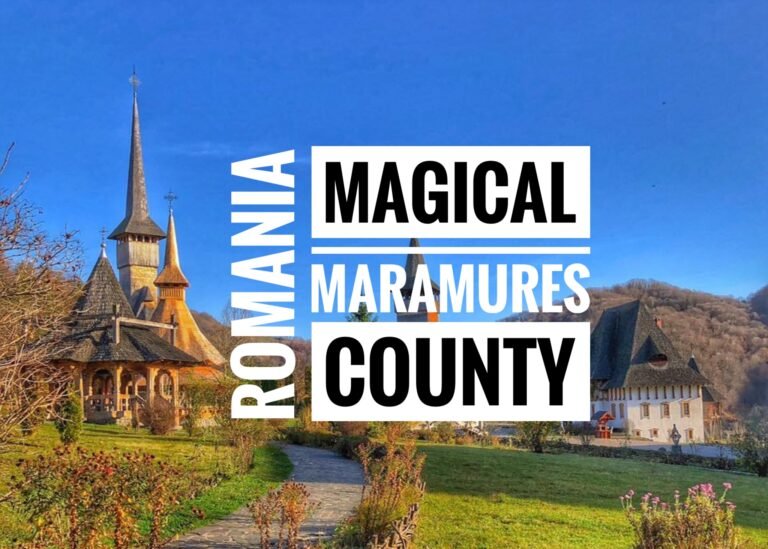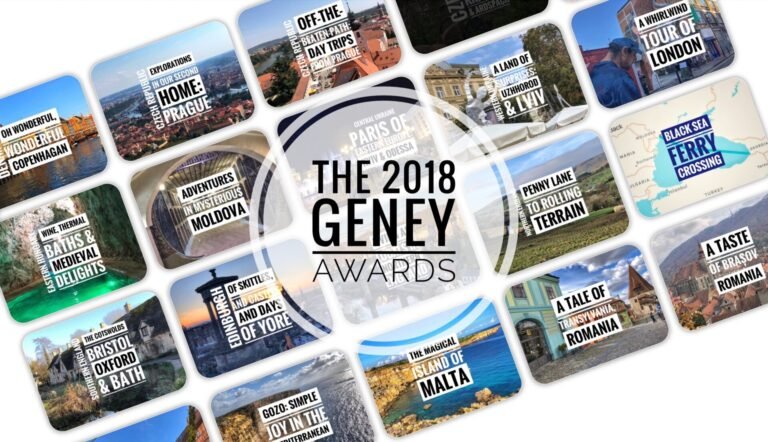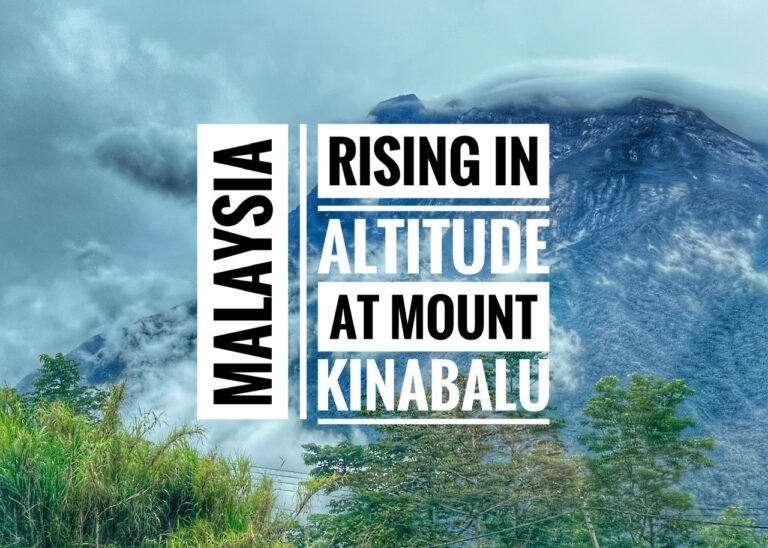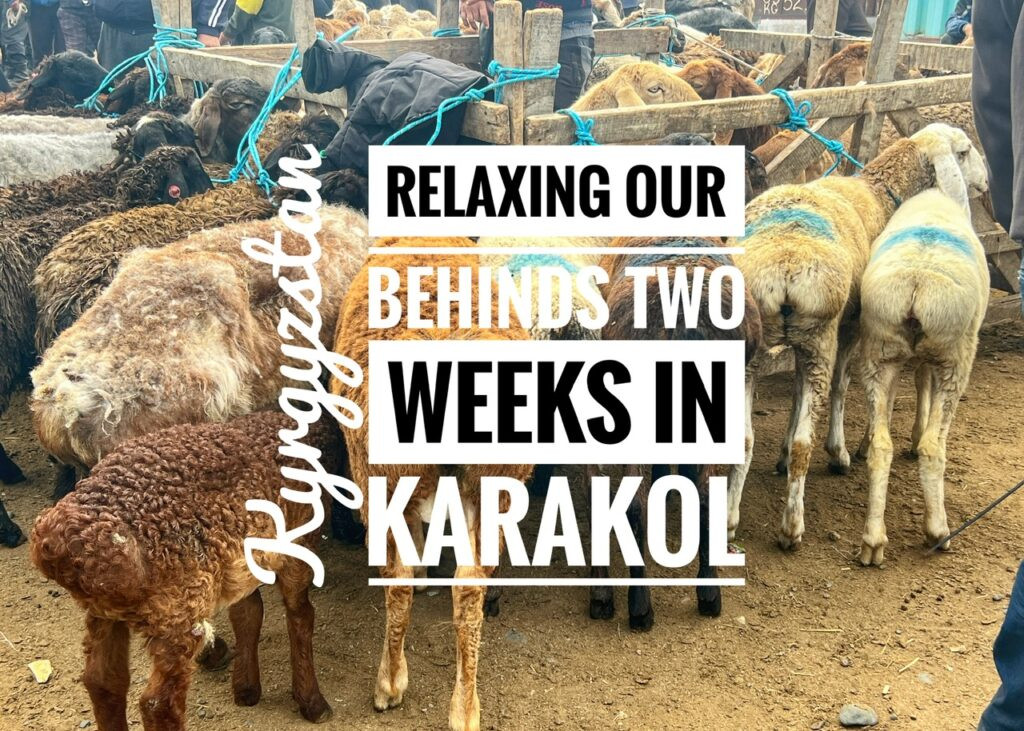
From Almaty to Karakol
From Almaty, it was time to traverse to our next location in our ‘Stan a Plan, which would be a two-day, 12.5-hour journey to Karakol, pausing overnight in Kyrgyzstan’s capital of Bishkek. Yes, to go east, of course, you gotta go west first. Oh yes, we are indeed moving again…
To leave Almaty, we traveled to the (quite out of the way) Sairan Bus Station (Avtovokzaly) to buy our tickets three days in advance. Although we tried to buy them online, because many bloggers claimed you could, this was not correct information because the bus company online only took Kazakh credit cards. However, it was a very good thing we did buy in advance because every seat on the 8:00 bus was filled. Note: There are also four other buses per day to Bishkek at 10:00, 12:00, 14:00 and 18:00. We read to take the first, or last bus in order to avoid long lines at the border, which at least in our case, was accurate.
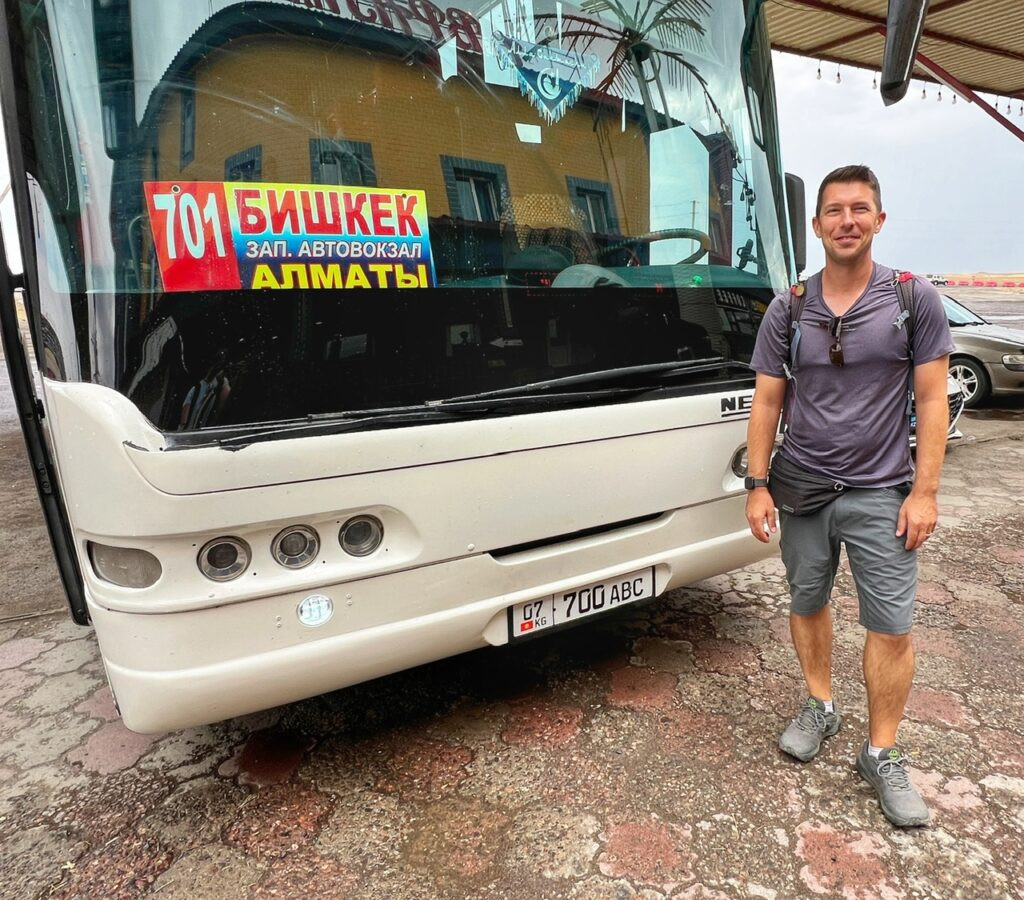
This is why it’s helpful to know Cyrillic in these countries. To locate your bus! And yes, you can survive without it. You just have to be a lot more vocal!
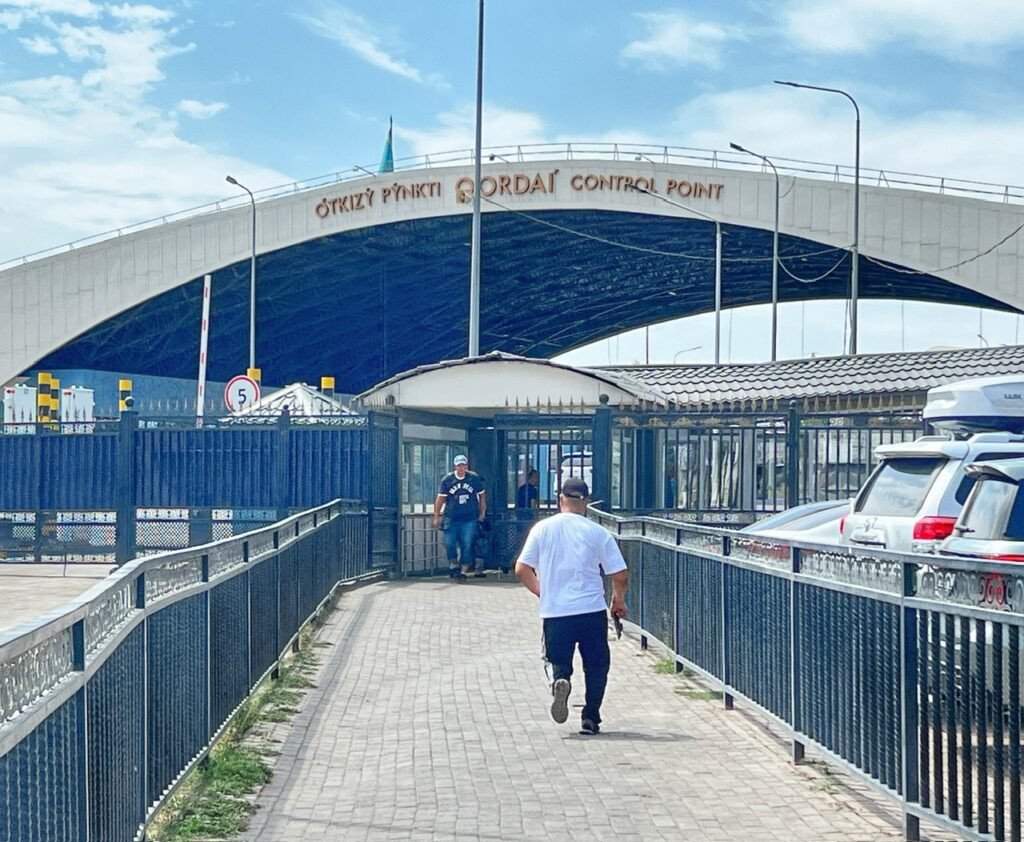
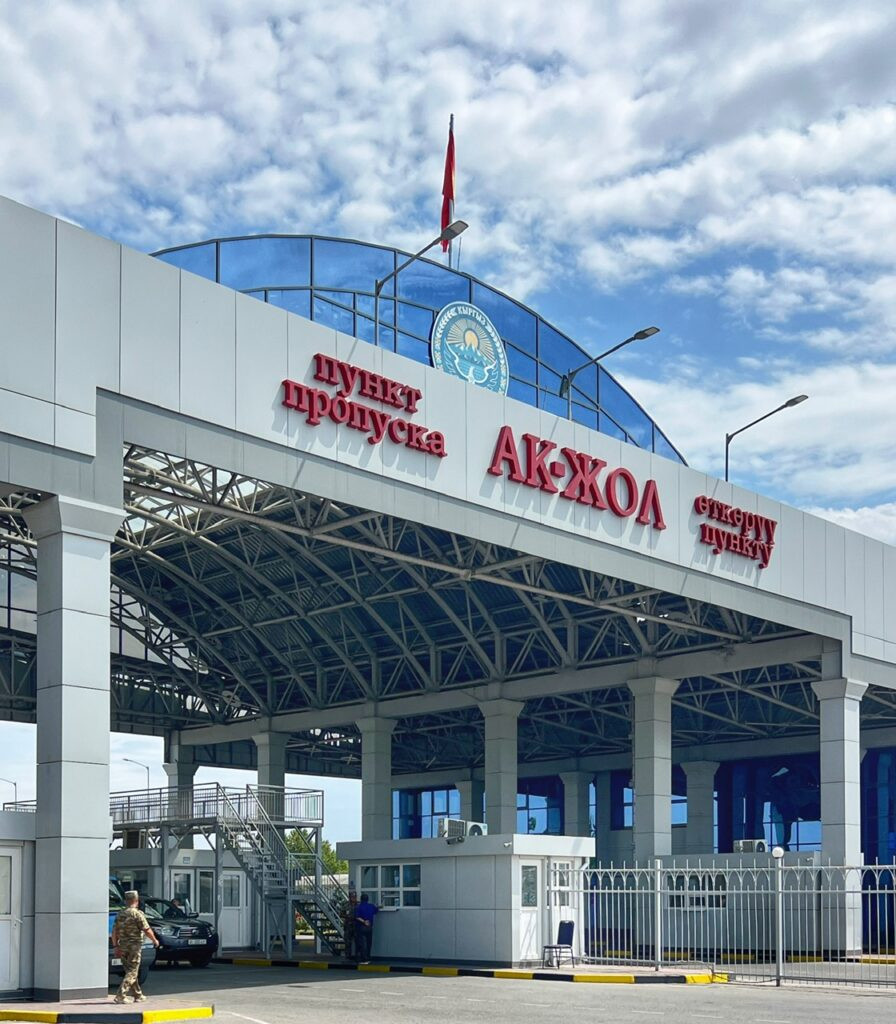
After three hours on a normal-sized completely adequate bus, we arrived to the Korday border station on the Kazakh/Kyrgyz border, which is frequently used and seemed straightforward enough to navigate. When we arrived, we collected all belongings and shuffled through the Kazakh side first, got stamped out….walked about 300 meters(?), and then arrived to the Kyrgyzstan side, where once again as US citizens we got stamped in with no visa…this time for 60 days. We are truly so privileged, we are reminded when we saw everything our Colombian friend had to go through.
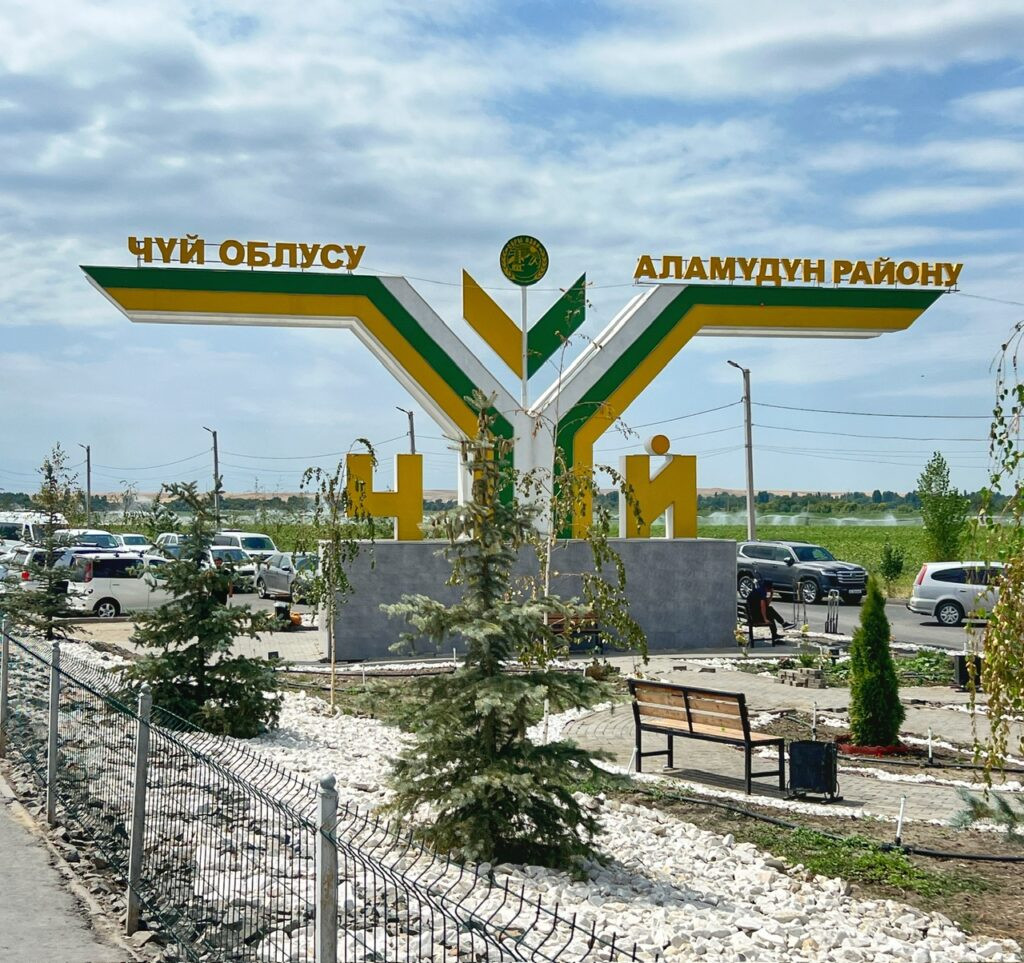

Welcome to Kyrgyzstan! Although unfortunately this sign actually announces our arrival to the Chuy Oblast, or “state” of Kyrgyzstan, which always feels a bit anti-climactic. As if we even know our Kyrgyz states…yet.
According to one of our favorite YouTube channels, Geography Now, Kyrgyzstan is sorta like the little, less responsible, brother to diplomatic and mature Kazakstan. They’re nomadic, they’re more fun, and they spend most of the time in the mountains partying and dancing. Sounds like we’ll fit right in. Haha.
After you get stamped in, you have to walk through a gauntlet of taxi drivers wanting to take you the final 30 km to Bishkek. If you are impatient, you could do this, for about $12. Or, you could wait for the Almaty bus to come through and all the rest of the passengers, which took about 30 minutes….longer obviously in some cases depending on the wait at border control. There is also the option to take a local bus. But we decided to wait it out.
Also in this area, there are plenty of people wanting to sell you SIM cards. While we needed one, because our Gig Sky data unfortunately doesn’t work in Kyrgyz, we don’t really trust SIM cards not sold by authorized dealers. (We later picked ours up at Beeline…$6 for the month).
We arrived to the Northeast bus station, where no ATM’s were working, so in hindsight we should have tried to take out money at the border. Fortunately, the small and stuffy station had Wifi that worked enough for us to be able to call a Yandex, the Russian taxi app which luckily also works in this Stan and allowed us to pay by credit card.
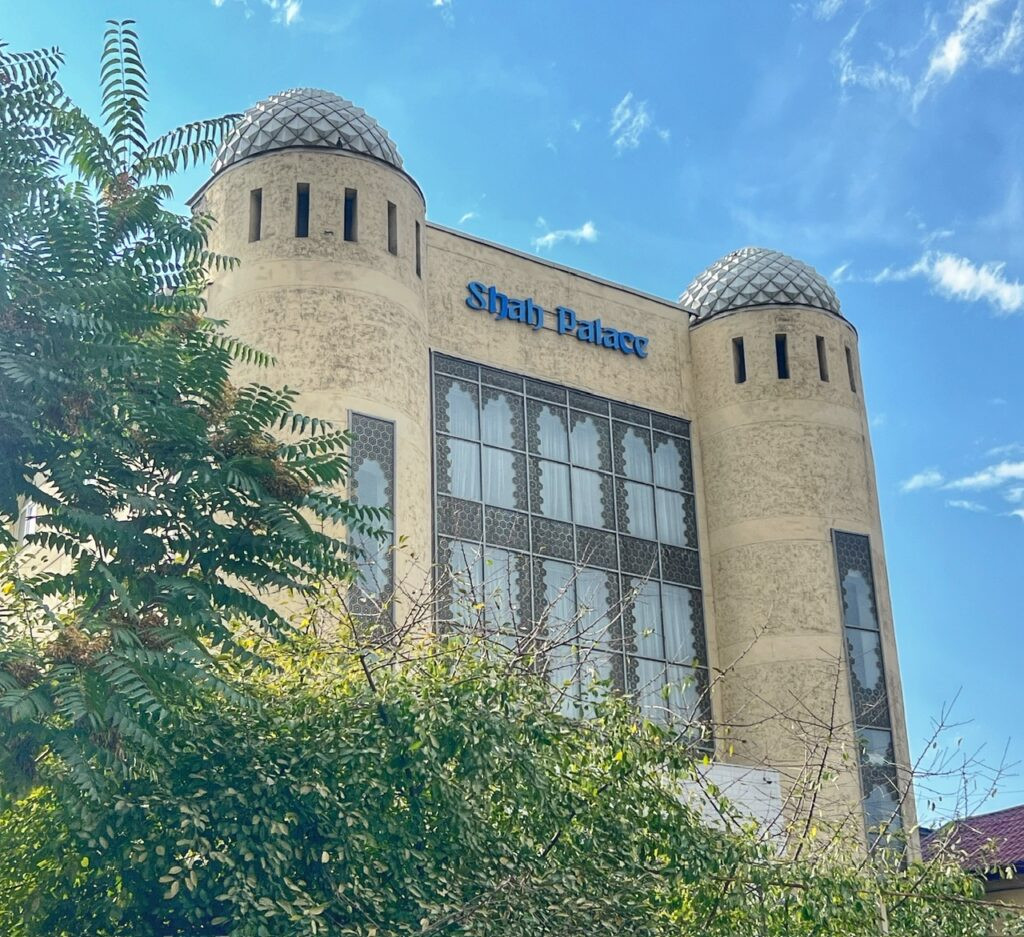
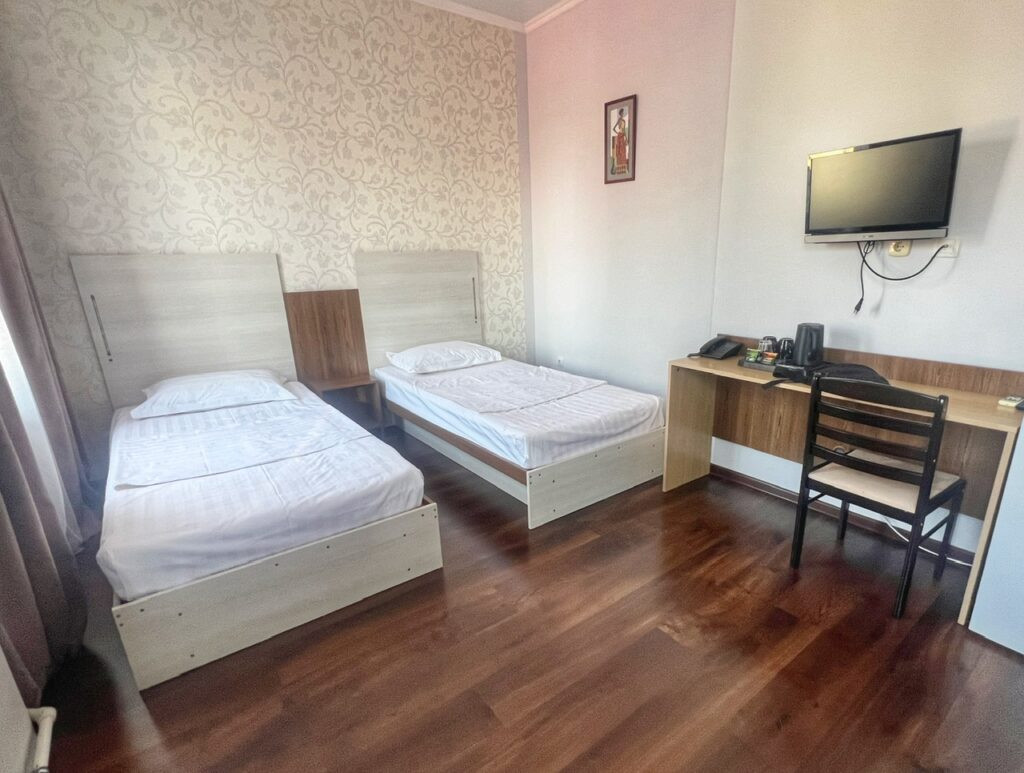
35 minutes, and $4.80 later, we arrived to our Palace for the night….Shah Palace, that is, which seemed slightly misleading based on our room. We bought this room using our $50 hotel credit we get annually from the Chase Sapphire Preferred card, so it ended up costing us $10. Had we actually paid $60 for this mediocre room and these springy mattresses, we probably would have been a bit grumpy.
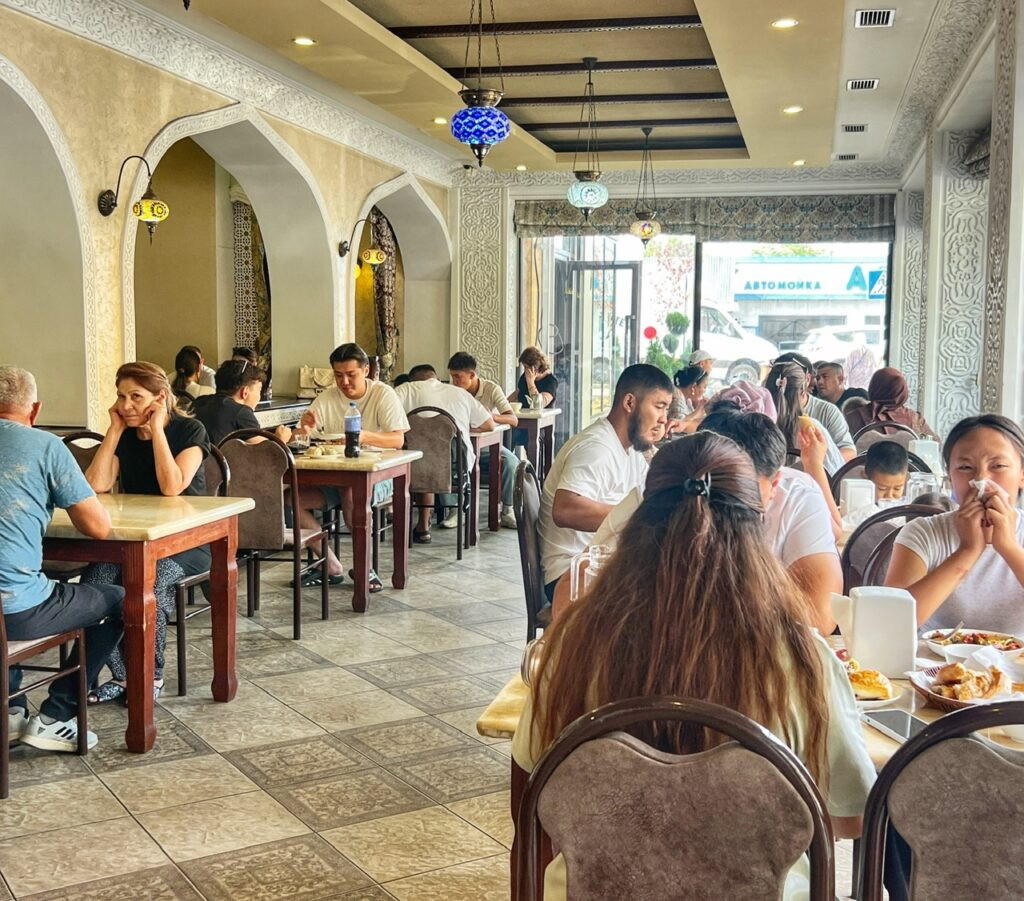

After getting settled in, we went to a nearby restaurant called Cafe Faiza, which was packed to the brim with locals at 5:22 p.m. Hehe. Our kind of people…eating dinner at what we formerly called the “blue hair” hour. Now, with 14-hour intermittent fasting becoming trendy and apparently in this culture, we fit right in. Take that…..(Spaniards.)
We made sure to find a restaurant that had an English menu, and some vegetarian options, so our first Kyrgyz meal was as follows:
- Chicken Kebab ($3)
- A plate of potato manti (pierogi type noodles stuffed with mashed potatoes and drizzled with butter) ($2)
- Funchoza salad: cold cellophane noodles mixed with meat slices (Greg thinks mutton), various veggies, seasonings and soy sauce, which is very popular in Central Asia ($2)
- Tomato salad ($2) (not-pictured)
- A pitcher of warm very sugarfied, Pomegranate juice ($1), which had high ratings amongst the reviews. We disagreed.
So, all in all, it was very affordable at $10, and filled us up with some comfort-type food, but certainly not the most mind-blowing meal we’ve ever had.
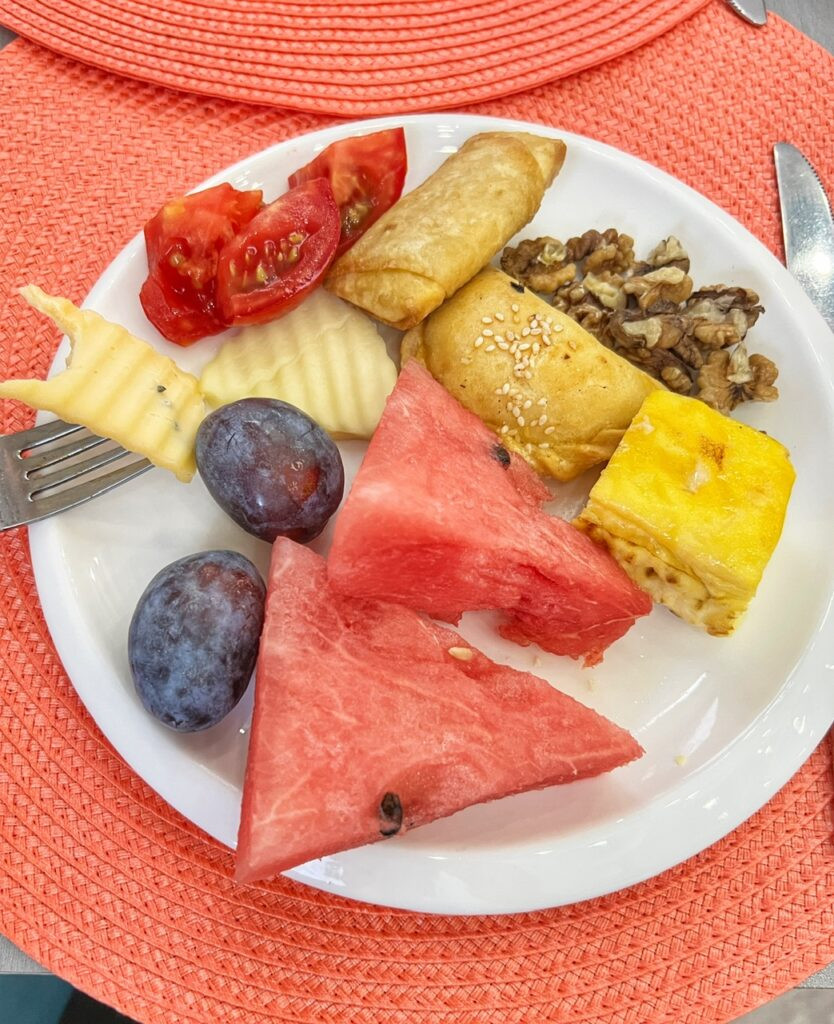
Our included breakfast buffet at The Palace the next morning, which made the deal a bit more fetching!
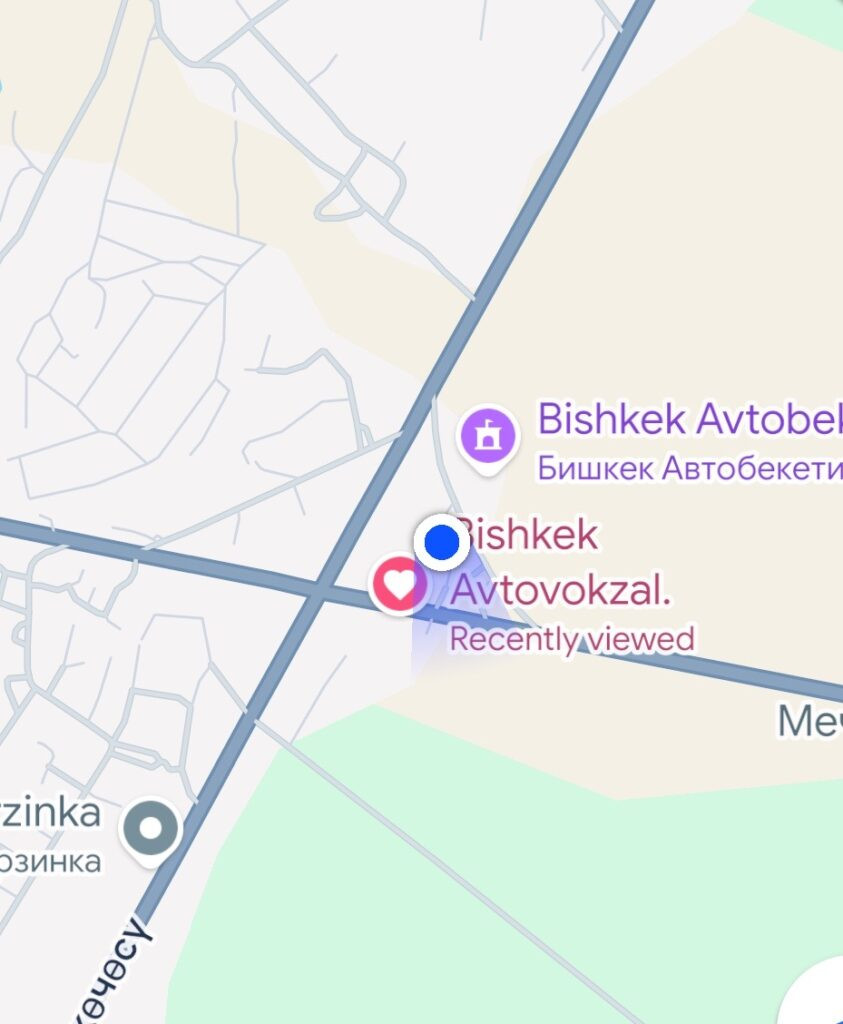

From The Palace, we took another $5 Yandex back to the northeast bus station…not west…as some blogs out there also say! This station is now closed.
It was here we were immediately targeted as tourists looking for a 7-hour lift to Karakol. Hmmm…did seeing the sight of us…presented as the usual backpack sandwiches give it away? We had to wait about 20 minutes for the marshrutka to fill up, a term given to the shared mini-vans found all over republics of the former Soviet Union. Inside we found about half tourists, and half locals and then paid the absurdly affordable price of 3200 Kyrgyz Som, or less than $6/each.
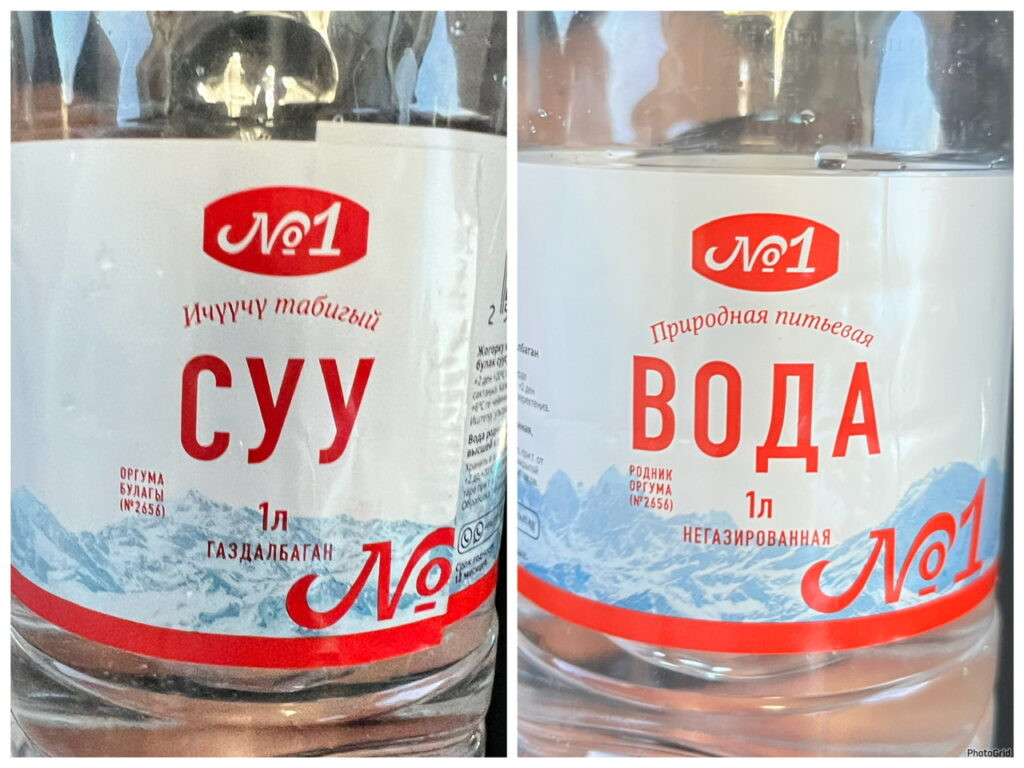
To occupy ourselves for the next 7 hours, we did the usual…podcasts, writing, and photo editing, as well as checked out the Kyrgyz and Russian labels found on each side of this water bottle. Both are in Cyrillic, the Kyrgyz is incredibly similar to Turkish.
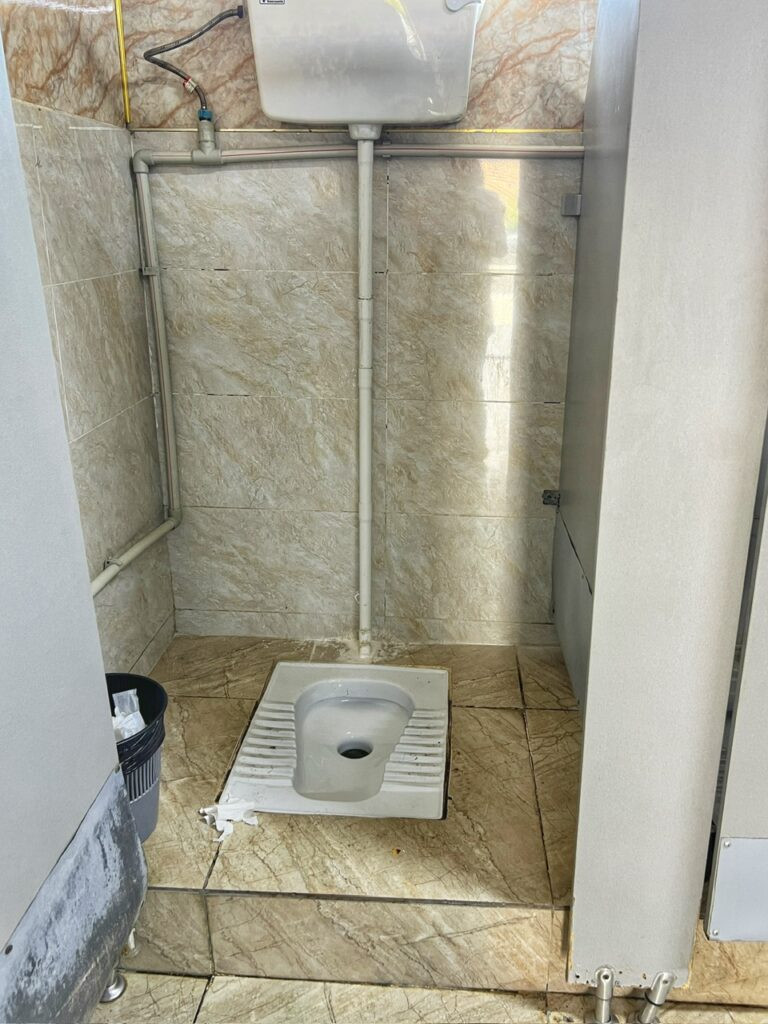
We also, of course, made stops so Mandy could work on her thigh muscles…(yep, back to this…)
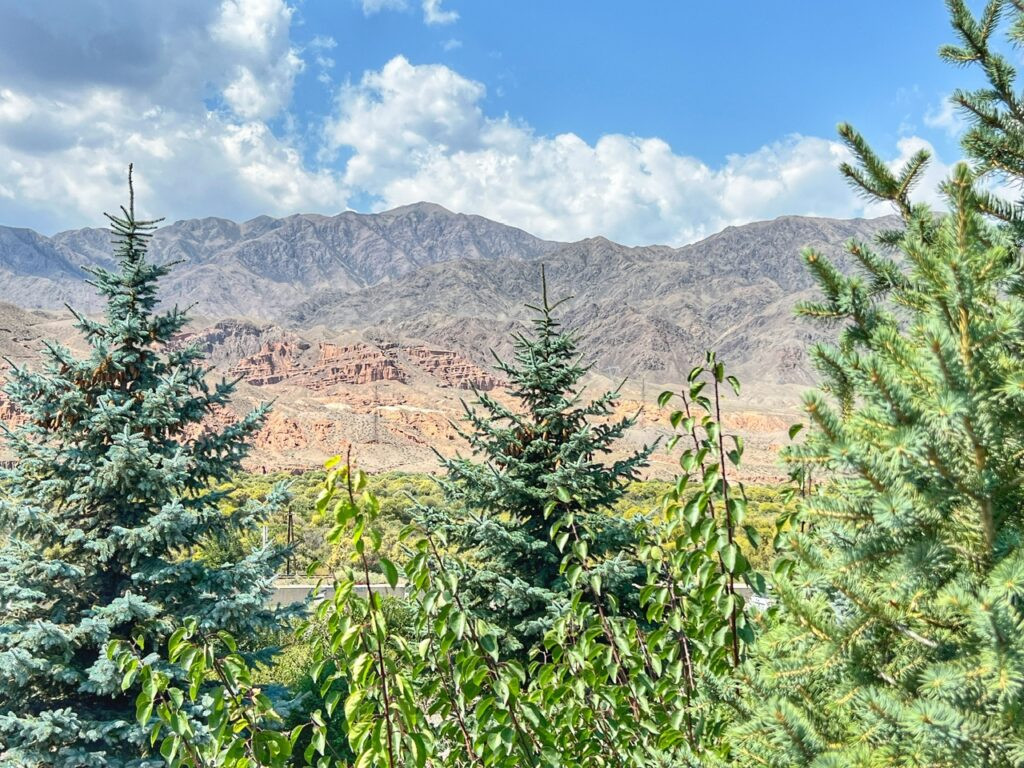
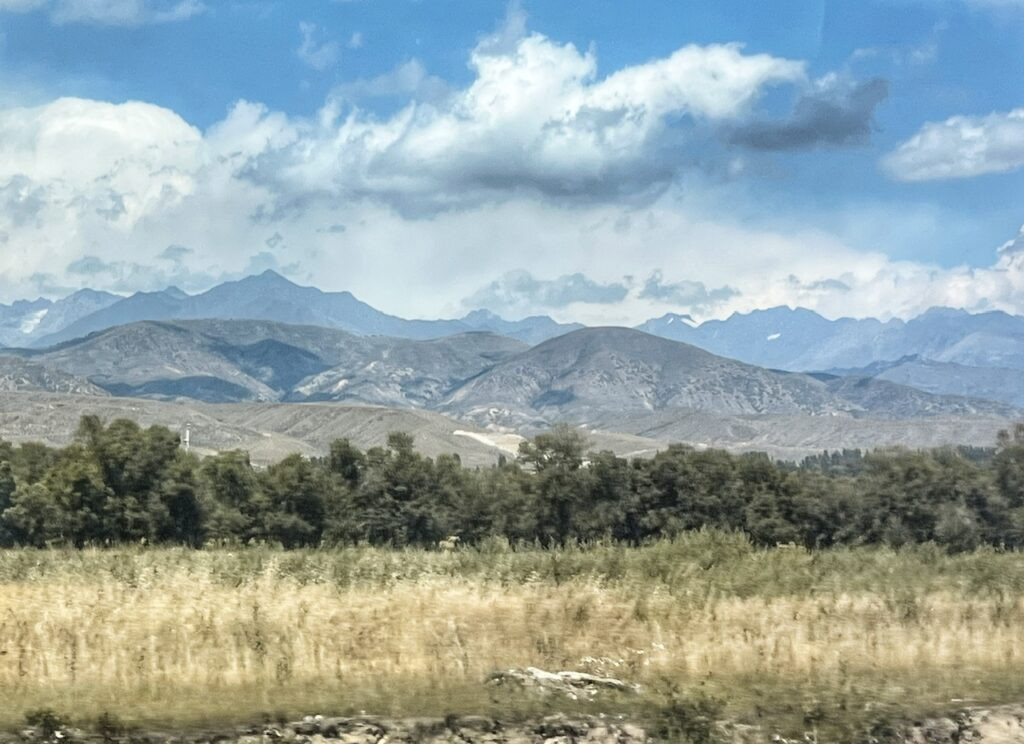

…and enjoyed the stunning mountain scenery, as well as the drive alongside Issyk-Kul, meaning Warm Lake, which is the second largest alpine lake in the world after Peru/Bolivia’s Titicaca at 182 km long and 60 km wide. It is called this because, despite being surrounded by the Tian Shan mountains, the lake never freezes thanks to mild salinity and underground thermal springs. It was a key stop along the Silk Road, with caravan routes running along both shores.


Naturally being a less developed country, we would also encounter miles and miles of unpaved road which created some productivity and nap destroyers, but all in all, the road was decent and it’s clear that when this is finished, it will greatly improve the route from Bishkek to Karakol. These types of blue-shuttered house along the route were abundant.


At least there was always something to gaze at! And seven hours later, we arrived!! Welcome to Karakol!!! 🙂
Eating in Kyrgyzstan…as people who really don’t do much red meat
When we first determined we were coming to “The Stans,” we were definitely a bit curious as to what we’d be chowing down on. After all, Central Asian cuisine is notorious for being a bit….carnivorous, including less western options of horse and mutton. Since neither Greg nor I are big red meat eaters, we were surprised to arrive to Karakol and learn that this part of the country is actually quite unique and varied in its offerings, including loads of flavorful vegetarian options, thanks to it being a vibrant crossroads of Dungan (Chinese Muslim), Kyrgyz, Russian and Uyghur cuisines.
We were also delighted to learn that Kyrgyz food is quite affordable, both in restaurants and in the markets! This is definitely proving to be a budget friendly destination. This section contains some of the things we ate and drank, through cooking, shopping and the few restaurants we checked out….
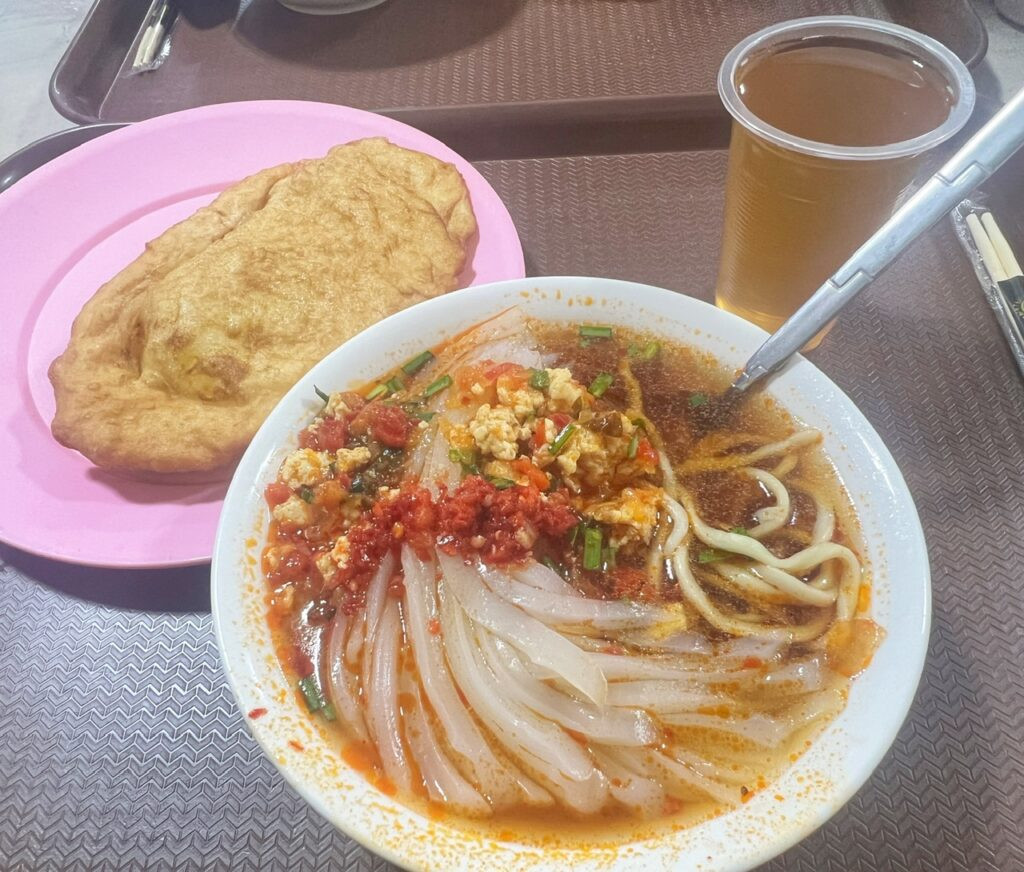
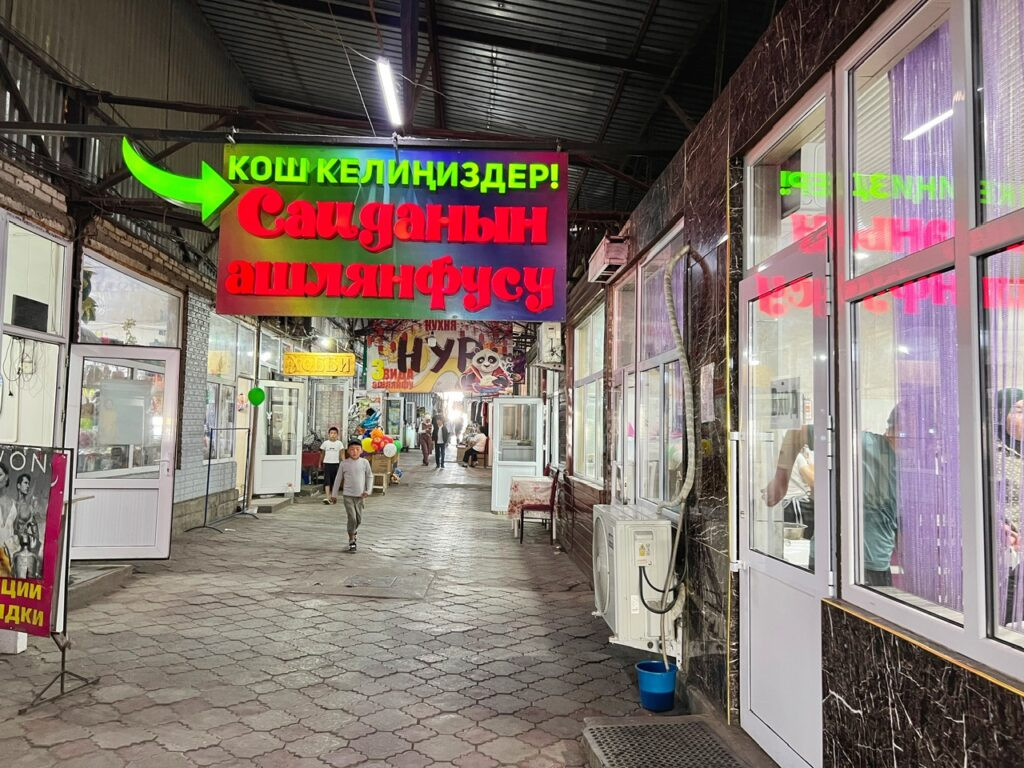
Without a doubt, the gotta-have-it dish, which happens to be vegetarian, is Ashlan-fu, which is Karakol’s signature cold noodle soup, best found in the easy-to-miss, “Ashlan-fu Alley,” pictured above. This street food-friendly Dungan (Chinese Muslim) dish is a cold broth made with vinegar, chili, garlic, two types of noodles, and fresh herb toppings. To toss in a Russian twist, it’s usually eaten with Piroshki, fried buns stuffed with potato, and a side of peach tea, all for about $1.70/meal.

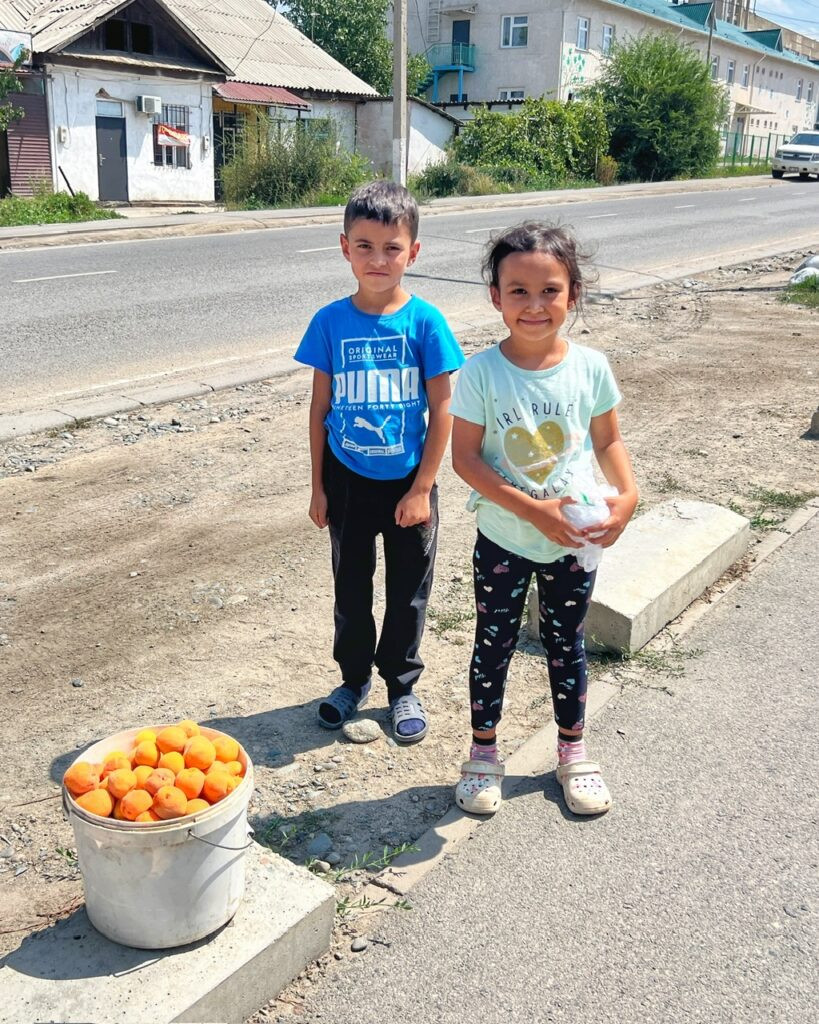
Arriving in the summer had some great advantages including the abundance of affordable fresh fruits and vegetables. Also, Central Asia is the birthplace of stone fruits, and we learned very quickly that it has some of the juiciest nectarines, plums, peaches, and apricots we’ve EVER had….
Did you catch that last word? Yes, apricots. In Karakol, they were plump, succulent and actually delicious, unlike the bland and lackluster varieties we’ve had pretty much everywhere else on earth. We also couldn’t resist these two cuties who were selling them on the sidewalk for the quite affordable price of 50 Som for a bag of about 15 ($.57).
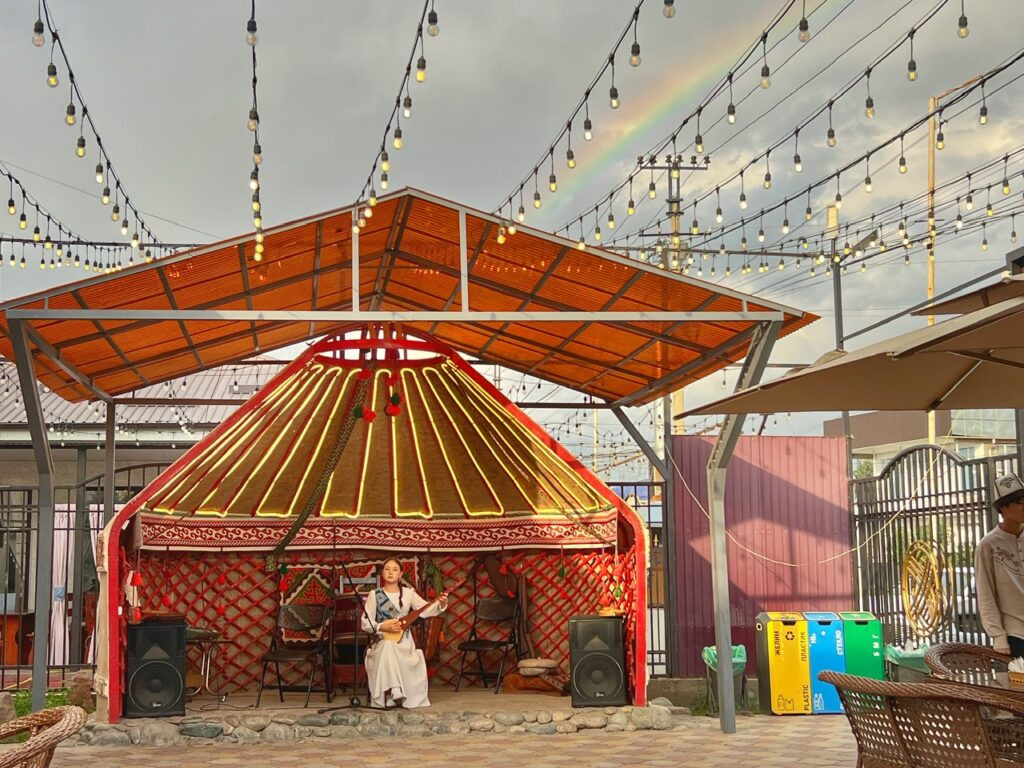
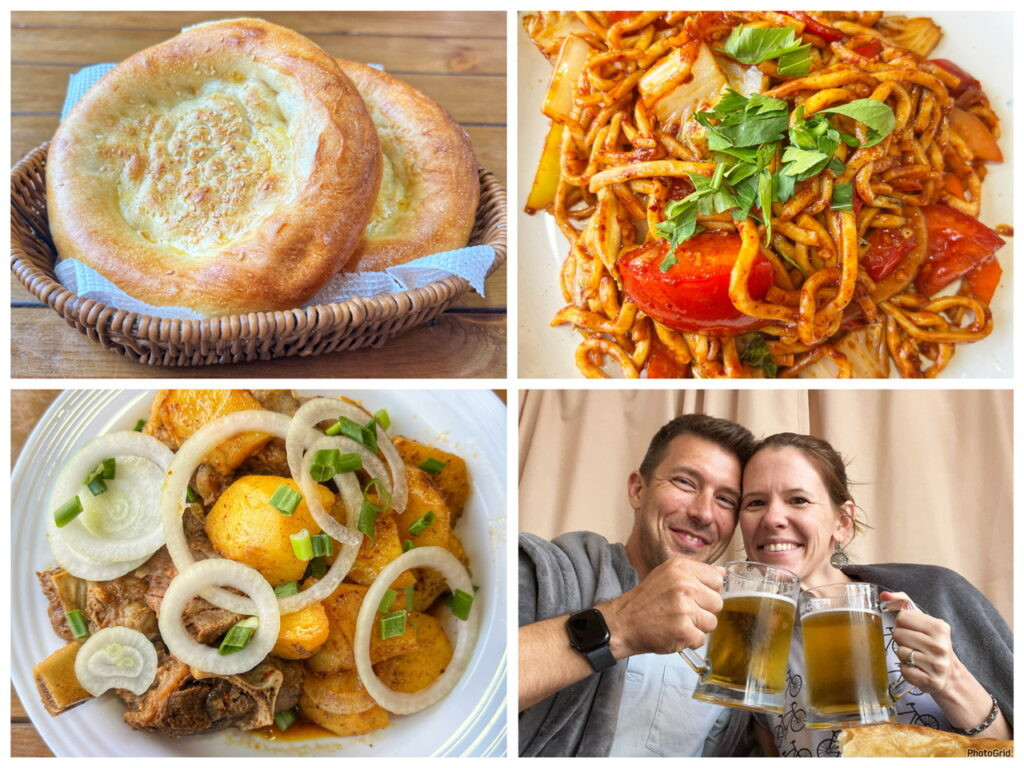
On our first night, we visited the clearly popular with tourists Dastorkan Cafe, which had live Kygryz music making it even more of a unique dinner experience.
For this touristy restaurant splurge meal, we spent $16 and we had:
- Two giant bread discs, called “Issyk-Kul Naan,” which are big, flat, beautifully stamped bread with patterns pressed into the center using a bread stamp called a chakich.
- I ordered a vegetarian Boso Laghman, which are hand-pulled noodles that are a bit spicy served with onions, cabbage, peppers and other veggies. They are so AMAZING I had them twice.
- Greg sampled the Kuurdak (which definitely fits the Kyrgyz stereotype) and is hearty fried meat (lamb), onions and potatoes. He also loved it and would have it again.
- And of course, we both had a pint of local beer so we could cheers to our new location.
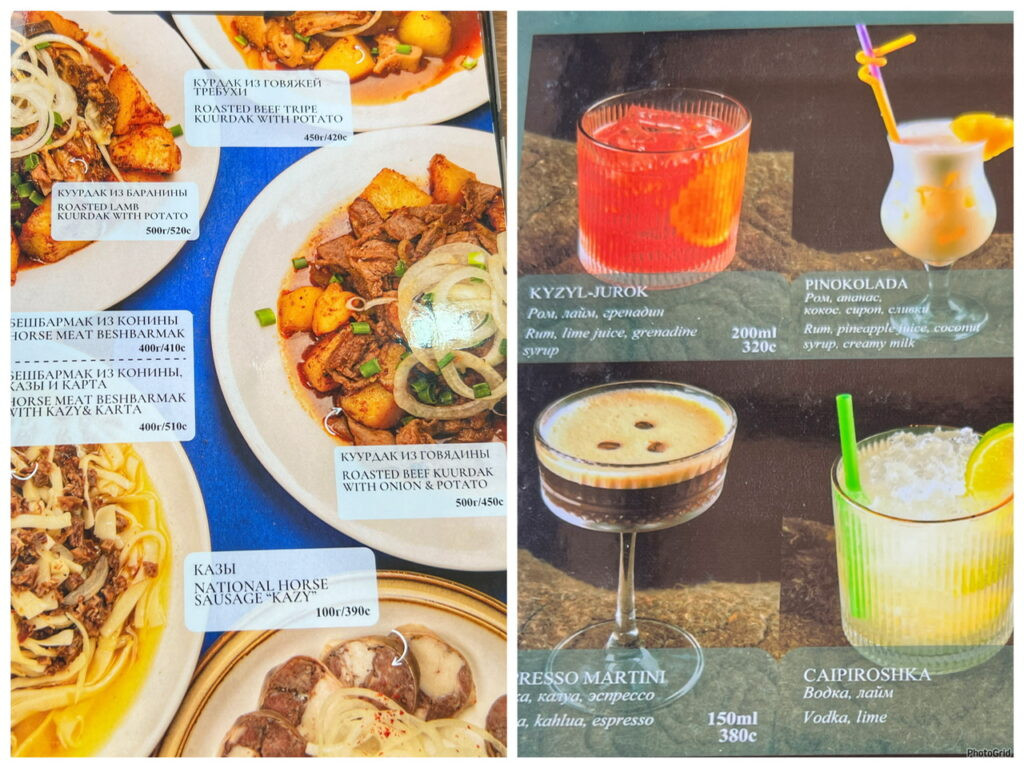
You know it’s a tourist restaurant when the menu is very fat, in three language and laden with photos! Other things on the menu included the Kyrgyz national dish, Beshbarmak, which is a noodle and horse meat dish for about $5. They also had a full selection of cocktails for around $3-4/drink.

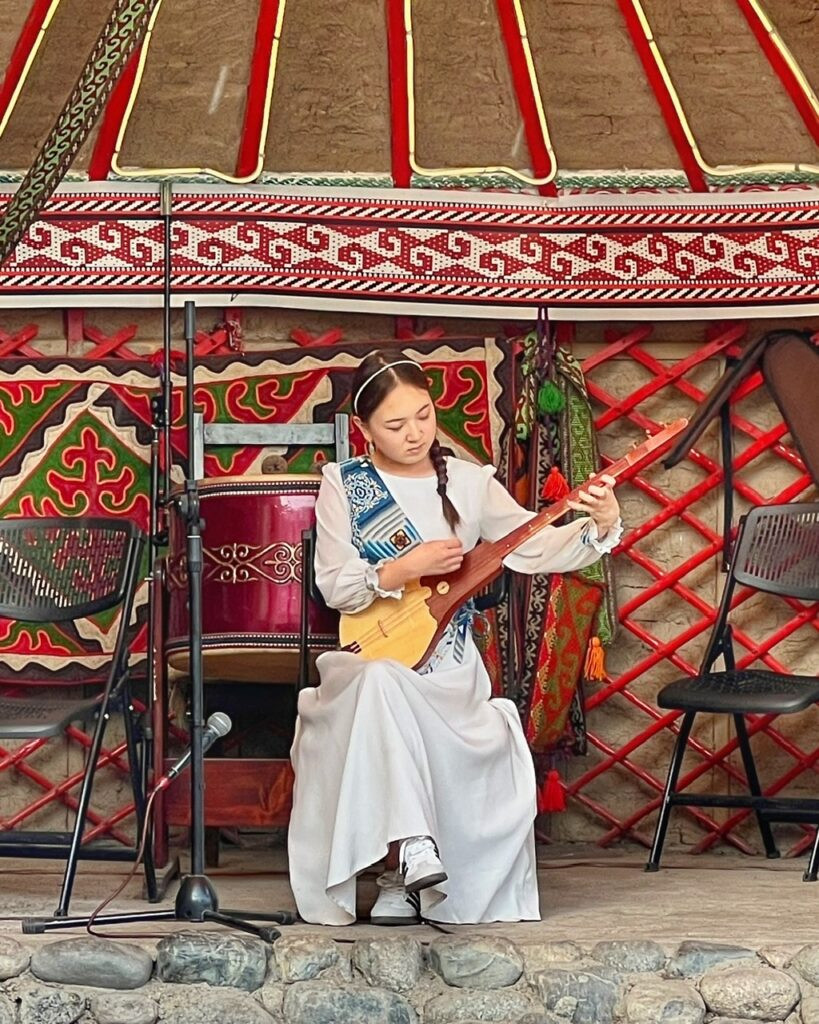
Two young hosts, who definitely knew some English, model their local look including Kalpak hats, which are one of the strongest symbols of Kyrgyz national identity. These hats, worn by men, are made from white felted wool, which represent purity, dignity and respect for elders. The four panels represent the four seasons, and we saw men wearing them everywhere throughout the city.
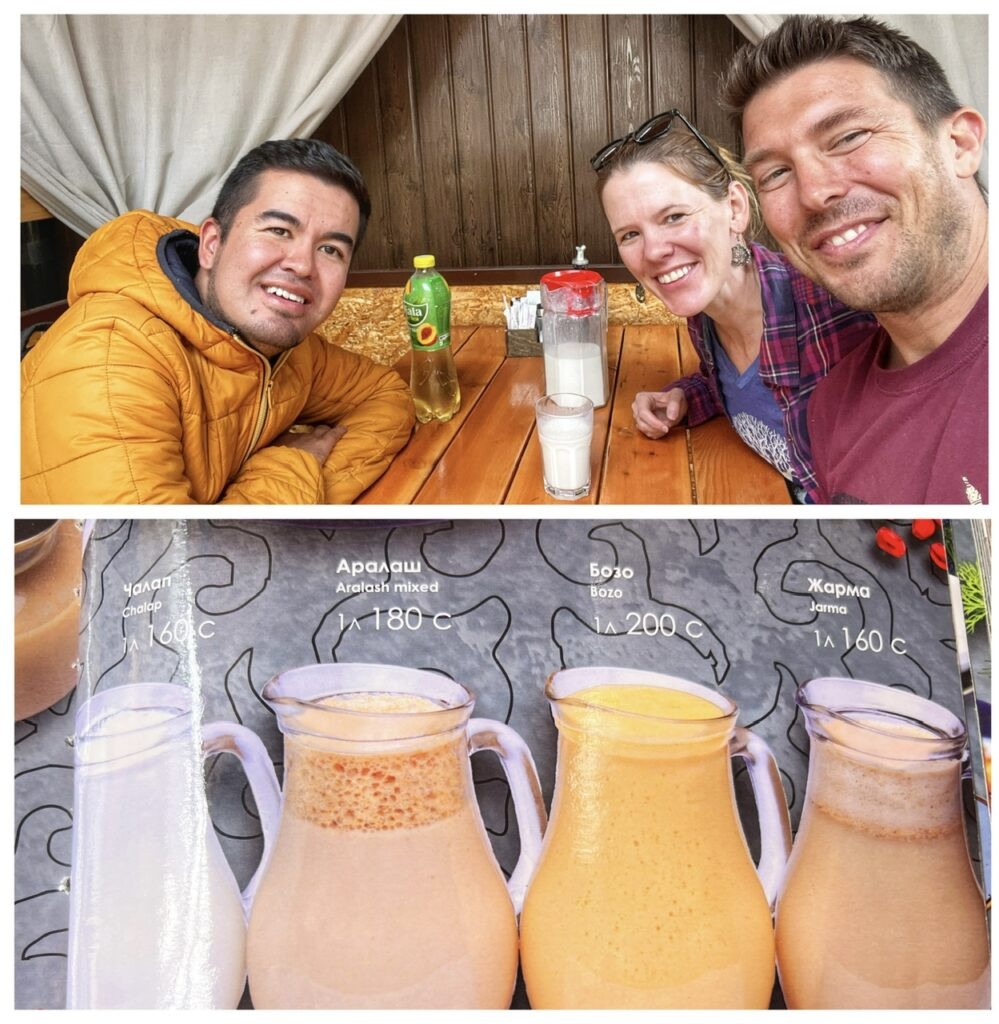
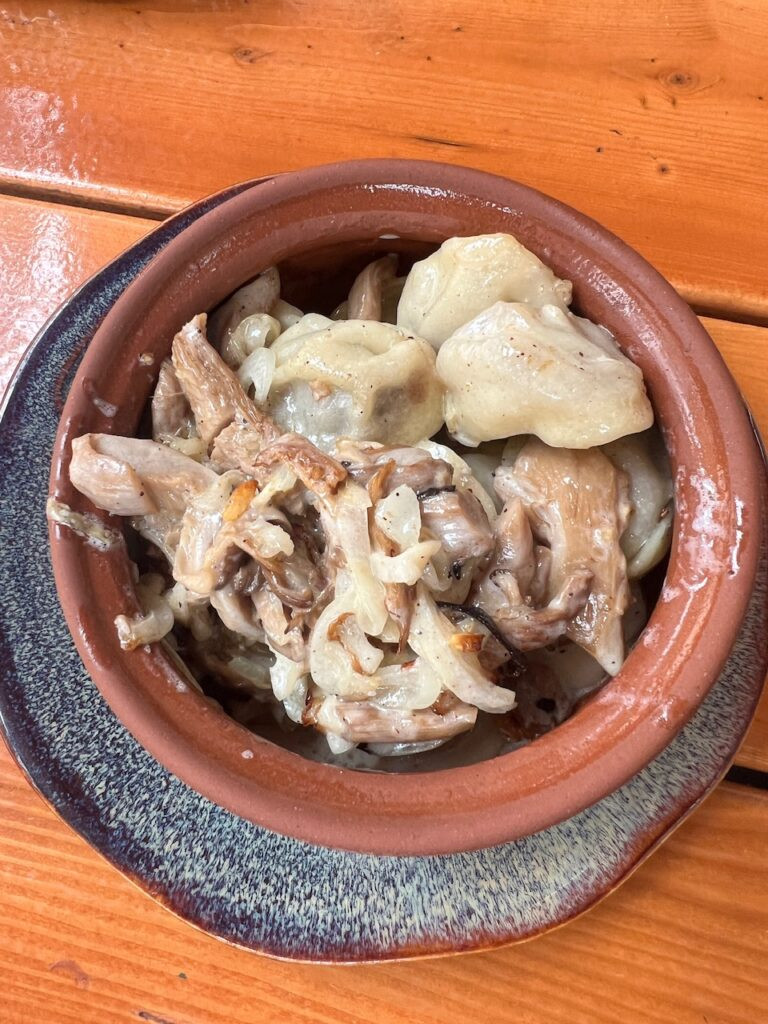

For another meal, we checked out “Altyn Kumara” with our Colombian friend Jonathan. Greg had been wanting to try some of the fermented drinks the country is known for, so since we love ayran, we ordered a $1.80 pitcher of “Chalap” which is a salty yogurt-based drink, supposedly similar to ayran. Ayran it was NOT. Jonathan and I both curled their noses in disgust at the salty tang, but Greg happily chugged down half a pitcher citing the benefits to your gut health.
Alongside our nose curling concoction, we also had another bowl of laghman, a bowl of manti with wood fired mushrooms in a creamy sauce, and a platter of eggplant and peppers in a sweet and sour sauce. Mmm…the food is surprisingly smashing here!

When we weren’t eating out, we were enjoying the decent selection at Globus and Karavan supermarkets, including the mouth-watering veg-friendly options from their deli, which were about $1.00-$1.50/container.
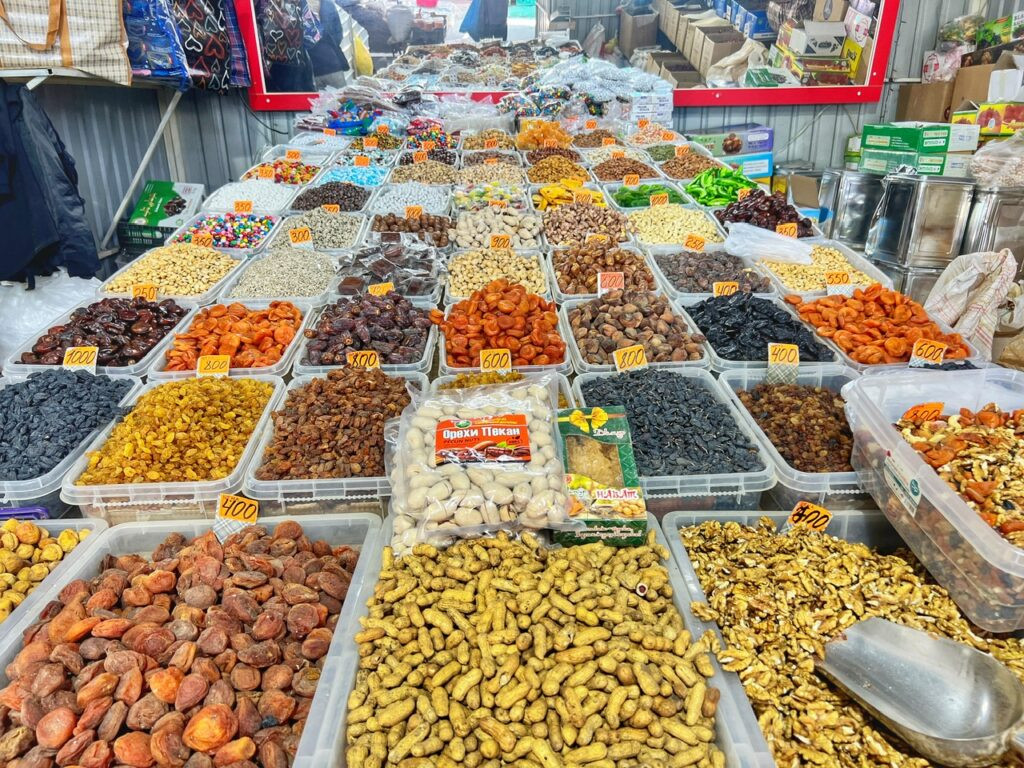

We also spent some time at the local market, where we found tons of dried fruit and nut options (perfect for hiking!), eggs…..(from $.09-.12/each)…
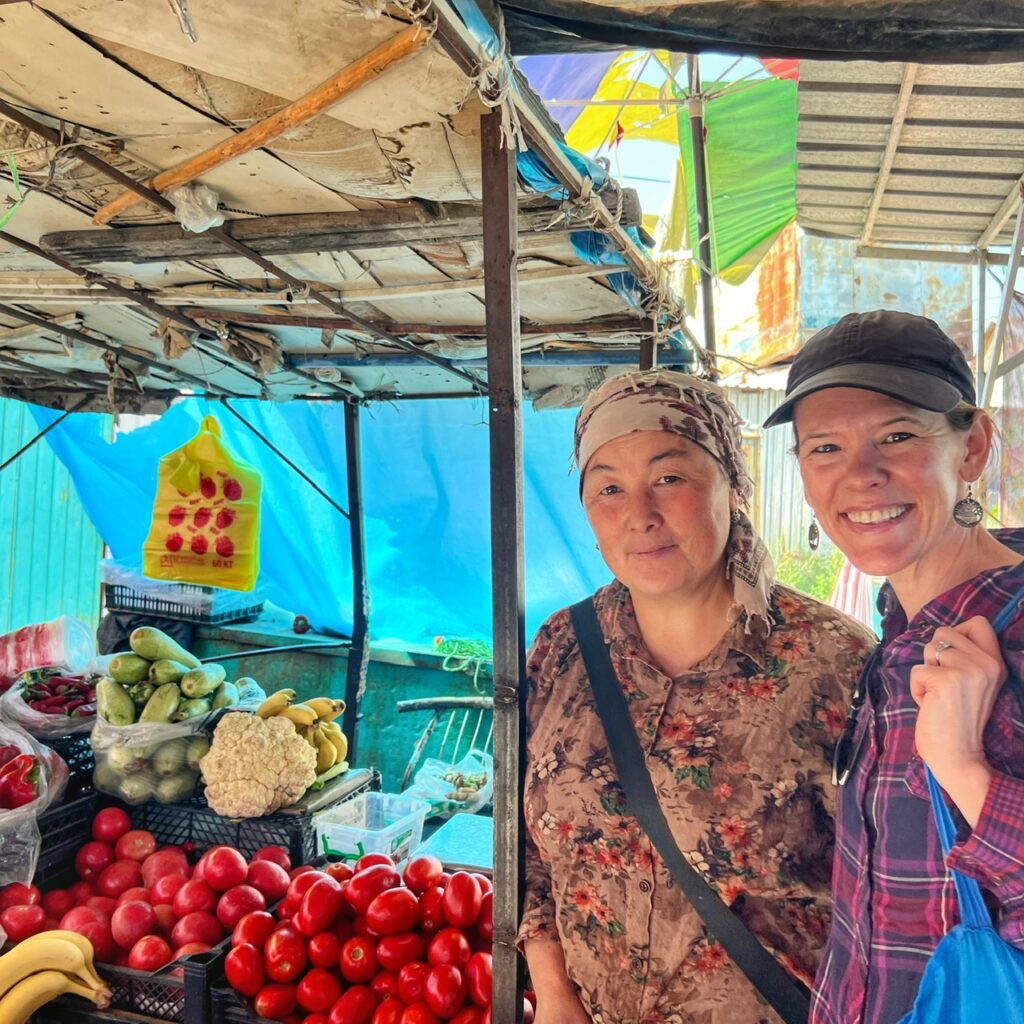

…and of course veggies, where we were always met with friendly people offering what seemed to be honest prices. This haul was $8.80, not including the 2-liters of CRAFT beer from the rear of the Globus Supermarket, which was about $5.70.
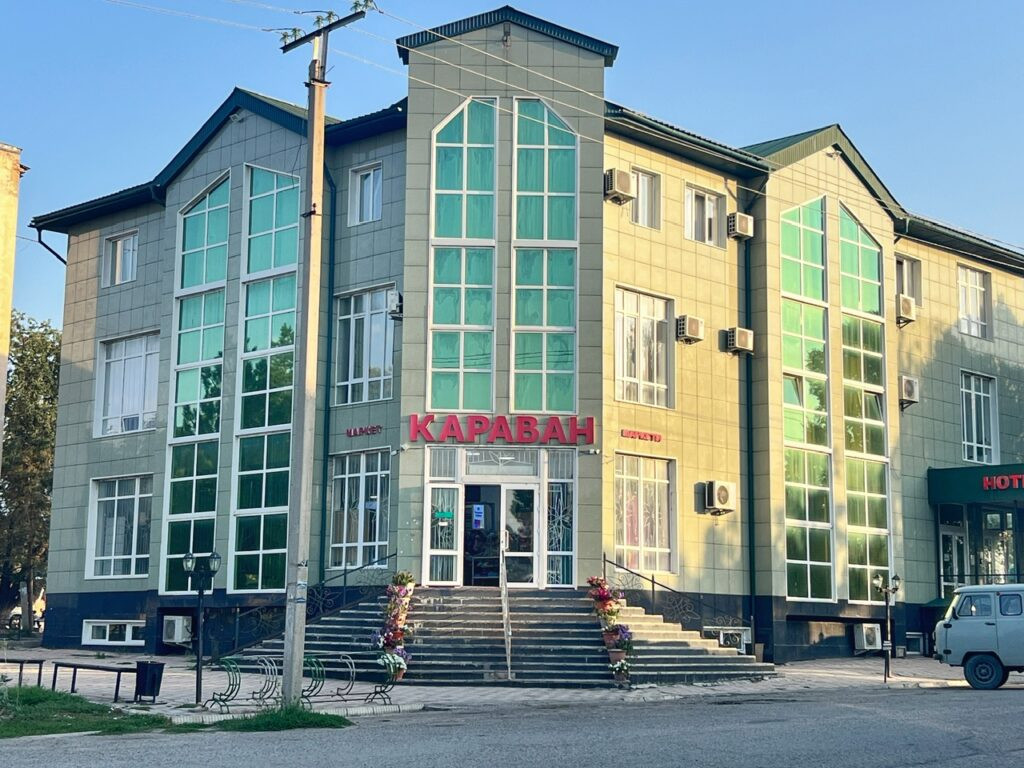
Caravan…near our apartment, was one of the grocery stores we frequented.

We also bought one of these scrumptious snacks at the local market which was a walnut energy ball made of honey and dried apricots. We only wish we’d found them in time to be hiking snacks! So yummy!!
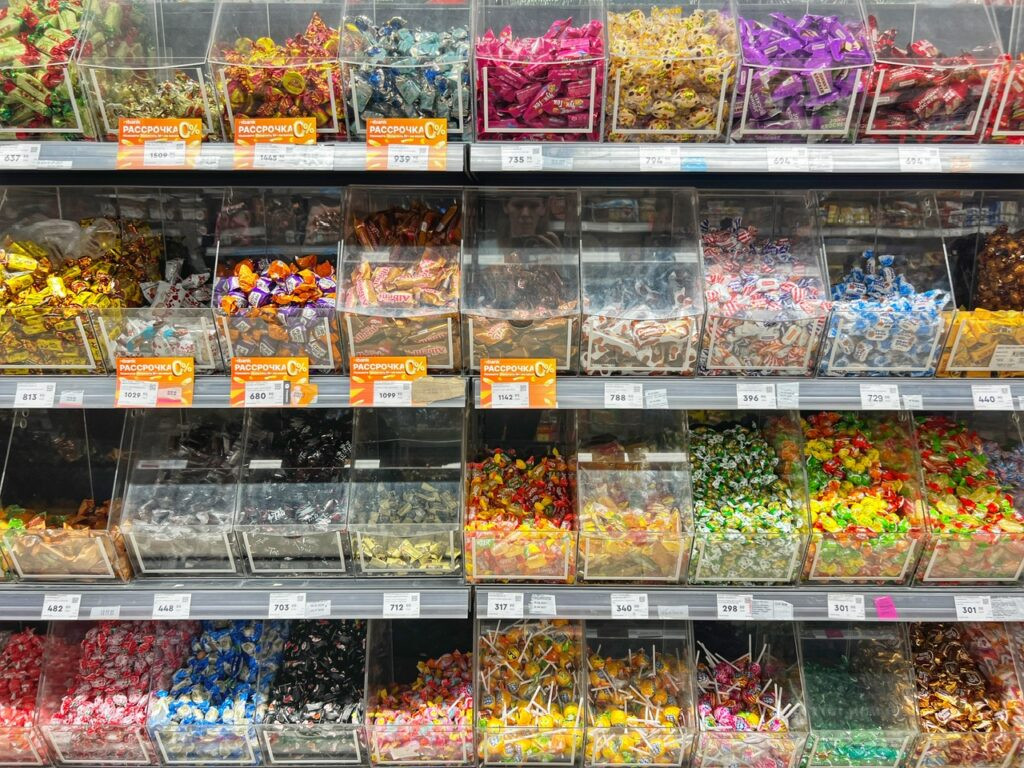
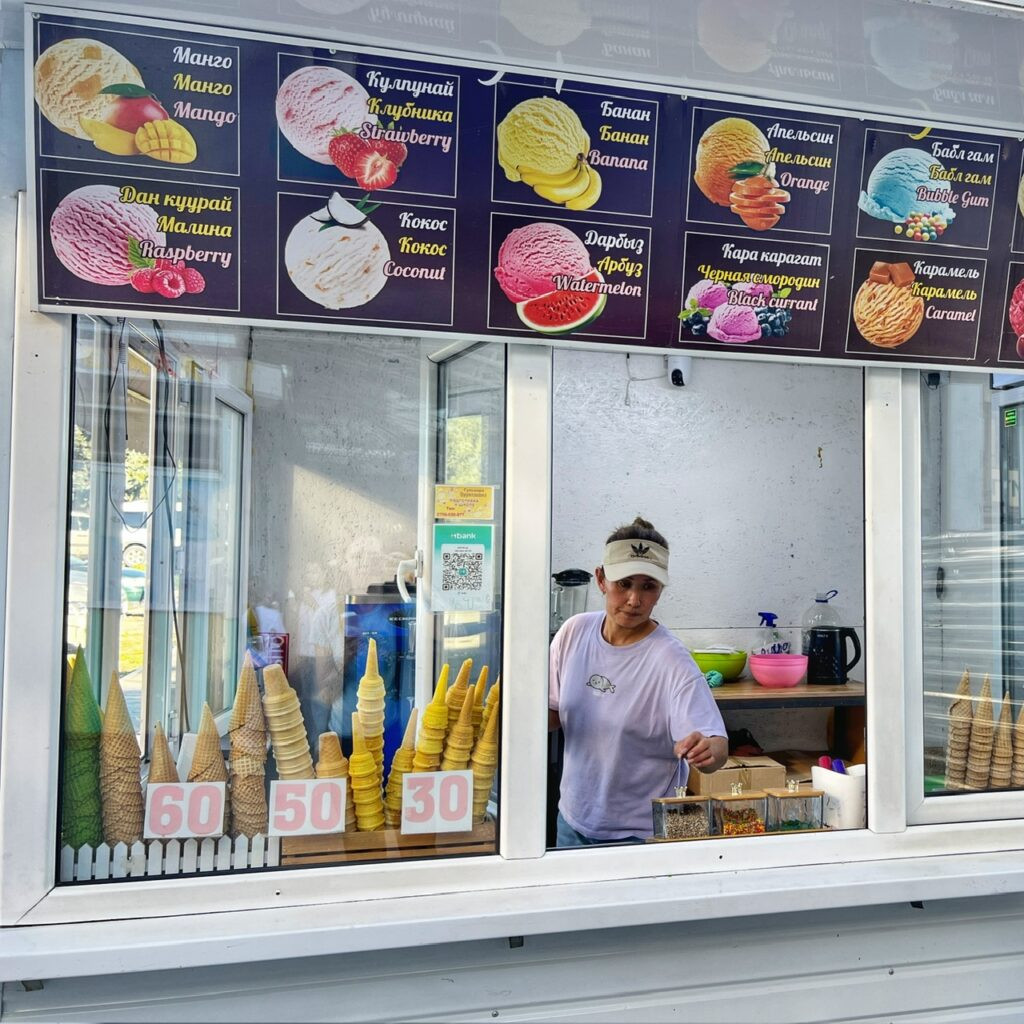
Kyrgyz people seem to love them candy and bon bons. So many options at the markets! They also love their ice cream. You can get a cone starting at $.35!
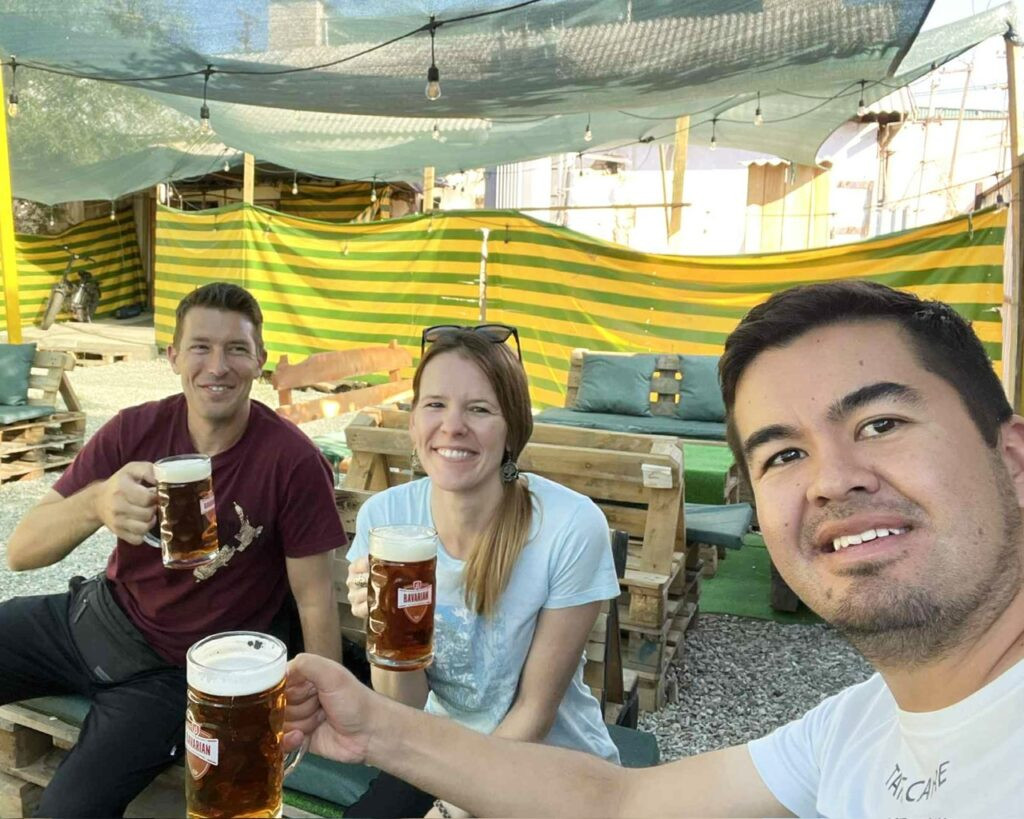
But the one thing that makes my Greg the most happy…draft beers from Pinta, which had a cozy back beer garden. Alongside Jonathan once again, we got large four beers for under $6.
Chinese Muslims…In Kyrgyzstan?!
In Karakol, Kyrgyzstan, one can find an unusual brightly colorful mosque, which looks more like a Chinese Buddhist temple. This makes complete sense because it was built by Chinese Muslims who fled persecution during the Dungan Revolt (1862–1877) and settled in regions like Karakol and nearby villages.
During the Soviet era, the mosque was repurposed as a storehouse. It returned to religious use in 1947, and today remains an active place of worship and cultural heritage. We visited one evening when the grounds were filled with artists and worshippers.
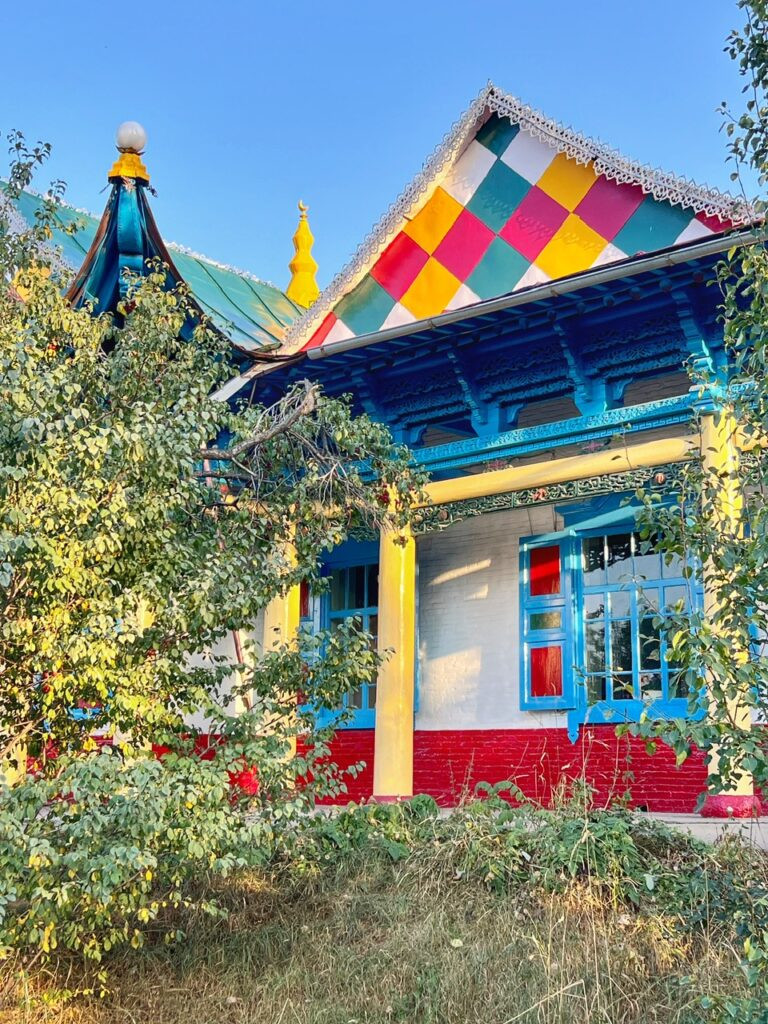
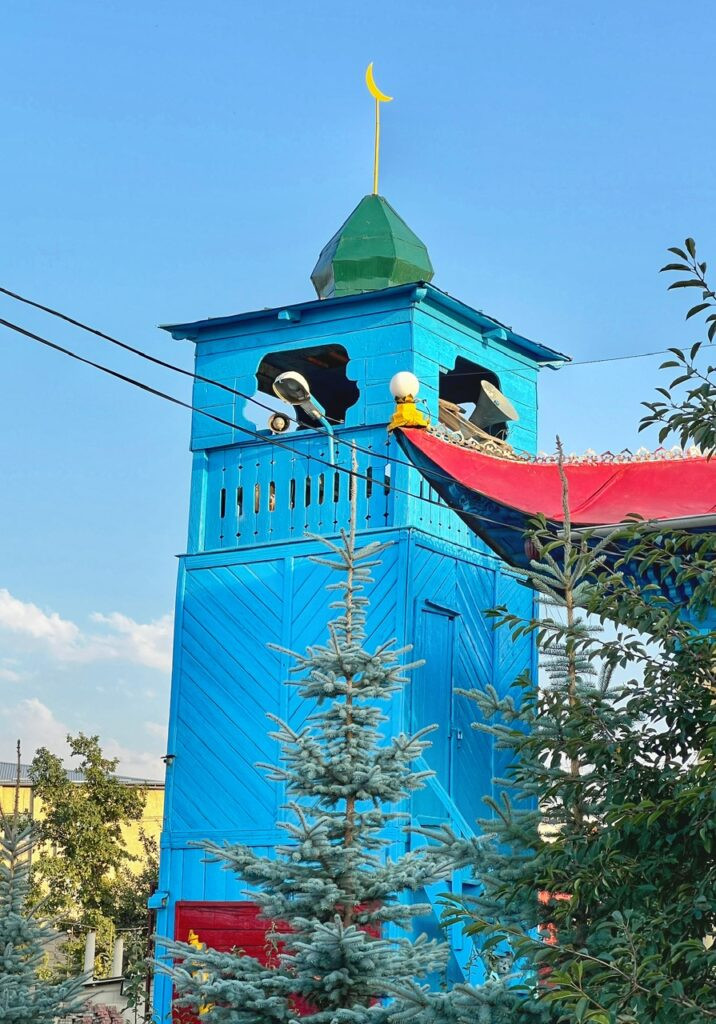

Its exterior boasts several vibrant and symbolic colors: Red, for protection against evil spirits; yellow for prosperity and green for happiness.
Instead of a traditional minaret, it has a separate wooden pagoda-style tower painted electric blue, and some elaborate multi-tiered wooden cornice.
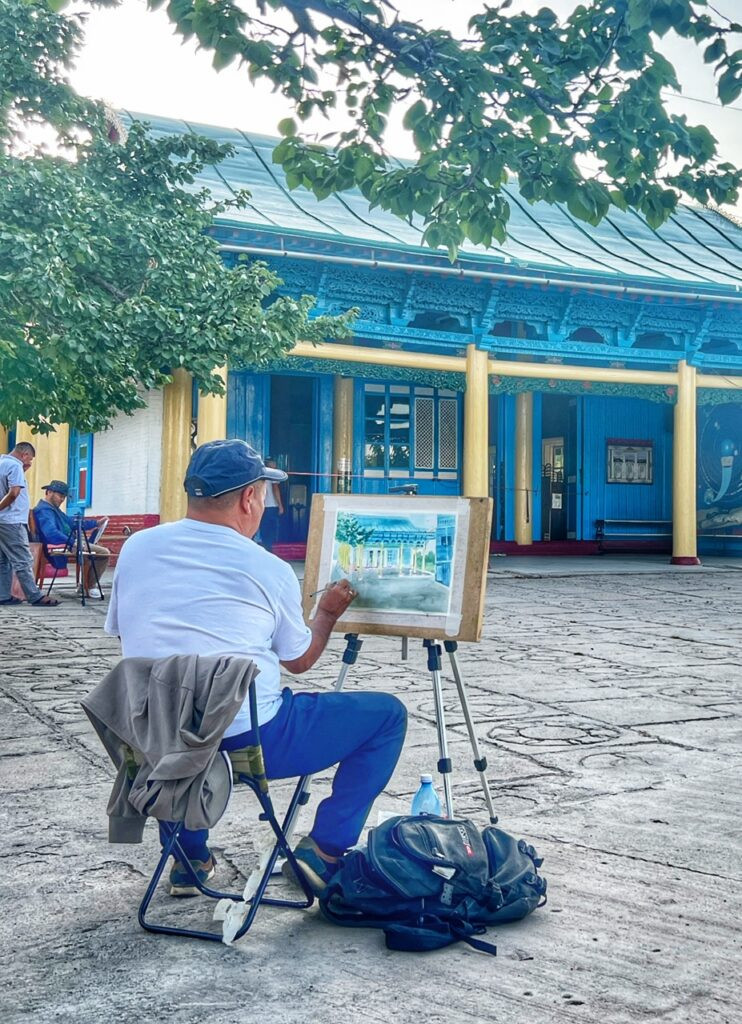
It seemed to be paint by numbers night at the mosque…minus the best part…. (the wine.) Also, these guys were way more talented than the last time we did this.
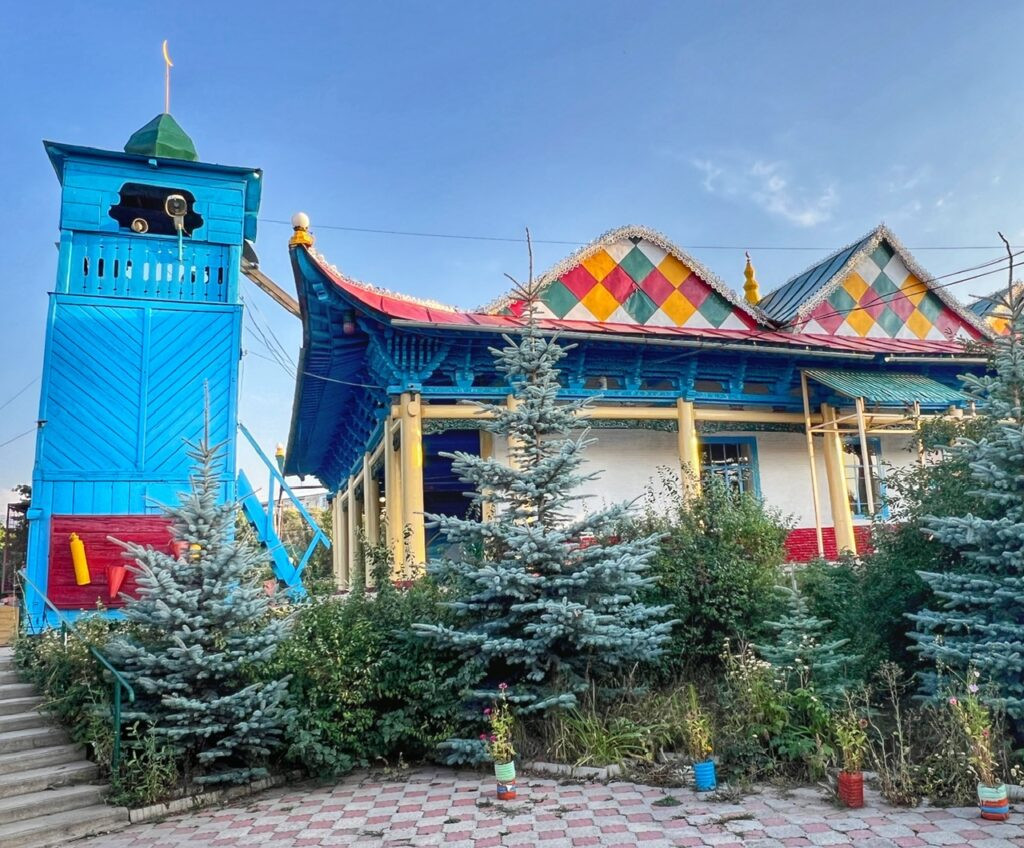
Definitely unique.
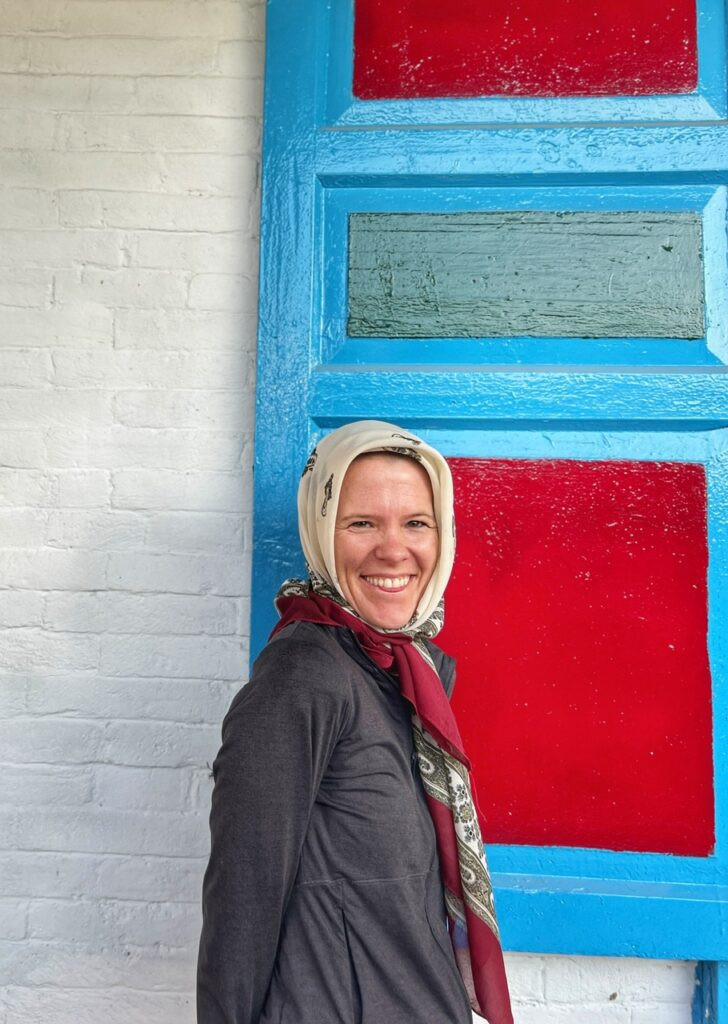
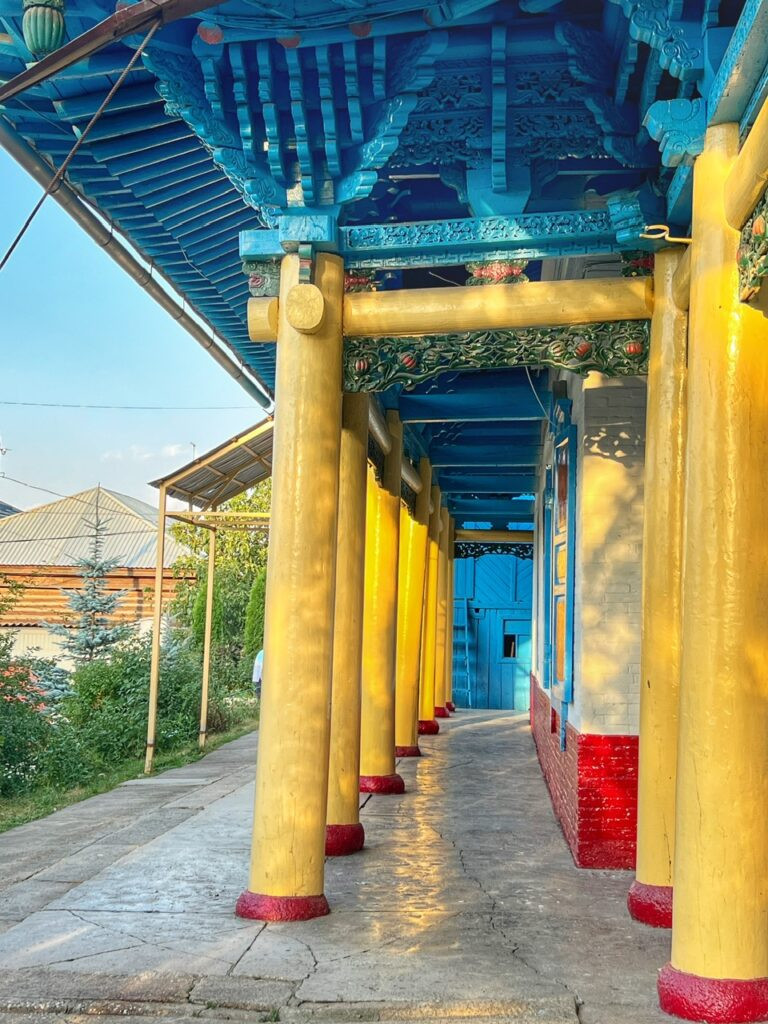
Mandy the Babushka. The mosque is supported by 42 pillars…

…and is richly decorated with carvings of native fruits and plants such as grapes, pomegranates, pears, and peaches. It was a 50 Kyrgz, or $.57 donation to enter, and we were happy oblige.
Holy Trinity Orthodox Church
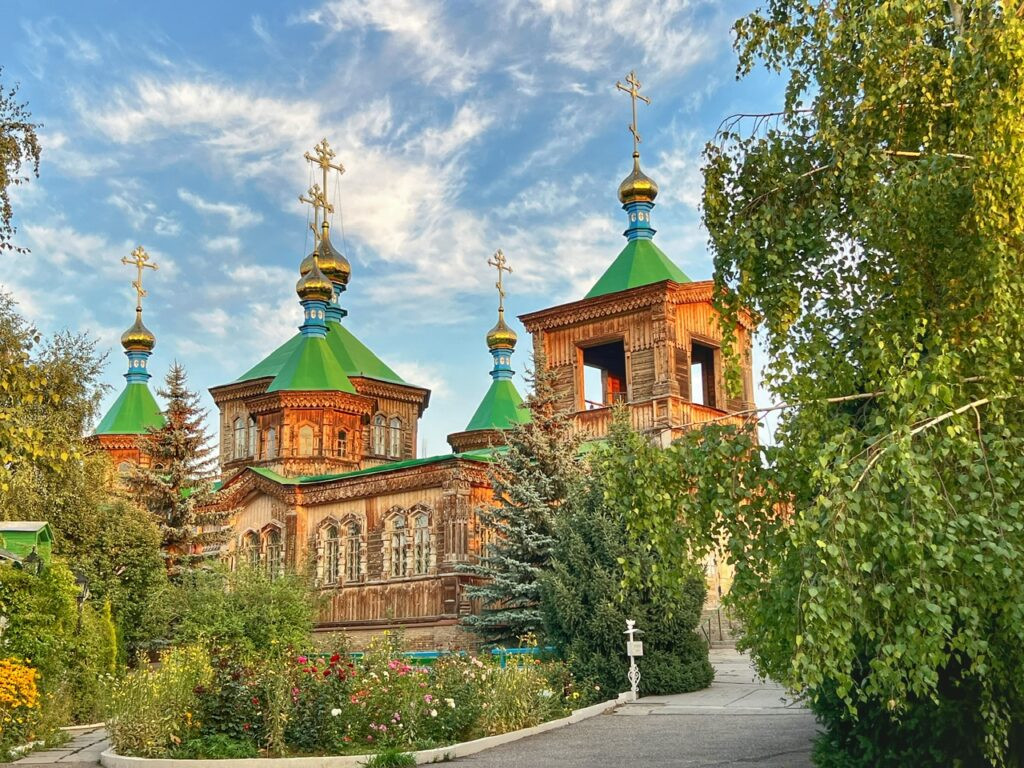
On the other side of the pew, standing as one of Kyrgyzstan’s most iconic wooden churches and as a resilience symbol through turbulent political history, the Holy Trinity Orthodox Church in Karakol is unlike any we’ve ever seen. It was first built in the 1870s, but an earthquake destroyed the original brick structure. The current wooden church, completed in 1895, has survived revolutions, Soviet secularization, and neglect—serving at times as a school, theater, and even a coal store—before being restored and returned to the Orthodox community in the 1990s.
It is located in the middle of town, open to the public from 9 am to 5 pm, and is free to enter. Women need to cover their heads, but scarves are provided. Photos inside are prohibited.
The Local Market…the Animal Market?
Part of travel for us has always been checking out the local markets. This is where you truly can capture the essence of the place, the culture and the people in any region. In Central Asia, one of the most famous traditional markets in Kyrgyzstan happens to be…the Sunday Karakol Animal Market, which was certainly unlike anything we’d seen before.
Although some parts of it made us feel a bit sad, because (some) of what is typically hidden from us as Westerners is on blantant display, Kyrgyz culture has long been based on pastoral nomadism, where wealth was measured in animals. Weekly livestock markets have been essential hubs for trade, news, and social life for centuries. Karakol’s market continues this tradition and it was interesting to be immersed in it.
By immersed it…we mean totally immersed. Watch your step! 🤣💩
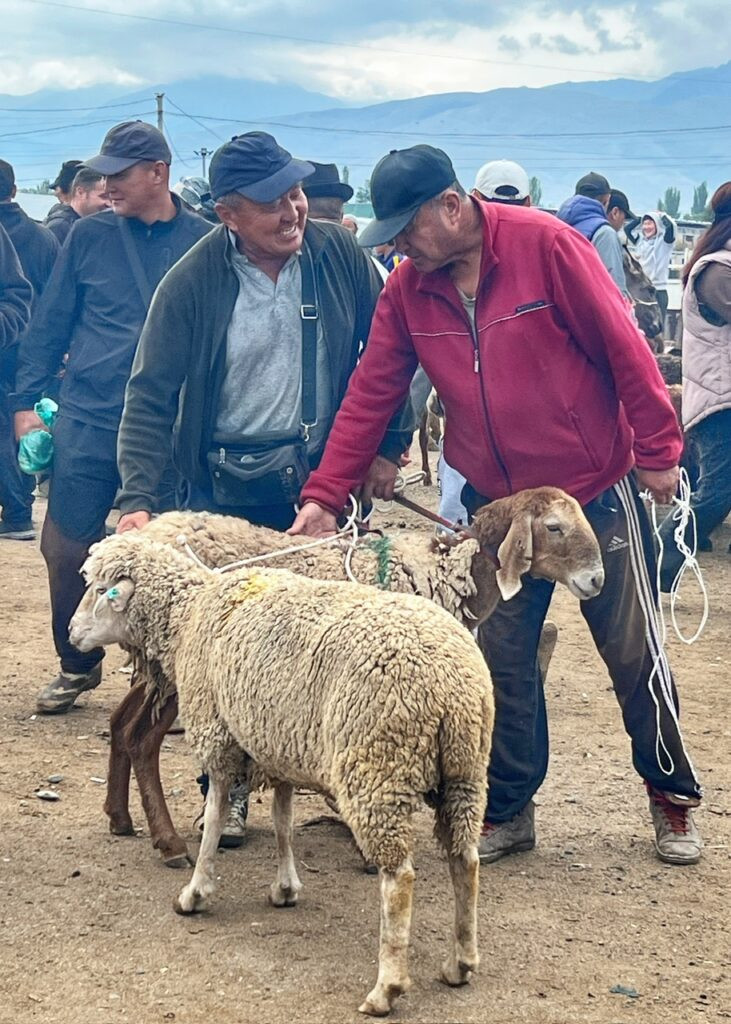

One nice thing about the market is getting the chance to photograph and interact with locals in an open environment. Most seem very welcoming to the handful of tourists who roam a bit bewilderingly around.
The market consisted of cows, donkeys, sheep, and horses. Pigs get spared presumably because 90% of the country’s population is Muslim. During the Soviet Union, animal trading was state-controlled and largely collectivized. After independence in 1991, open markets like Karakol’s revived as free trade centers.
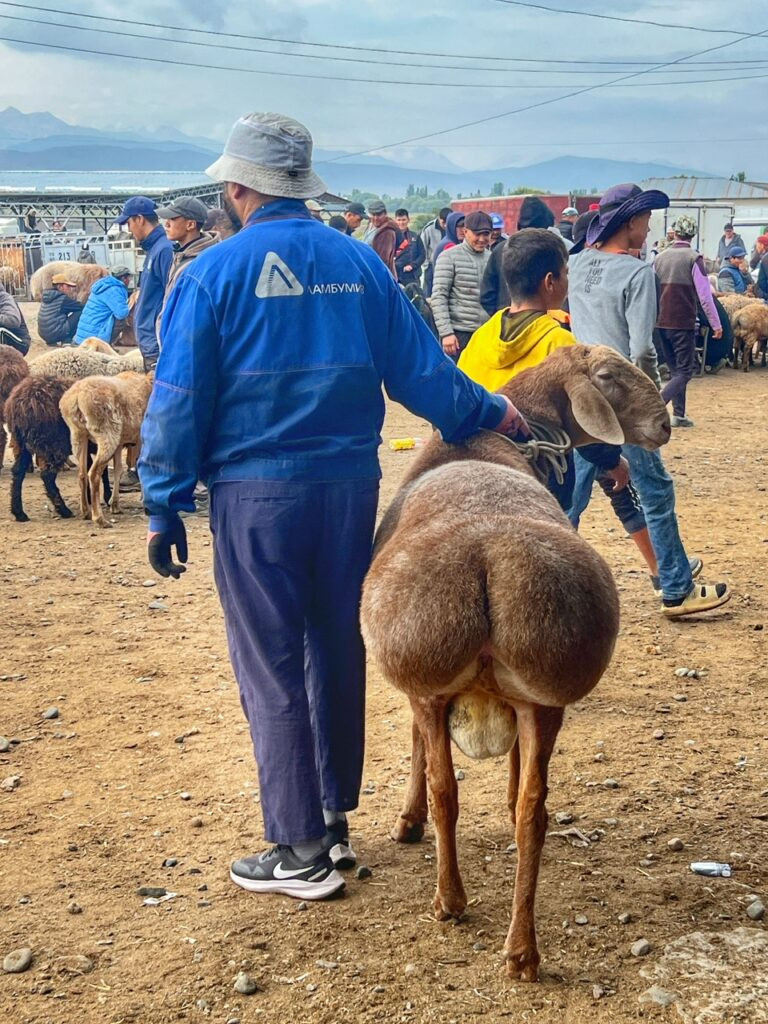
They also offer a quite extraordinary type of sheep, which will inevitably have you humming Sir Mix A’Lot.
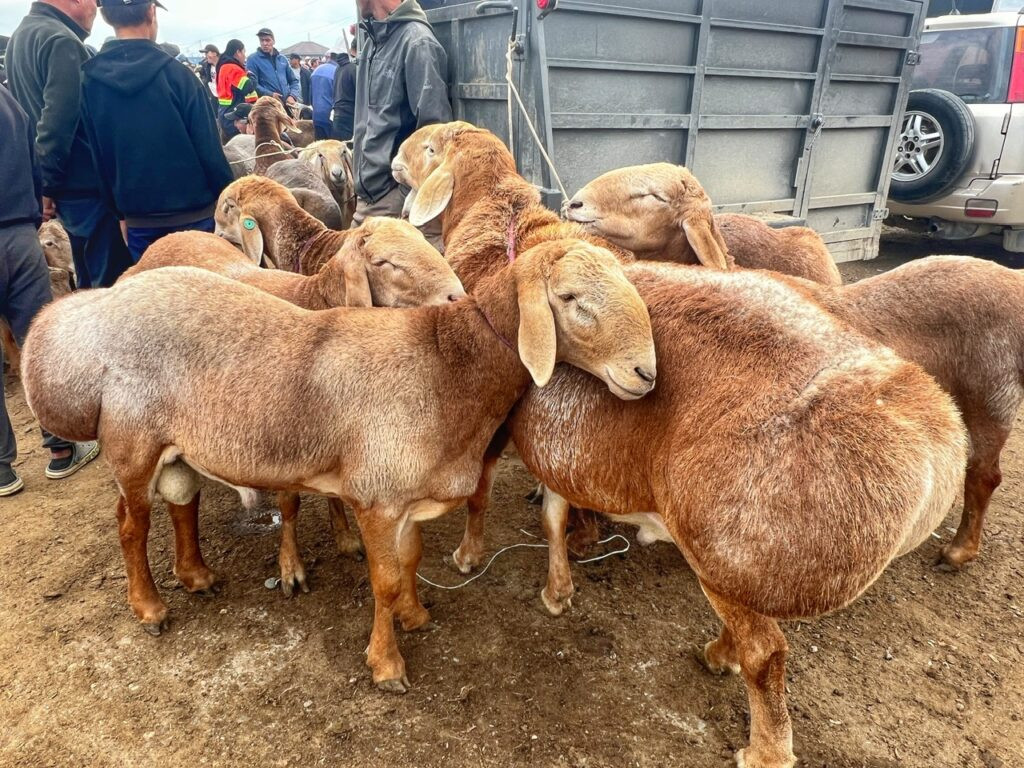
Ah yes, the “fat-tailed” aka “big butt” sheep are very common in Central Asia and you’ll see plenty of them at the Karakol animal market. Instead of storing fat evenly through their bodies, these sheep accumulate a massive fat deposit in their rump or tail area, making it look like they have an oversized rear end. According to Chat, this fat is an energy reserve, helping them survive the tough winters and dry summers of Central Asia. Think of it like a camel’s hump — same idea, just in the backside. Naturally, in nomadic traditions, owning a large flock of fat-tailed sheep is a sign of prosperity.
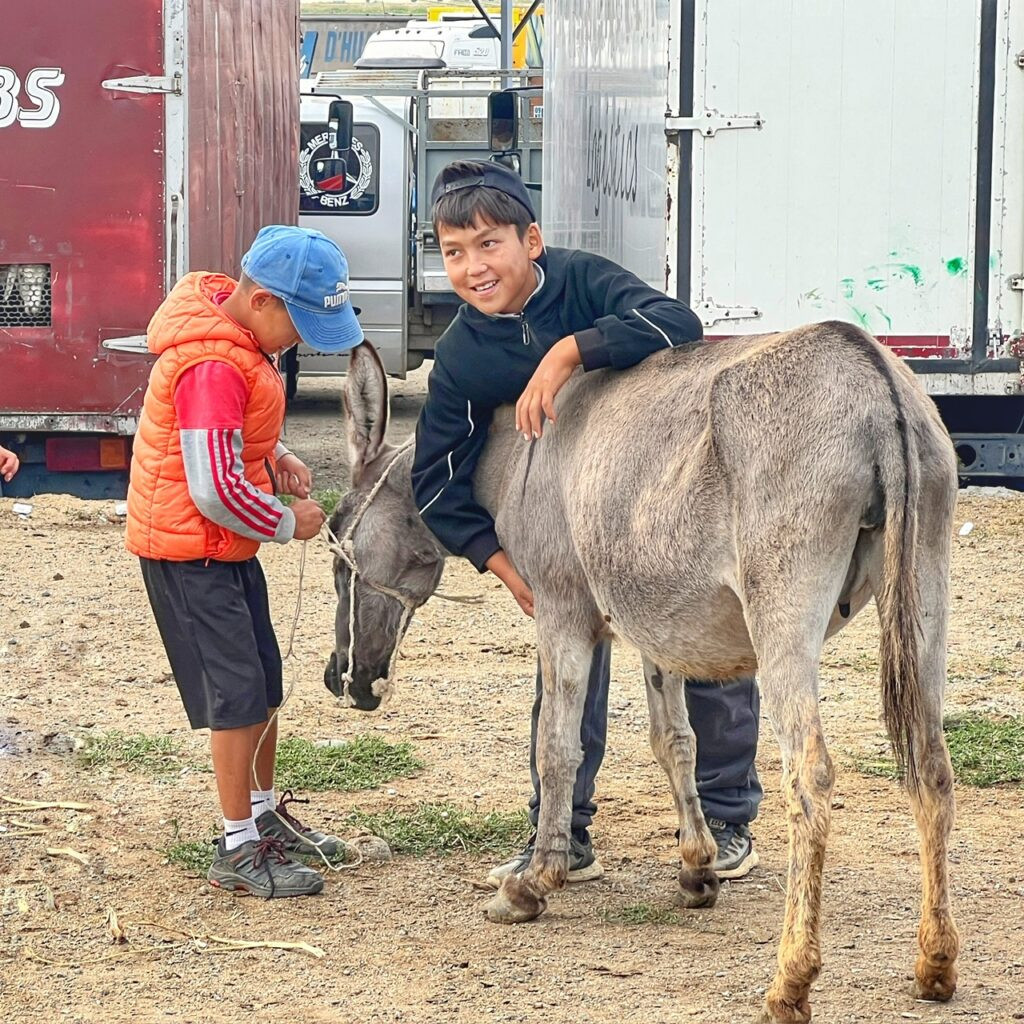
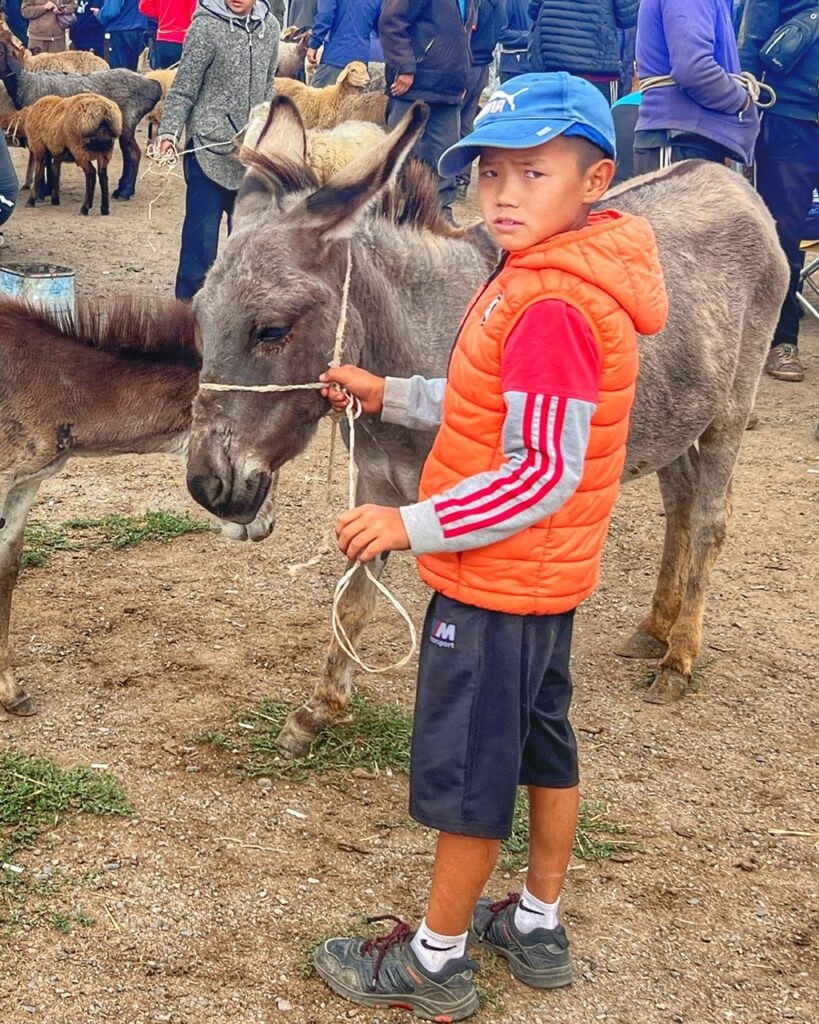
Other than the obvious shackles, we didn’t see any flagrant animal mistreatment other than these two kids who were trying to tame this donkey. But boys will be boys….🙄

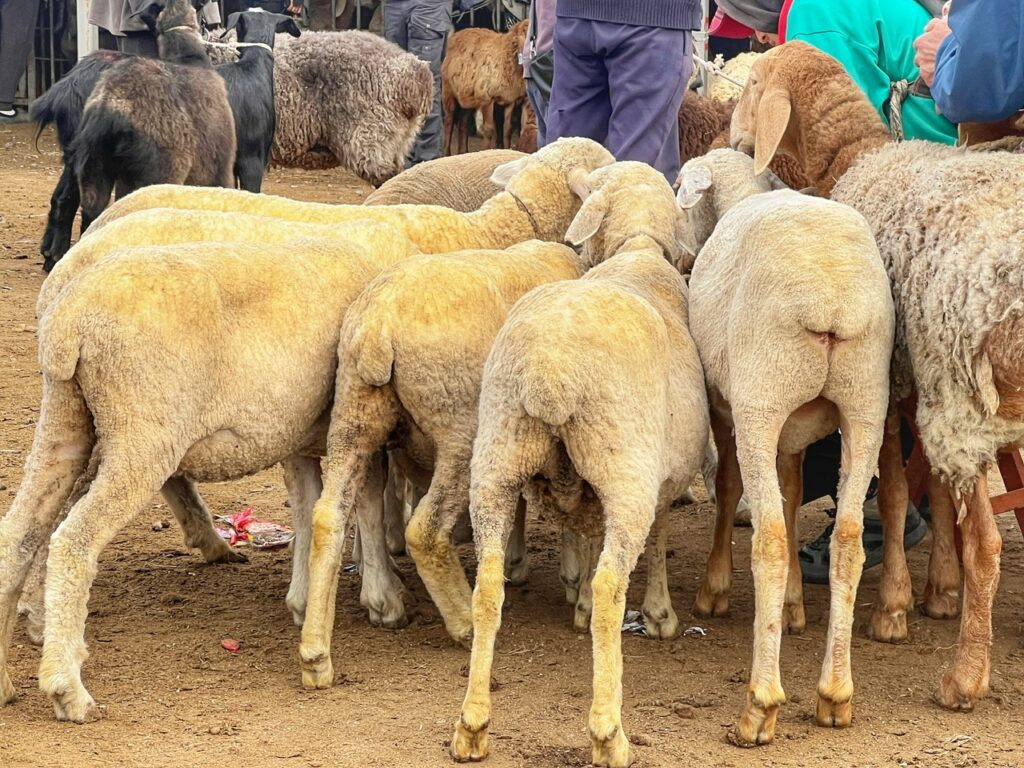
Week after week this goes on, and some sheep will be luckier than others as their wool coats are what people are after…
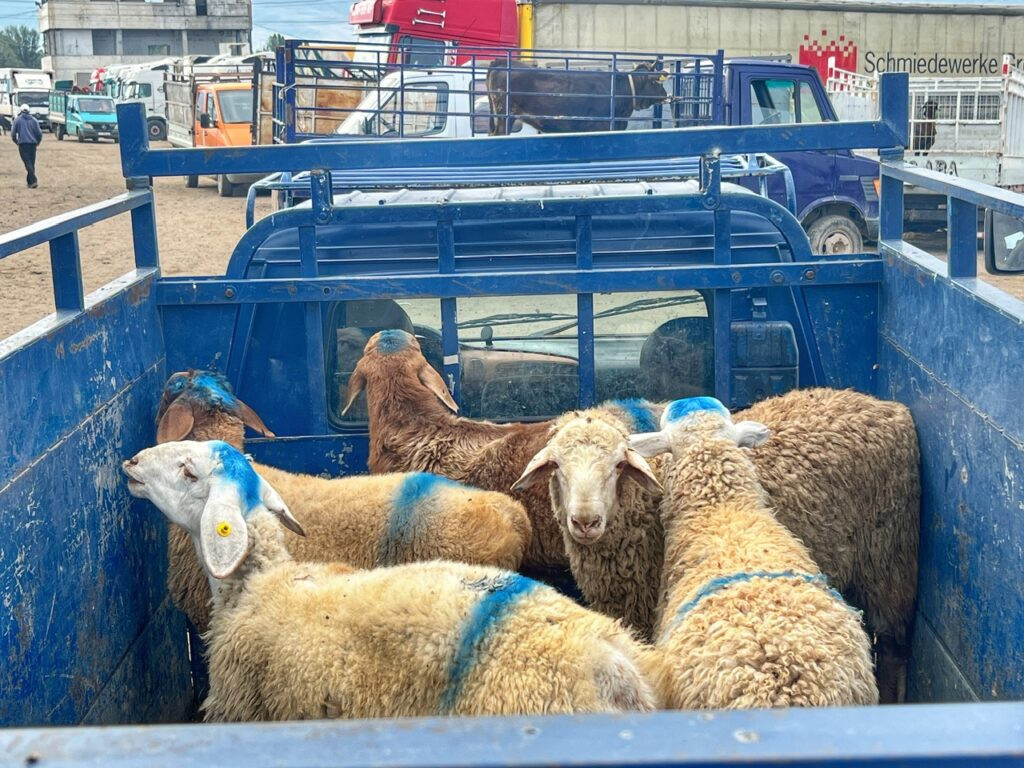
…while others it’s their sustenance. Mutton is one of the most popular meats in Kyrgyzstan. At least these guys weren’t shoved in the back of a Lada. We didn’t see this; just read about it in one review. 😳
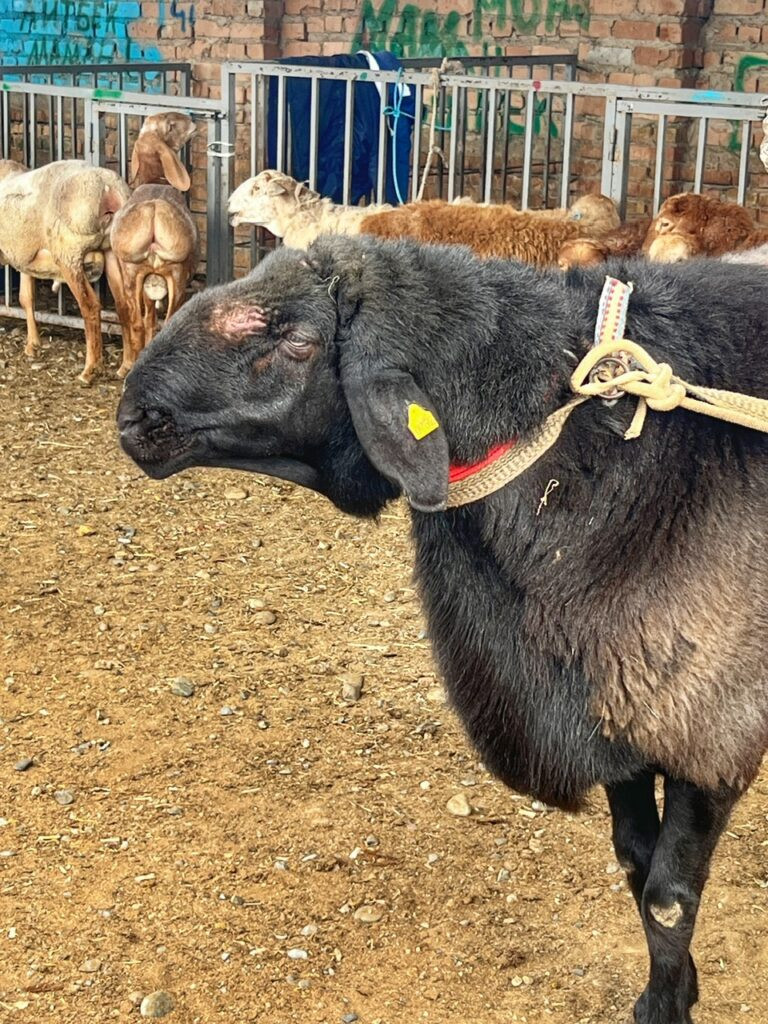
Wow…can you believe this dinosaur of a sheep? We’d never seen a face quite like it!
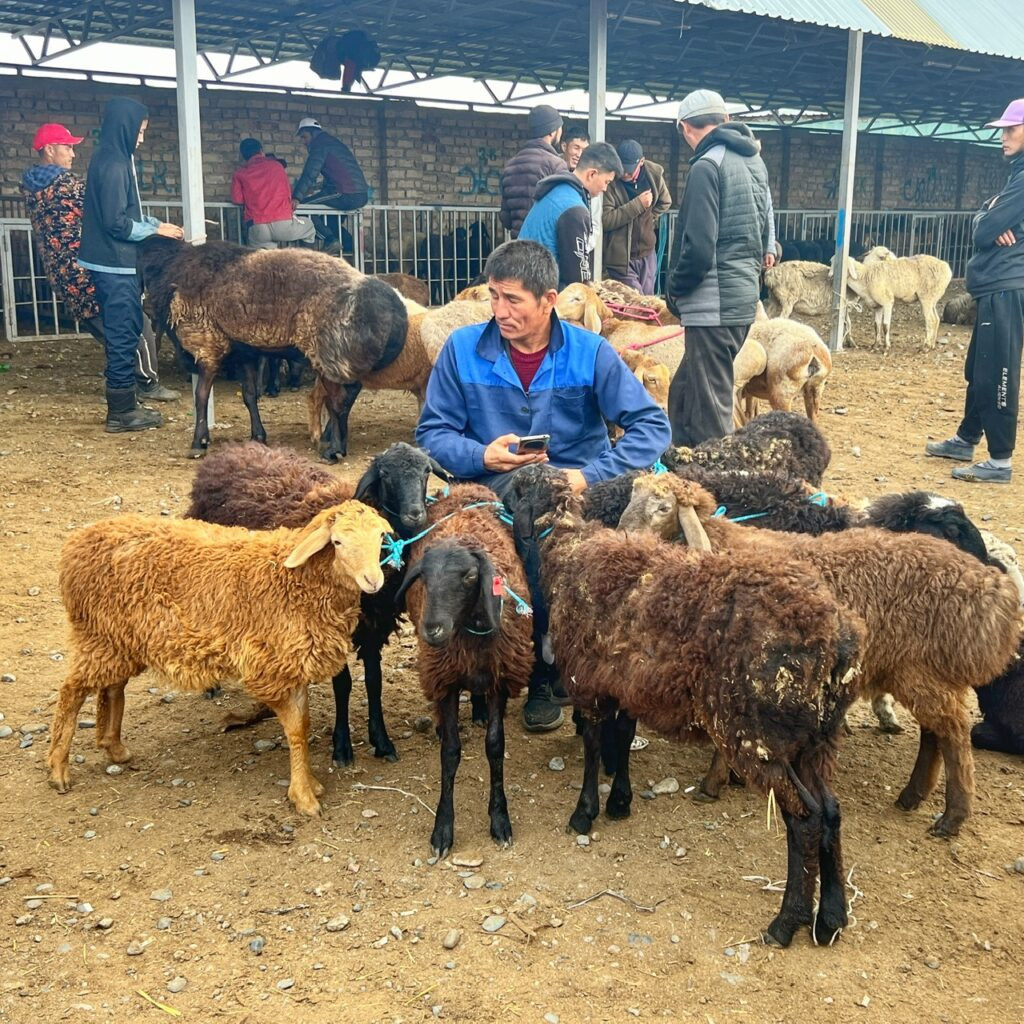
I wonder what he’s texting his wife at this moment?
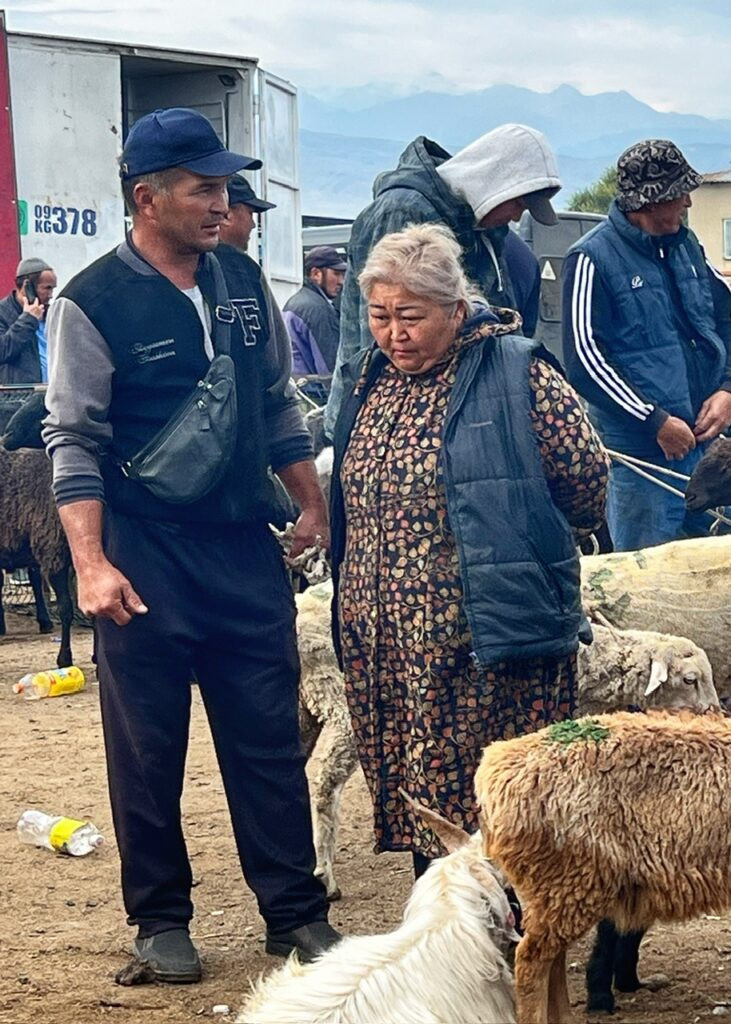
One of the few women we saw in a sea full of men.
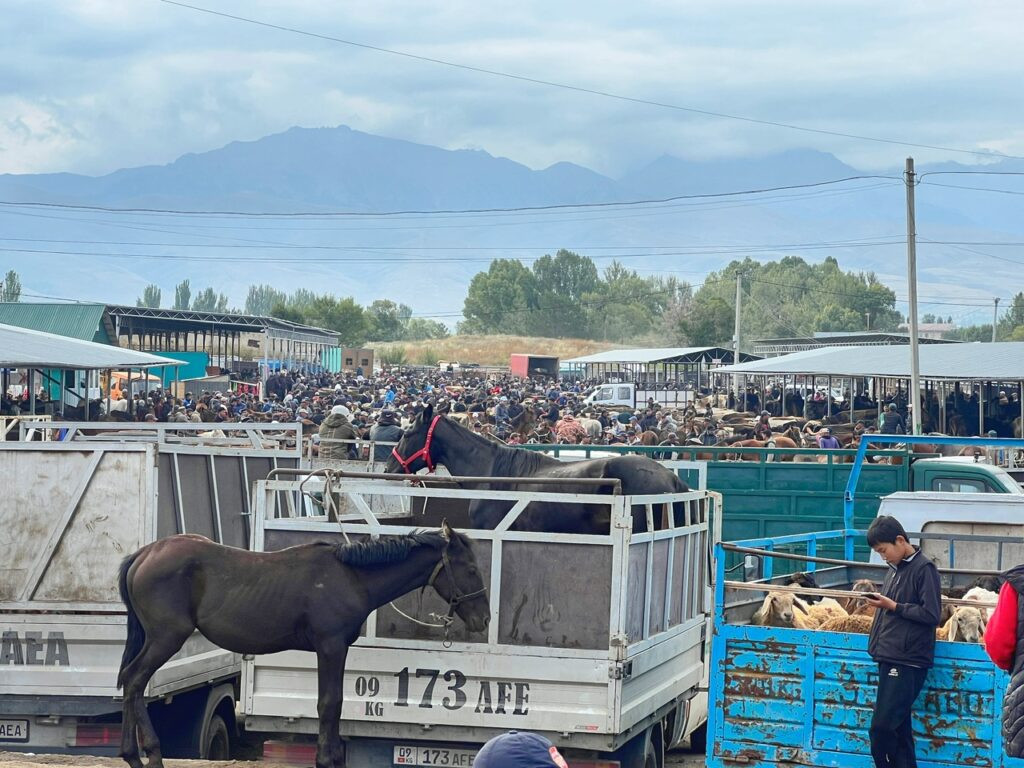
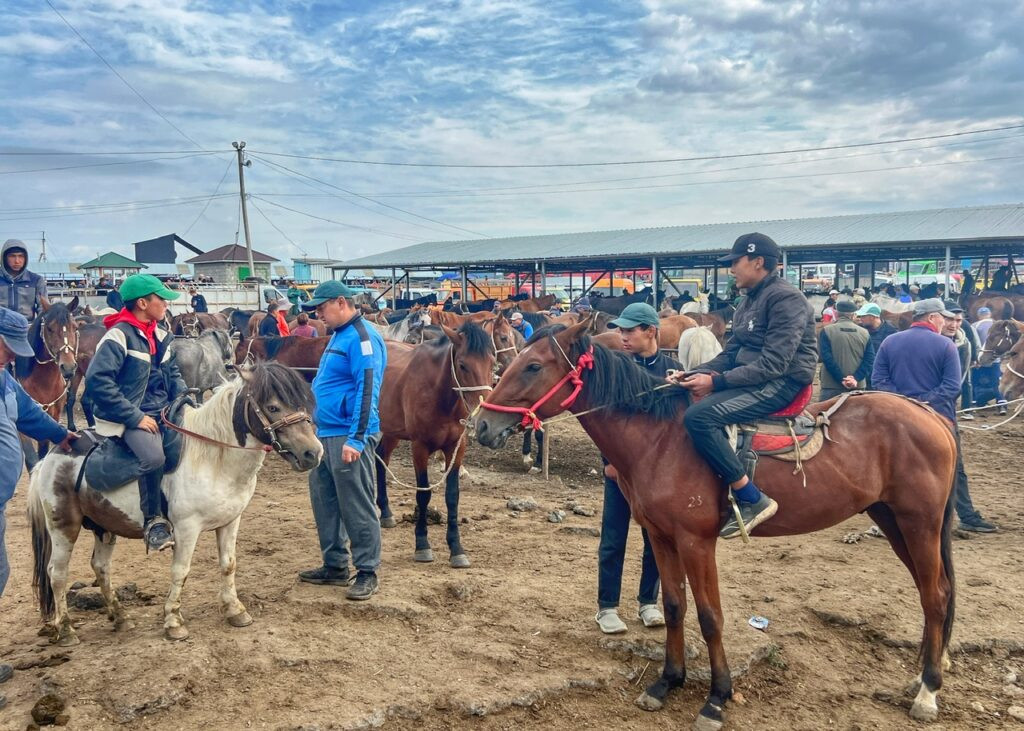
We realized this market is absolutely massive as we heading toward the horse section…
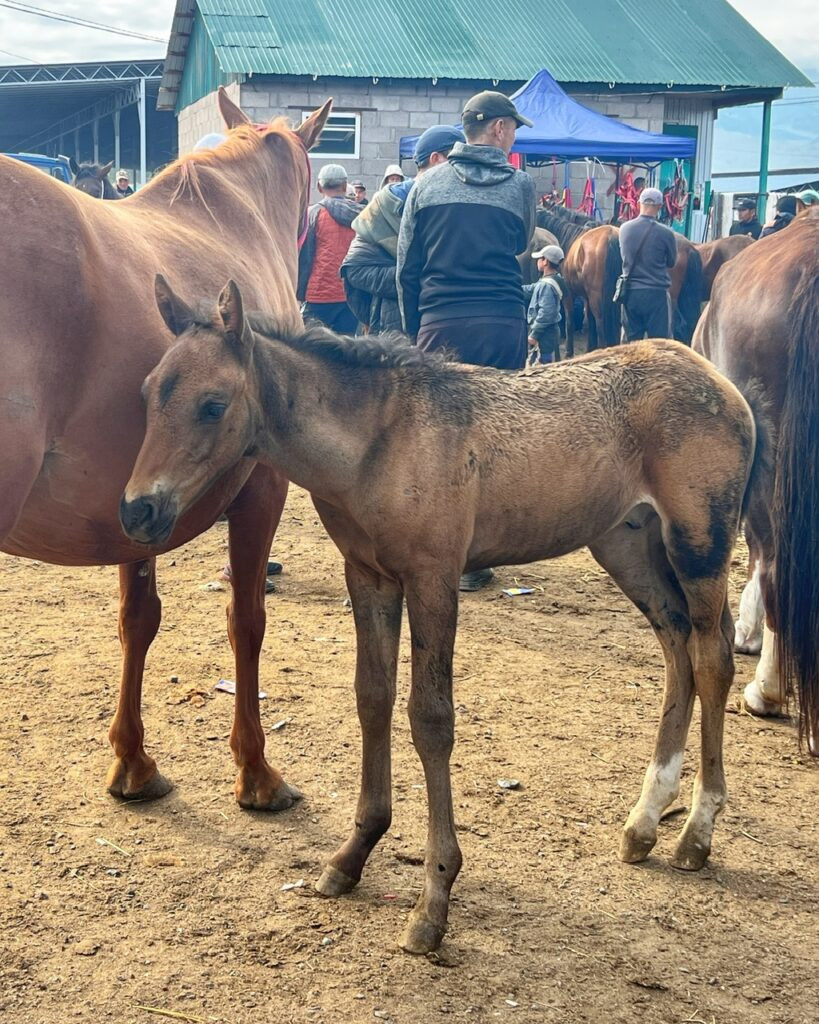
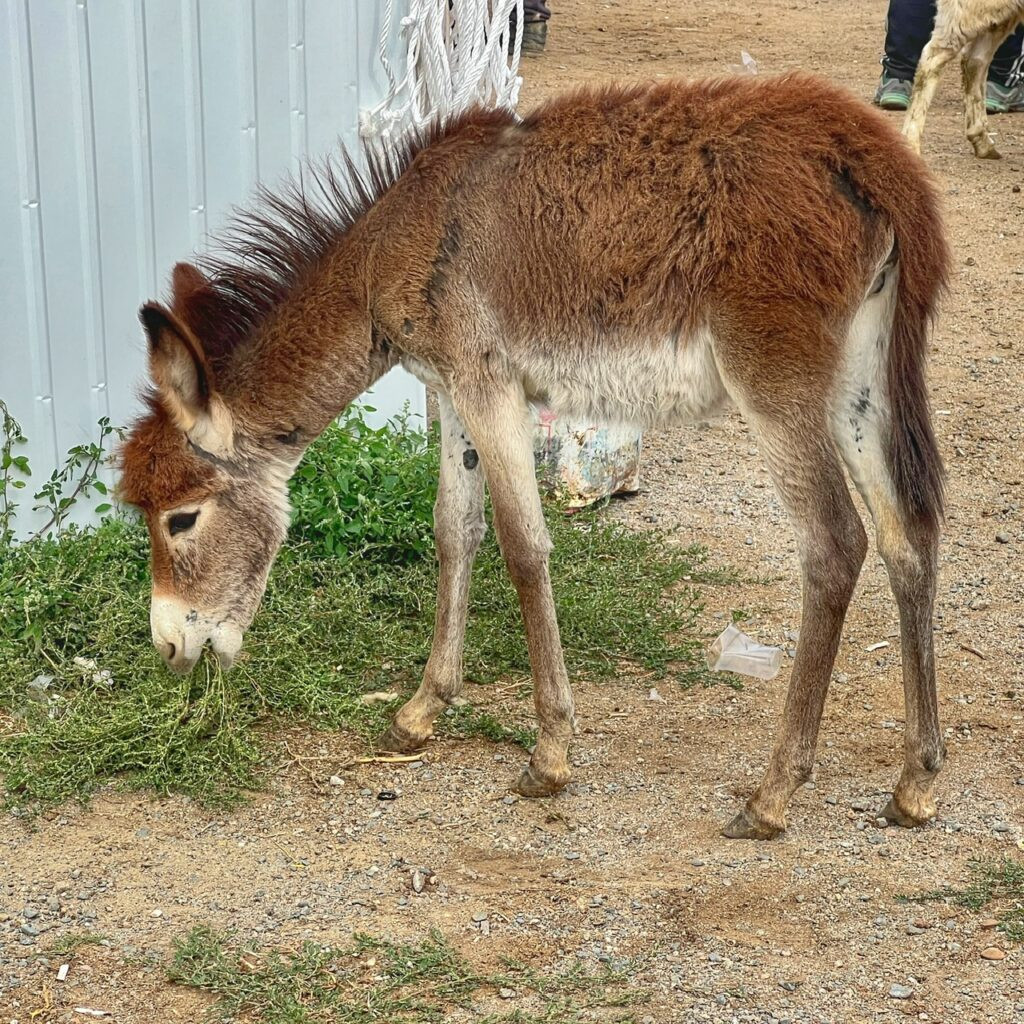
Awww. 🥰
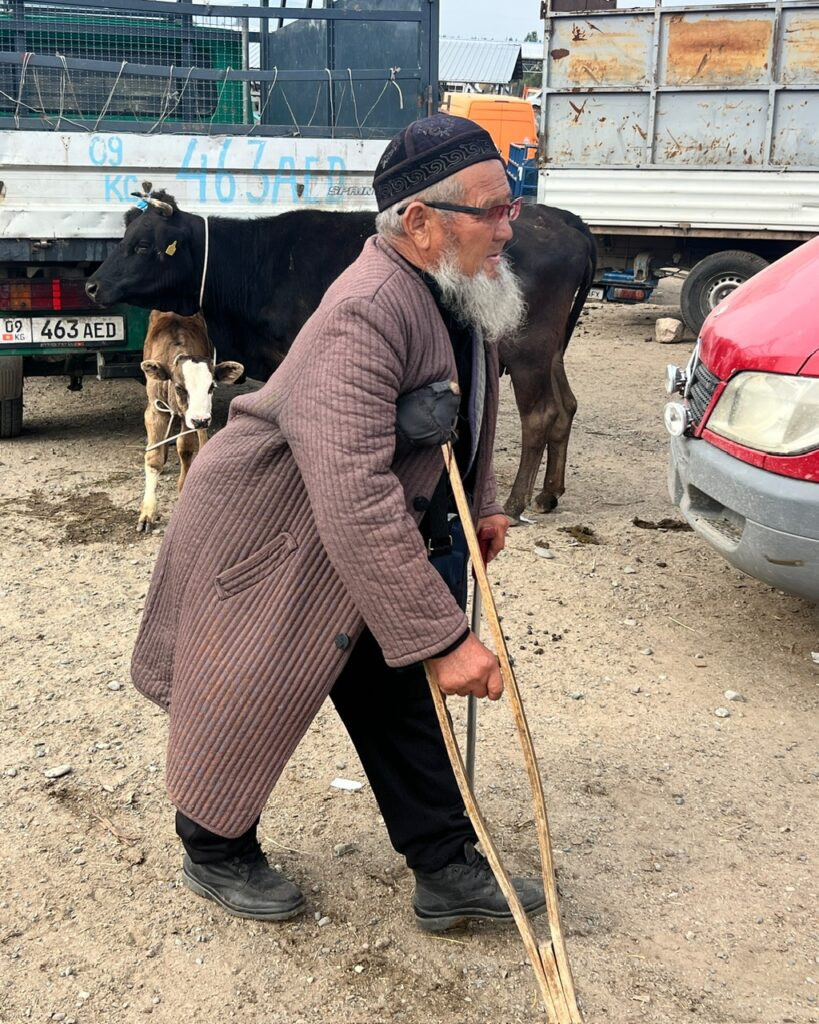
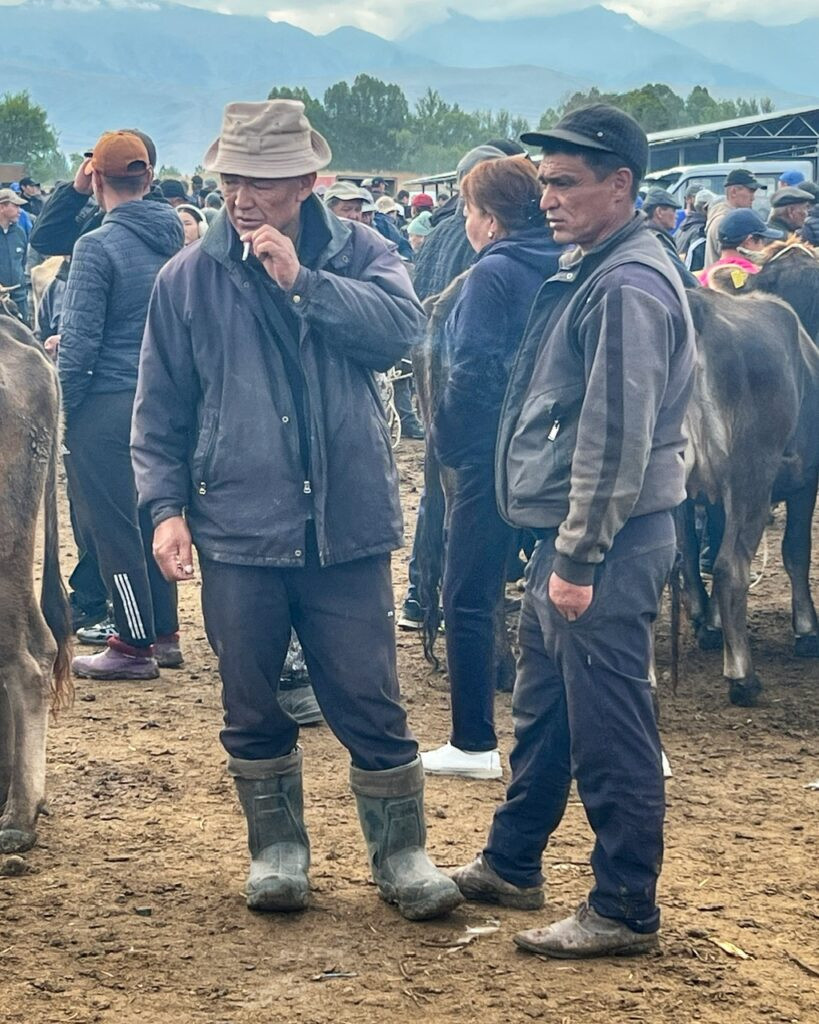

The weathered faces were real as well. It’s undoubtedly not an easy life in these harsh and mountainous winters where a lot of things simply do not grow.
Thirty minutes later was enough for us, and for our shoes, which had momentarily been freshly cleaned after the trek. Oh well. 😂 Alongside our friend Jonathan, we caught the 101 Marshrutka back to the city for about $.23/each. What an unorthodox way to spend a Sunday morning…at least for us….
Ak-Suu Hot Springs
Another must-do activity in Karakol is satiating your aching hiking muscles by plopping into a piping thermal pool, which are dropped in multiple places throughout the area. We chose Ak-Suu Hot Springs, which smoothed those muscles out like butter, and provided a gorgeous and clean mountain and river setting, all for about $4.50/each, including a locker.

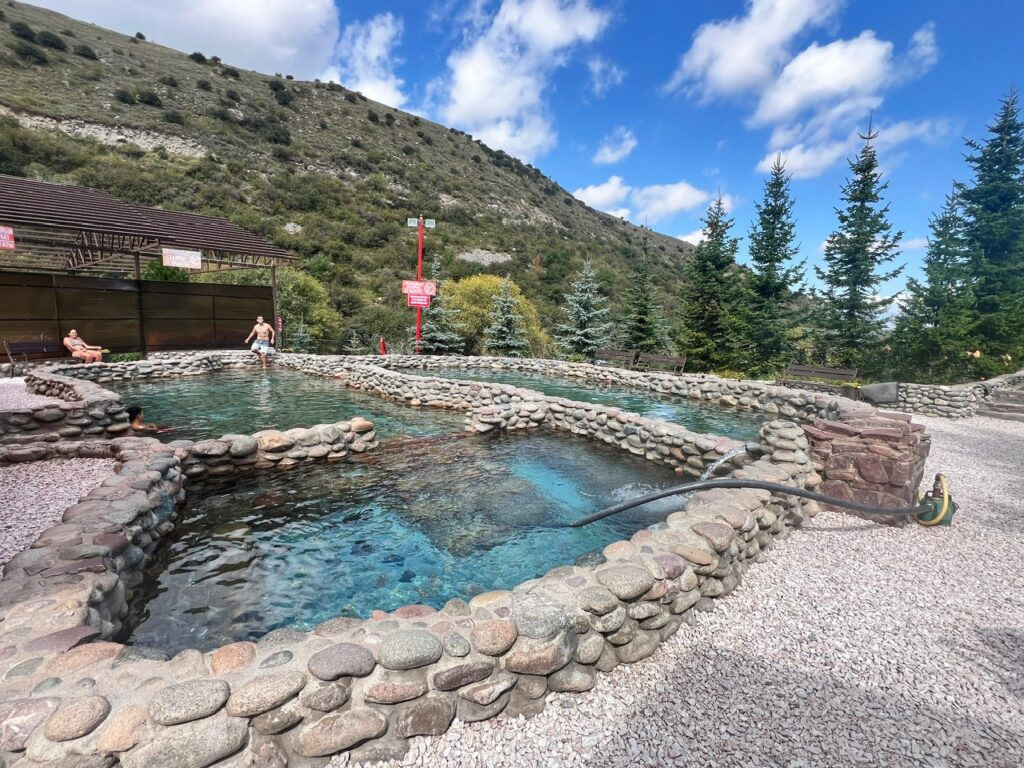
The facility has four pools. Considerately, one of them is for children, so they can keep the additional natural ingredients they contribute, corralled. The other three pools are for the big people at varying temperature levels.
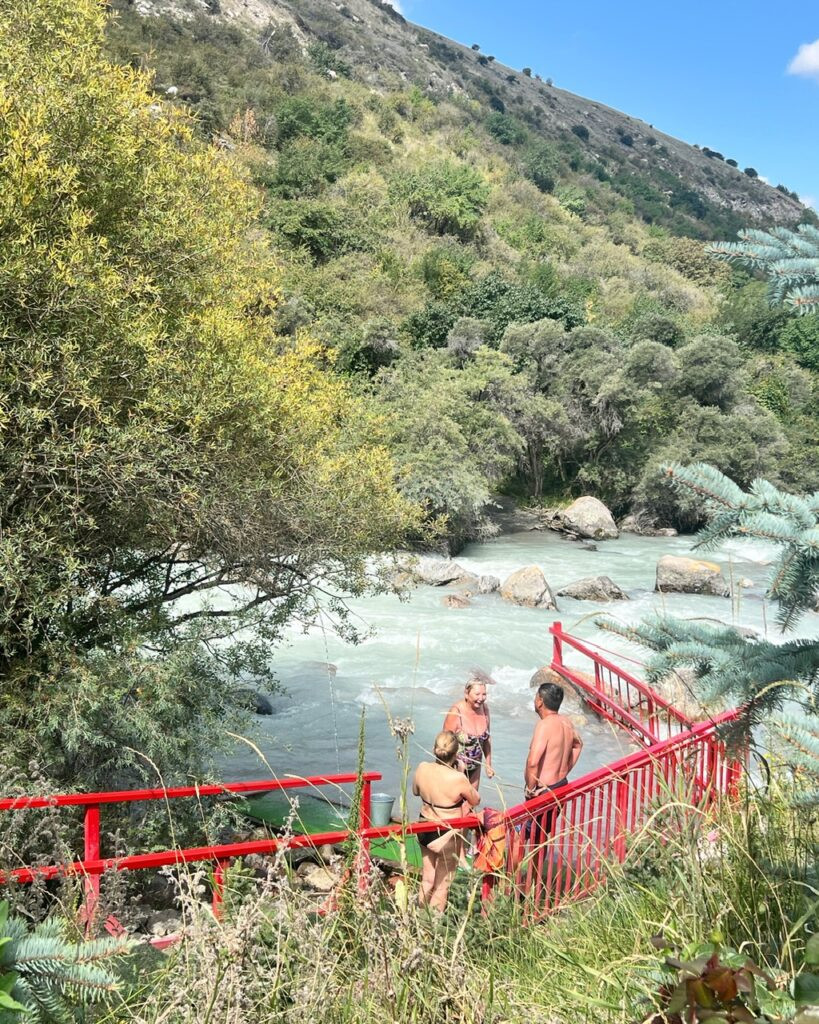
You will also have the opportunity take a plunge directly in the frigid river water, which is a fantastic, and refreshing way to contrast the heat.
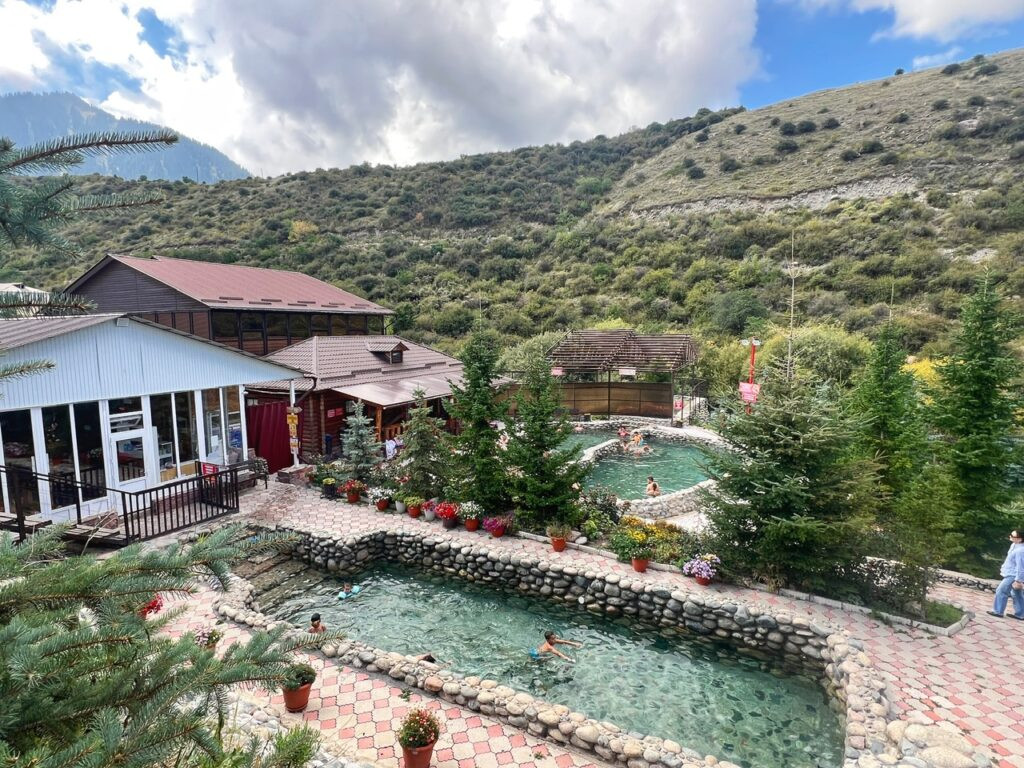
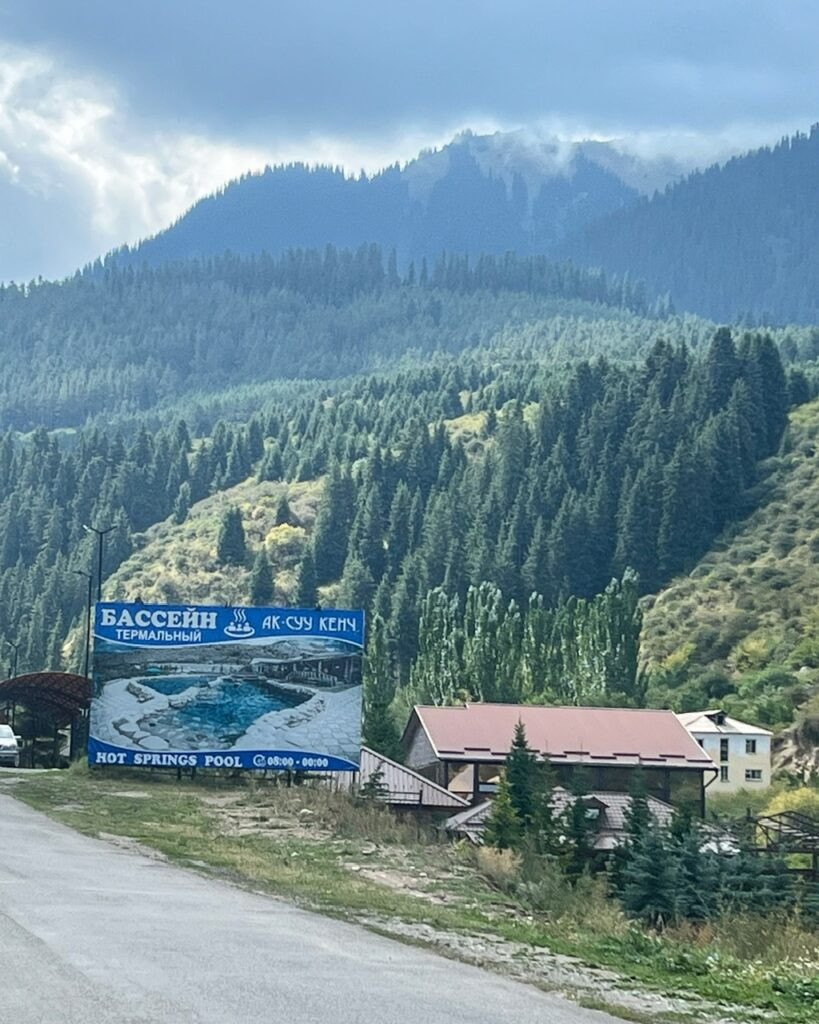
It started to get busier at around 11:00 so we recommend coming early! After we had a soak, we did some roaming up the red trail towards Altyn Arashan and eventually rejected our original plan of walking the 4.5 hours back to Karakol. It was a hot day and it really just didn’t sound appealing, but there is an option which supposedly takes you through a lovely arboretum. Instead, we ambled in the valley and checked out the many unusual plants growing everywhere.

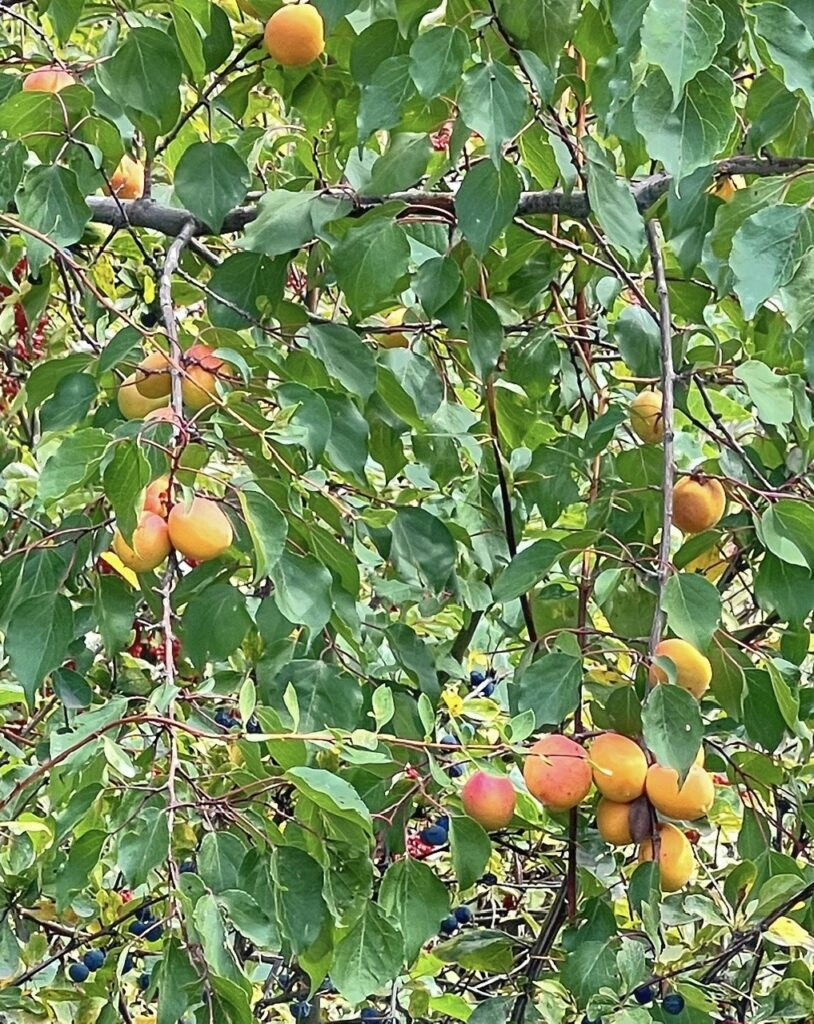
In fact, pictured here is a berry you’ve probably never heard of called Sea Buckthorn Berries. These grow throughout Central Asia and in the Himalayas and are extremely high in Vitamin C, Vitamin E and antioxidants. They also contain a high level of omega fatty acids! Wow. A superfood indeed!
It was our first encounter, so we decided to toss a few in our mouth…which was quite mouth puckering. I guess this is why they’re usually made into juice, tea or jams rather than eaten raw! 🤣
Another spherical orange delight we found was apricots, which were so succulent and juicy they tasted like “Peachy O’s” candies. Now that you definitely can’t find every day! While in this area, we also scavenged cherries, plums and apples making it a quite fruity day.

From the point in the road where the red trail splits off and Ak-Suu goes further off the opposite road, we found a proper bus stop, which is where we waited for the 350 marshrutka to ferry us 30-minutes back to Karakol. This ended up costing $1.72 for both of us, round trip…a remarkable value though it took a bit of effort to figure out the systems.
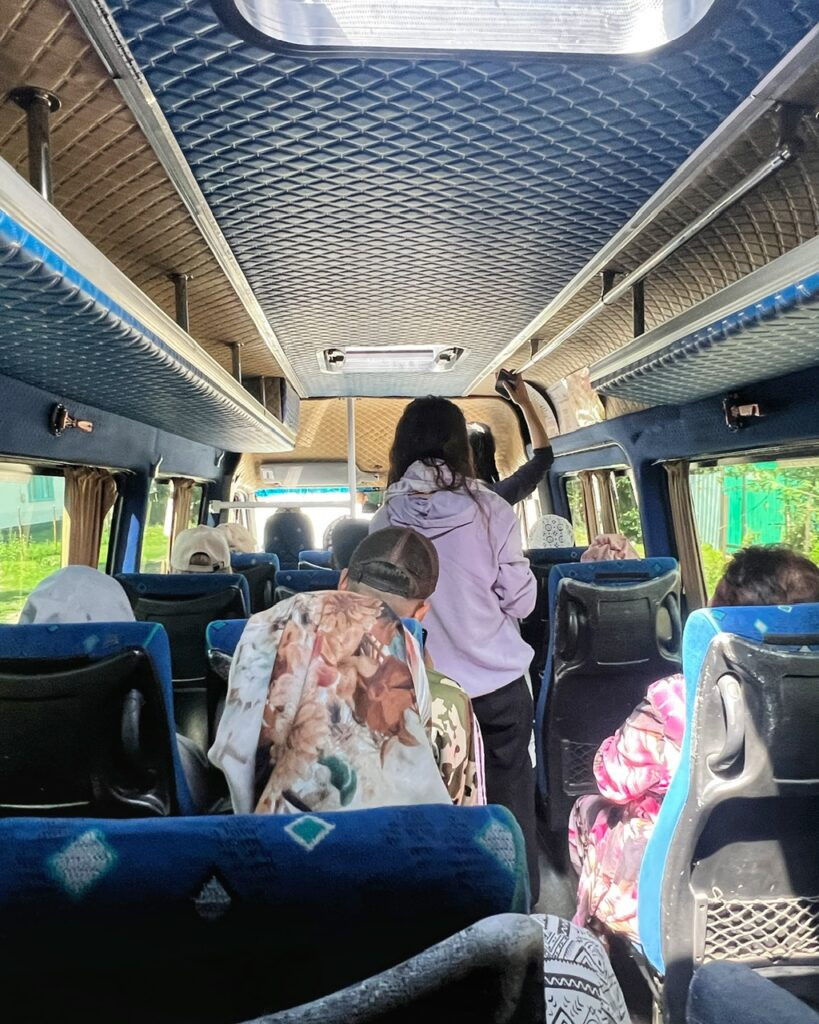
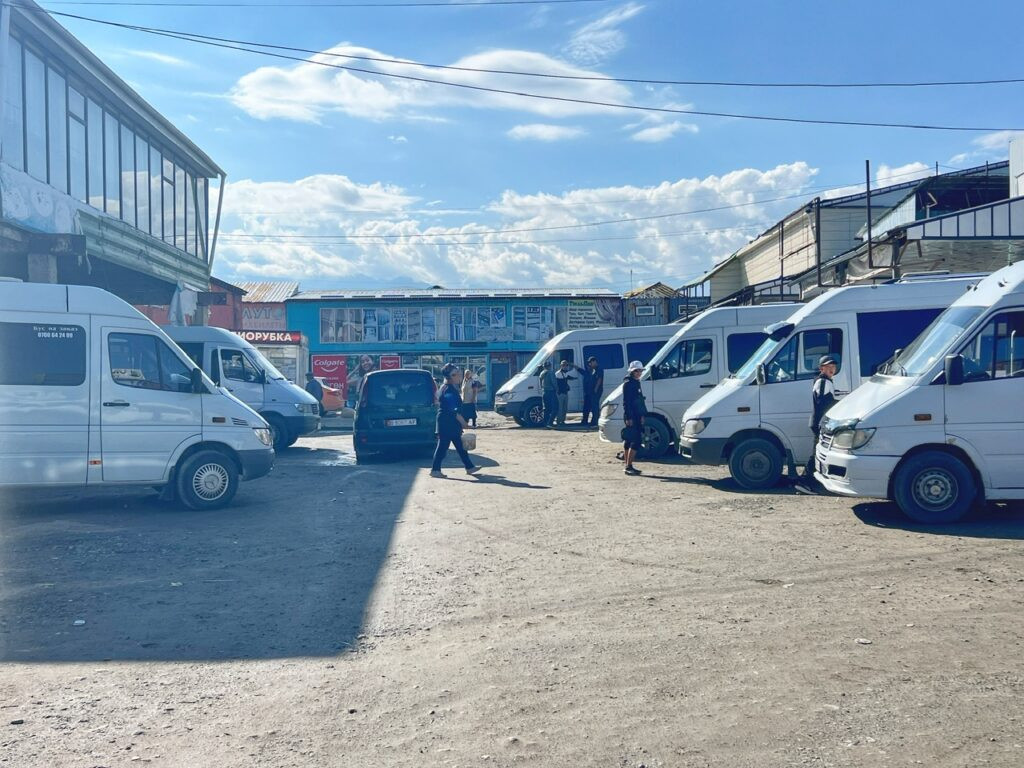
On the way back, we sat next to an endearing ten-year-old, who spoke several words of English, and had apparently been sent from Karakol to fill up three 6-liter jugs of healing thermal water for her family. We couldn’t believe the haul she was carrying all by herself.
The local marshrutkas in Karakol can be found at the “Ak-Tilek Bazaar Bus Station” which is surprisingly packed with options for moving throughout the region. They are a fun way to move about, and we couldn’t recommend them more for a local experience!
Our Daily Life in Karakol
Our two weeks in Kyrgyzstan’s mountainous adventure capital had wrapped. While we found it’s not the most charming town by a long shot, it was a terrific place to be stationed while immersing ourselves in the Tian Shan Mountains, and living in a pleasant apartment with comfortable nearby amenities and blissful weather, especially for August.
Here’s a look into our daily life in Karakol…


We lived adjacent to a traffic circle, (whose noise was surprisingly shielded by uber-effective windows), which had a colossal flag of Kyrgyzstan thrust in its center. According to information found on Chat GPT, the red background stands for bravery, valor, and the historic courage of the Kyrgyz people. It also recalls the legendary national hero Manas, who is said to have united the Kyrgyz tribes under a red banner.
The yellow sun with 40 rays represents peace and prosperity. The 40 rays symbolize the 40 tribes that were united by Manas into a single nation.
The Tunduk (yurt roof) inside the sun represents home, family, and the interconnectedness of the universe. It’s also a powerful emblem of national identity and traditional nomadic culture.
Also, we met a group of friendly kids chillin’ in parked golf carts. These seemed to be for sale. (the golf carts, not the children.)
One thing we noticed very quickly here, is that Kyrgyz children seem to have a lot of fun and are often approach you. They are rarely attached to devices and play outside in large quantities throughout the day.
Their games consisted of traditional things like soccer, but also we observed some legit creativity, like a group of 6-8 year olds sitting around on the grass “playing poker,” with wads of 500 som notes. Since 500 som notes are valued at over $5, we’re guessing this was play money? 🤣
We also saw a cluster of 5-7 year old girls who had drawn all over their faces, most likely with mom’s eye pencil. When I looked at them pointed and giggled, they exploded with laughter and started running around us in circles.
They make really cute kids in Kyrgyzstan.
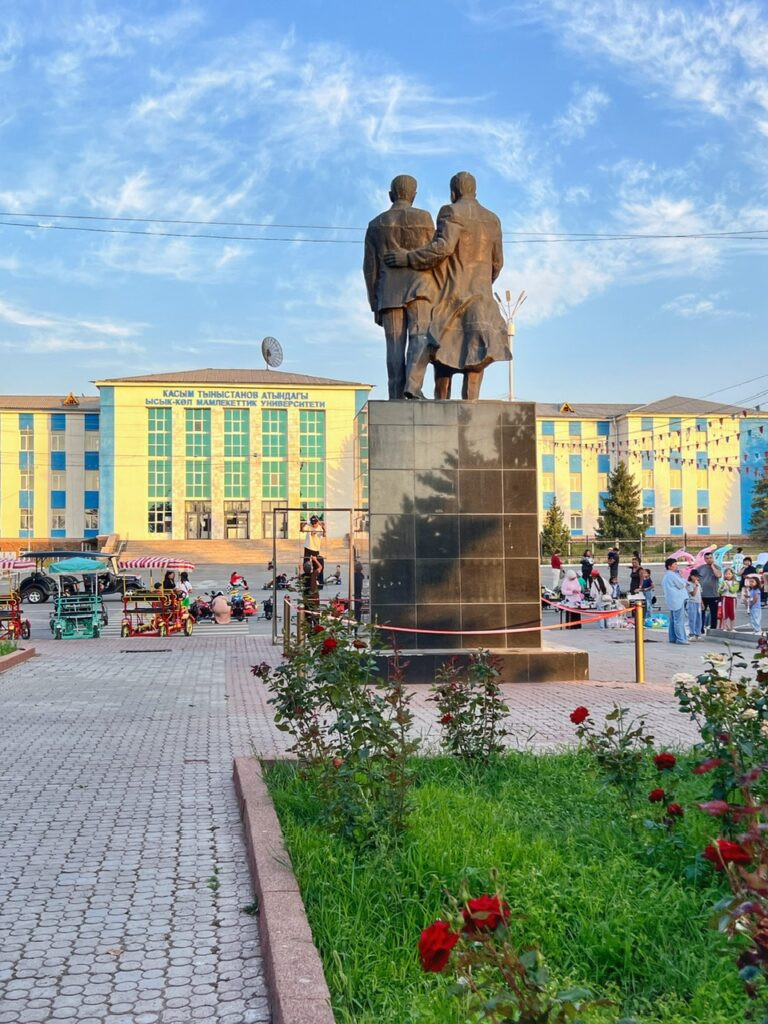
In front of the university is one of the main squares in Karakol. It was loaded with a chummy-looking statue, locals eating ice cream, and tiny licenseless humans driving around tiny cars WHILE eating ice cream. Uh…shouldn’t that be illegal?!

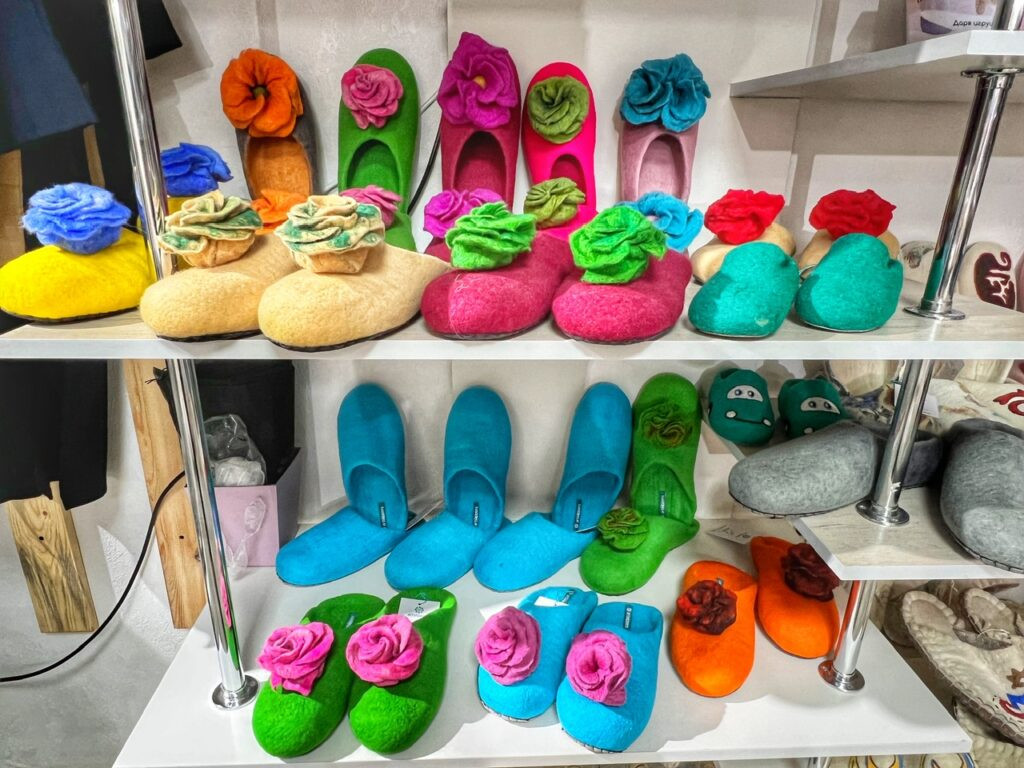
Of course, we also had to check out a few souvenir shops which, in this part of the world, involves trying on funny hats. Slippers are also a popular souvenir, but since our life involves a two pair maximum, the brightly colored wool design plastered with flamboyant flowers didn’t seem very practical?

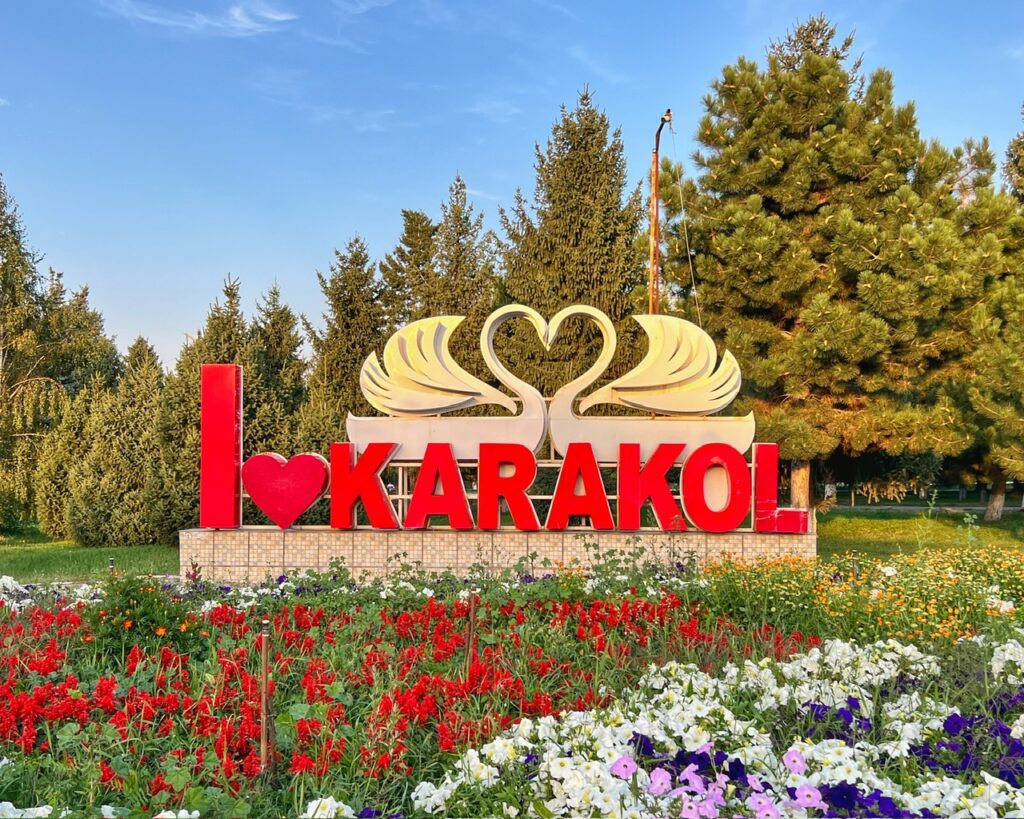
The permanent carousel featuring the earth’s favorite extinct reptiles. It’s only natural that horses are a bit bland to kids from this part of the world?! The token “I heart,” sign interestingly in Latin letters.

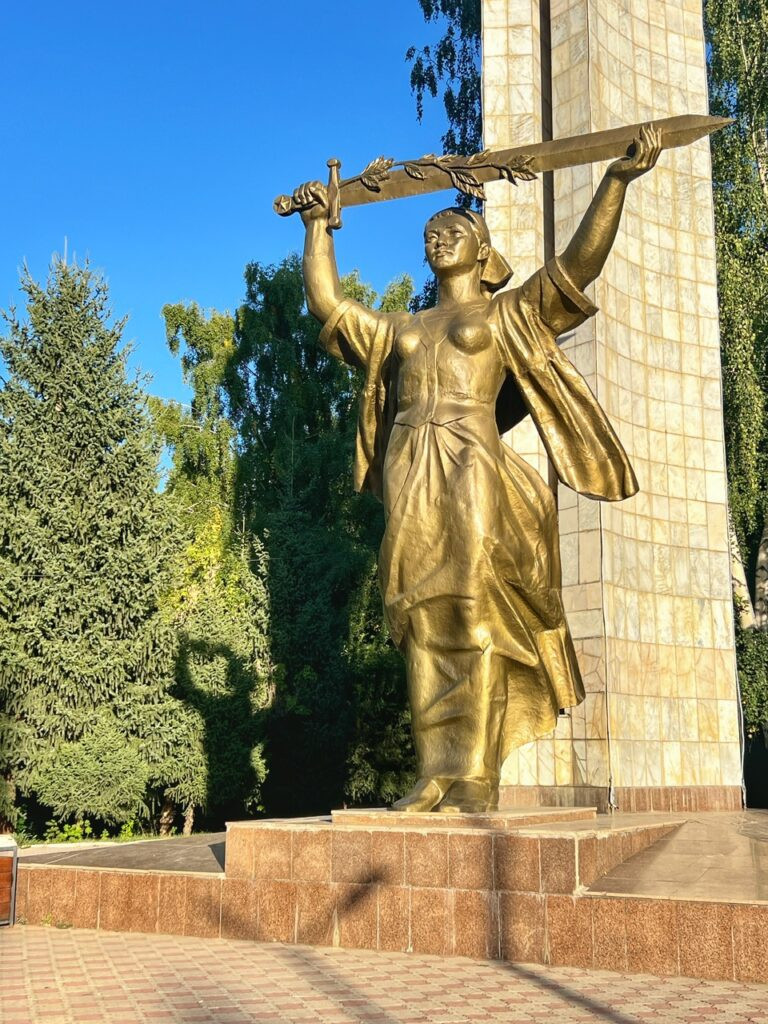
Another statue, this one alongside a disproportionately diminutive flag and with perfectly coiffed hair.
In addition, in a sea of male statues, this face at the World War II Memorial at Victory Park stands out. She represents the Motherland, and is holding up a sword, which is both a symbol of victory and a reminder of the sacrifices made.

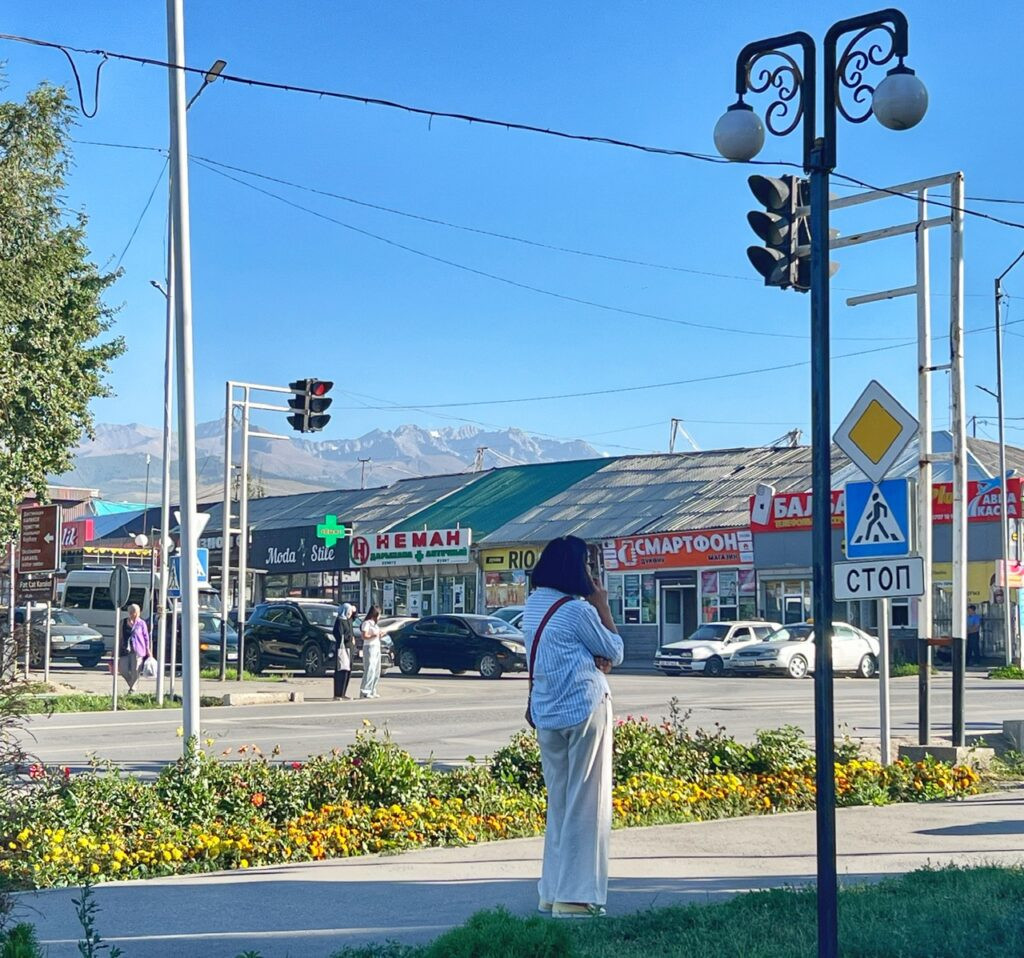
Along one of the main food streets in Karakol, you could find many options for Muslim diners. The commercial streets were always buzzing with activity.


Further afield, we meandered into the residential neighborhoods, where characteristic houses line the streets, and not typical Soviet-style bloc buildings.
The houses truly capture time constructed with visible splotches of mud, straw and wood. Interestingly, this one is also tuned into the GOSPELL.🤣
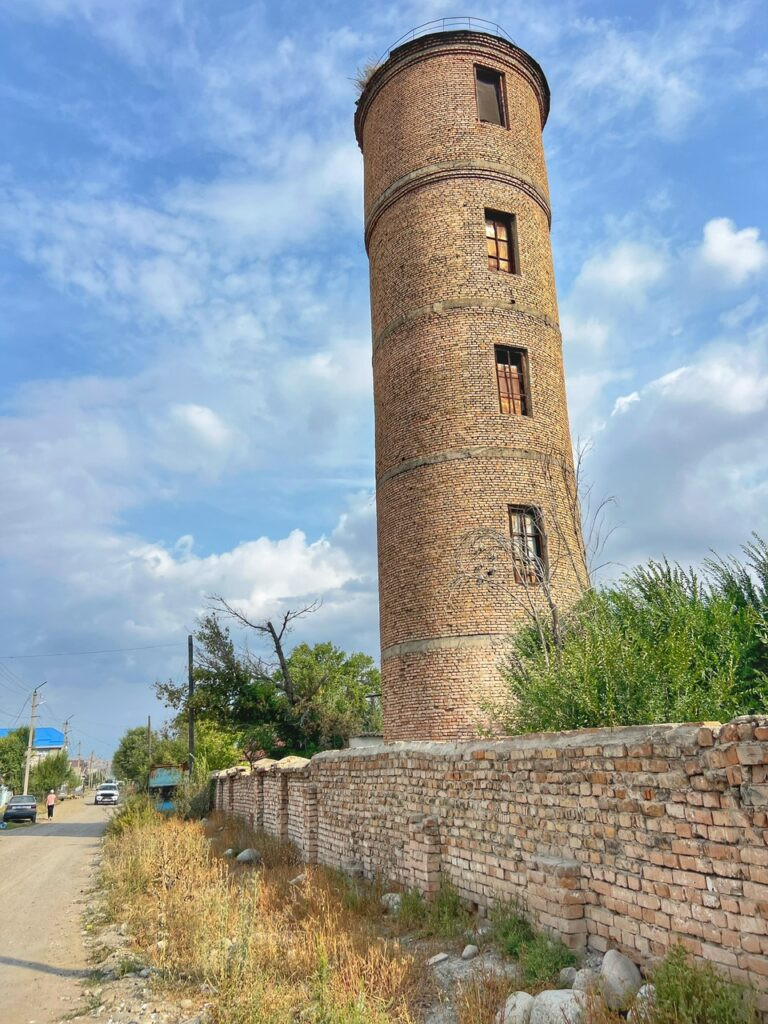
This is the Soviet’s version of a water tower…dated from around the 1930s–1940s. It is no longer in use for water storage but remains standing as a local landmark. Looks like it has unique Airbnb potential written all over it? Speaking of water, while in Karakol we were surprisingly able to use a filtered pitcher to drink straight from the tap.
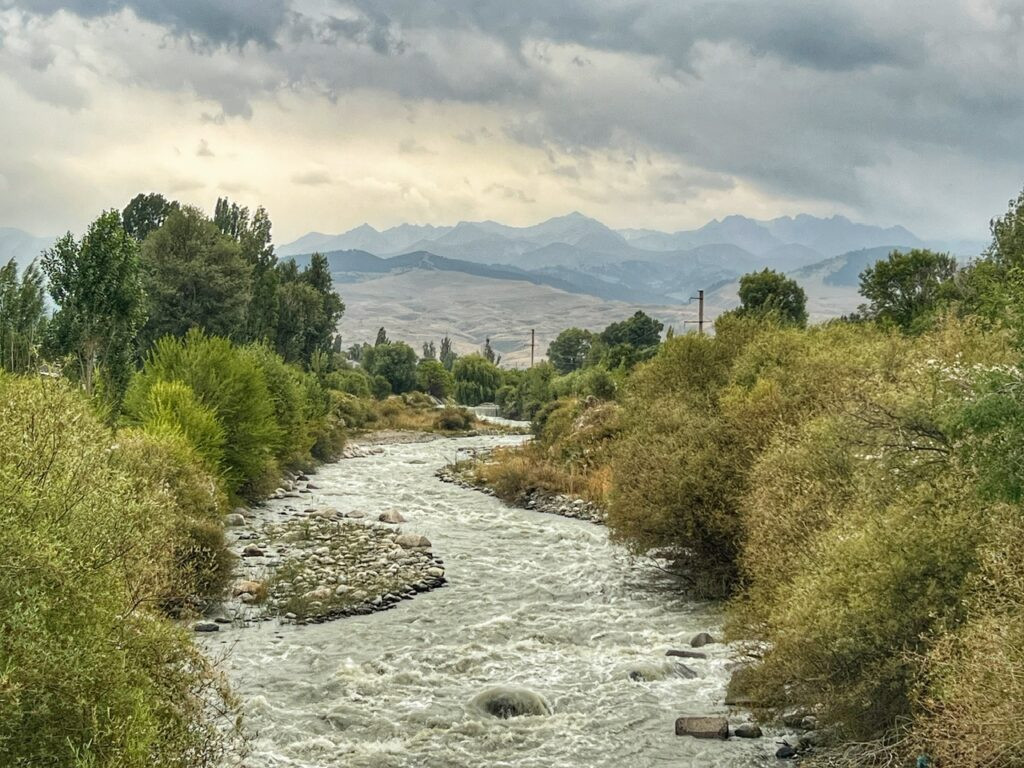

A view of the river and the Tian Shan Mountains. The residents of Karakol also planted some radiant flowers gardens.
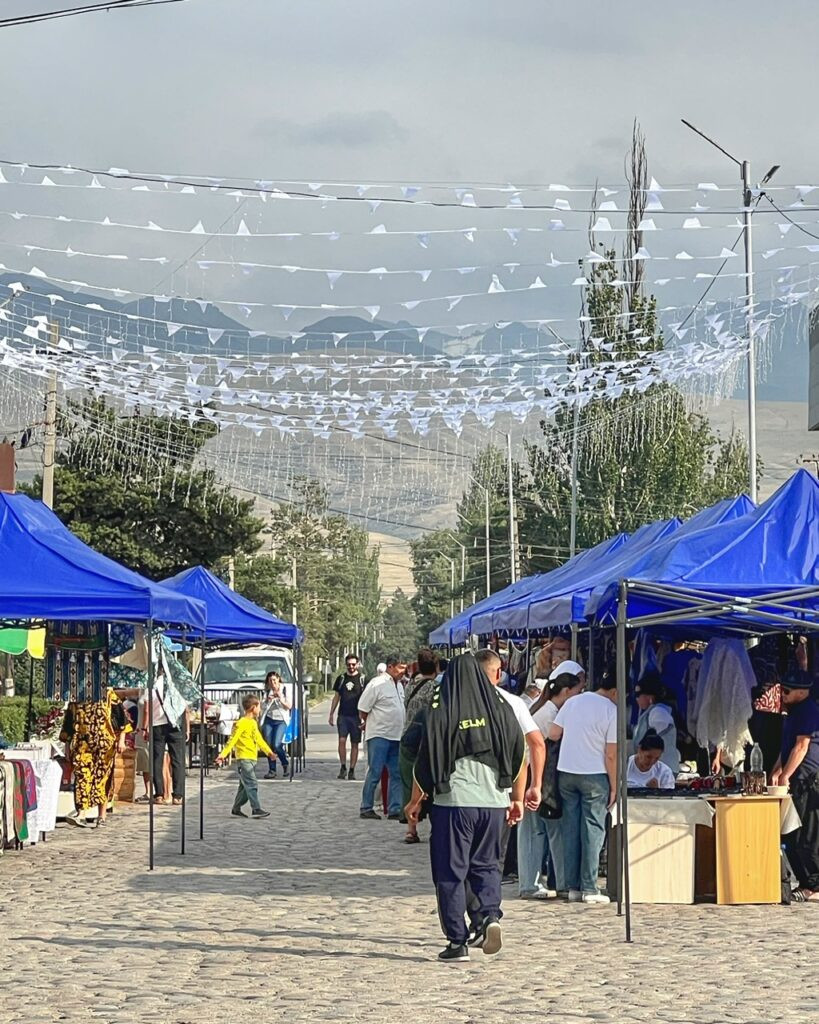
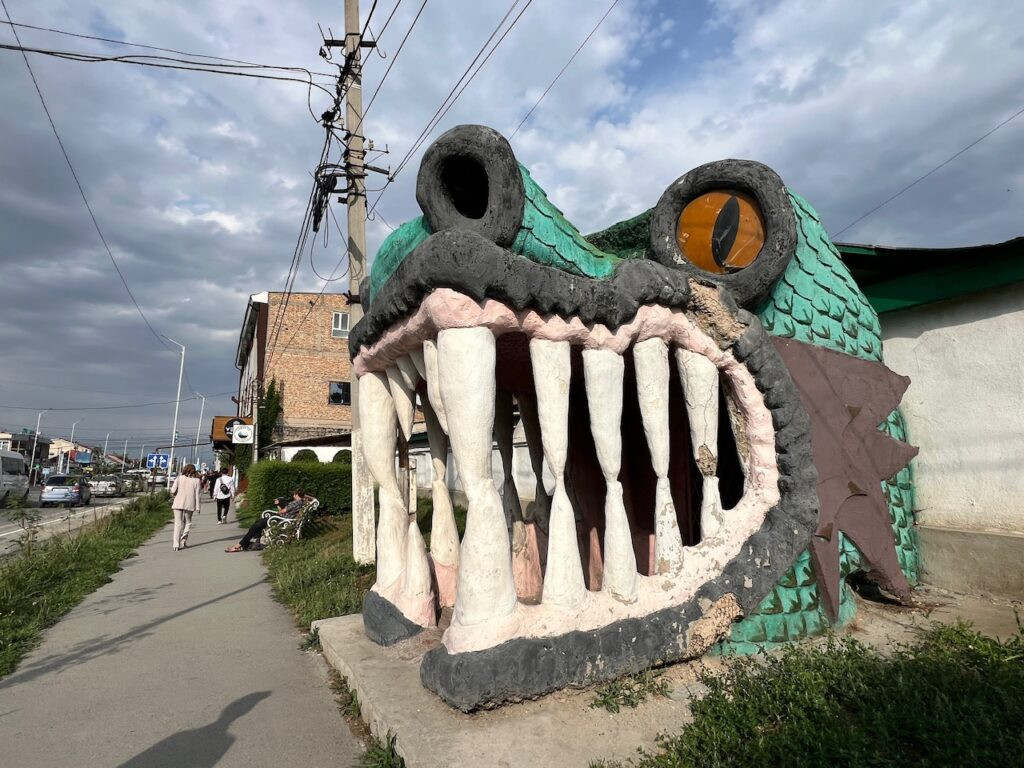
An evening pop-up street market, which disappointedly focused more on goods than foods. Also disappointed? This guy. He’s clearly hungry.
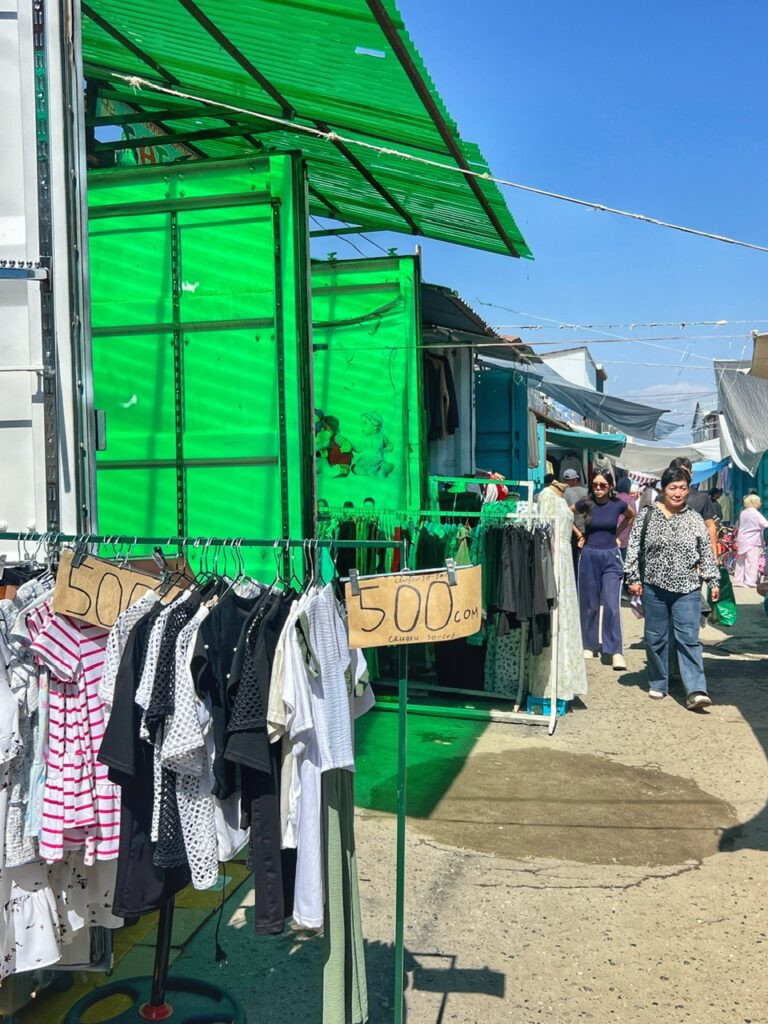
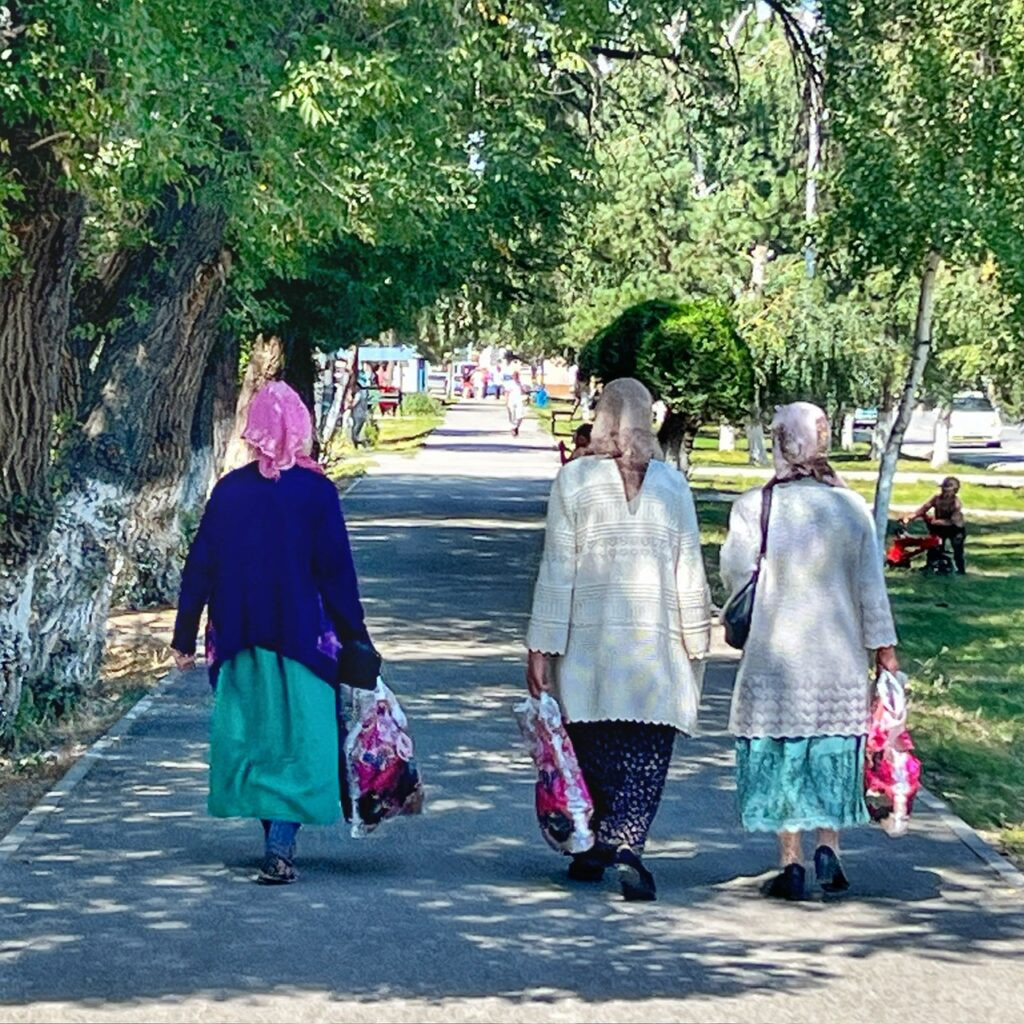
The daily market, however, at Aktilek Bazaar had a bit of everything. And most of it was creatively housed inside shipping containers.
A trio of Basbushkas after a wild morning out on the town. They are heading back to the security posts that are their apartment balconies.
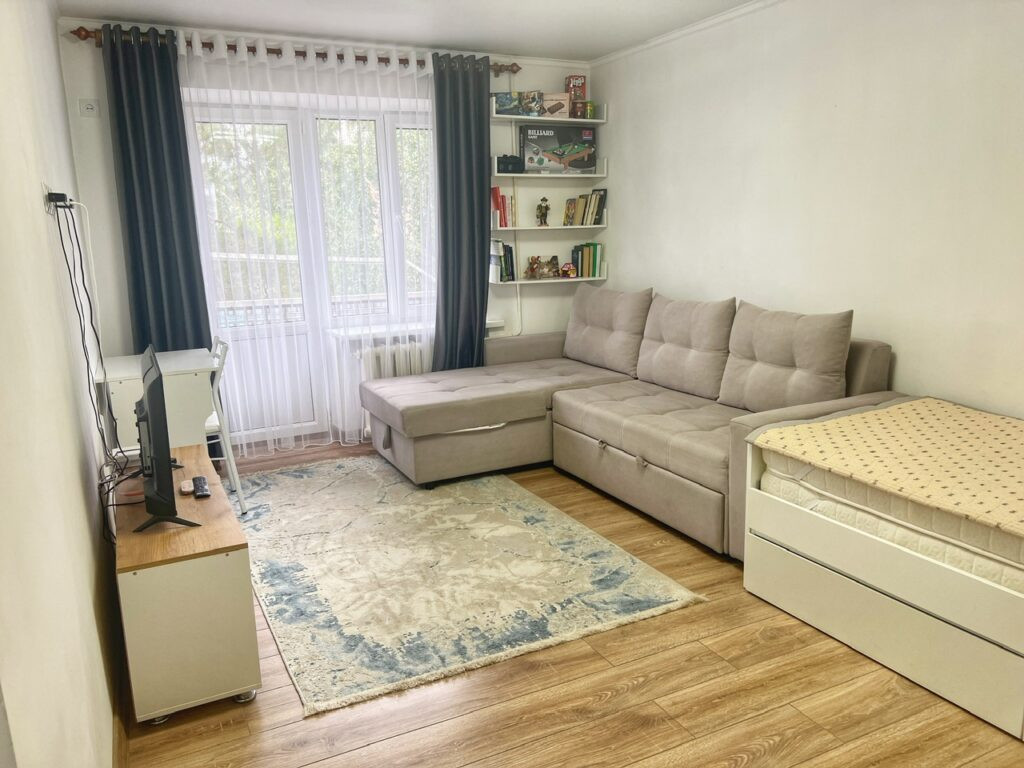
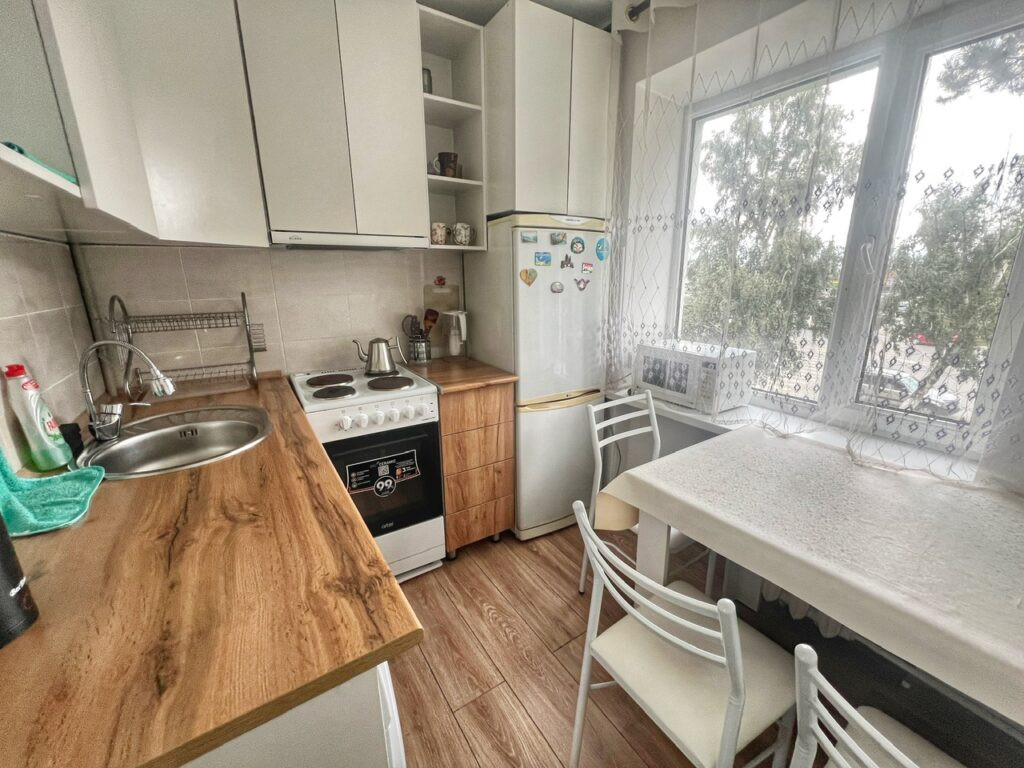
Speaking of apartment balconies, we too had one, but it was only big enough for drying clothes. Good thing, because we didn’t have the weathered credentials to play neighborhood watch ladies.
The inside of our apartment was plenty big, however, and we were gifted a giant couch, a comfortable pullout hide-a-bed and even a yoga mat. We booked it several months in advance, as it was only one of few apartments that fit our needs and budgets in the city on Airbnb. ($24/night)


Our full sized kitchen, and a bathroom with a brilliant barrier around the shower. It’s the little things that make us ecstatic after months in Bulgaria!! 🤣
It still had lots of Soviet character, however, including orange and green splashes to accentuate the concrete stairs, and four downright different door designs from which one could enter. I guess we were pretty fancy, because we also got the most extravagant-looking door on floor 2?
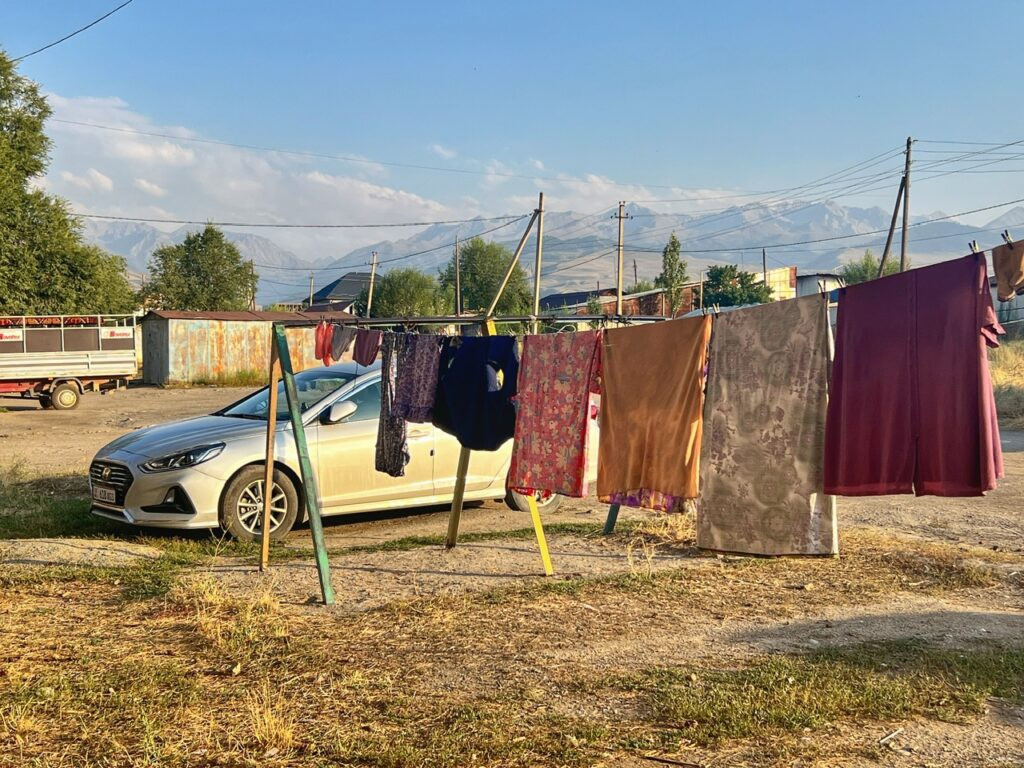
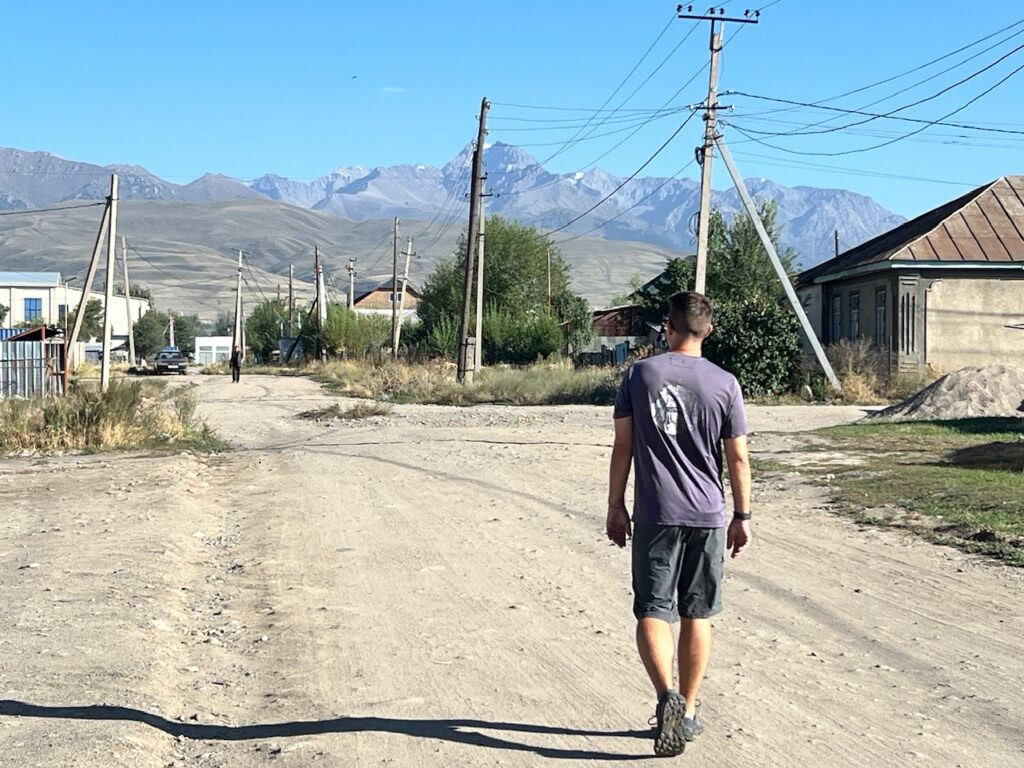
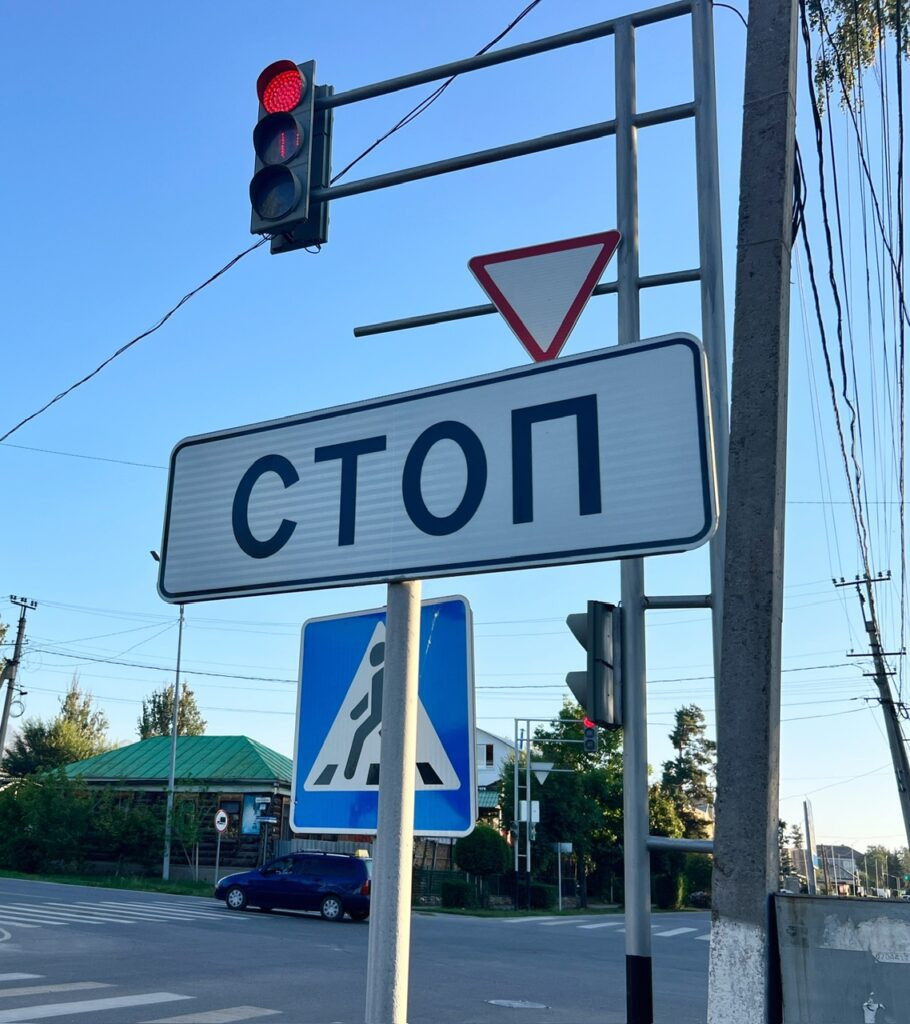
The backyard of the block where others strung their clothes, parked their cars, and sat around on benches wearing funny hats.
It was here we headed out, which was always satisfying in Karakol. Not only because of the ring of mountains, but because of the sunny and idyllically perfect weather most days (70’sF/20sC). It was a quite good choice to land here for an extended time in August when the rest of the Stan’s were baking.
By the way, there are no universally red octagonal signs necessary here! STOP. It’s time to move on….

